CHAPTER 6
ARTEFACT ANALYSIS
Archaeological excavations at Chinaman’s Point were conducted to obtain a representative sample of the material remains at the site. Through these remains information was sought on the methods the Chinese fish curers used to sustain a livelihood, the domestic and industrial equipment required, their living conditions, consumption patterns and recreational activities.
The excavated areas revealed a mix of industrial and domestic artefacts, although different areas of activity were apparent through artefact types and distribution densities. The recovered artefacts include deliberately discarded and accidentally lost industrial and domestic items. While some were located in a simple, single, in situ ground layer; others had eroded from ground layers of the site through wave action and been deposited within the site’s tidal zone. None of the domestic remains could be directly connected to individual site occupants – known through historical documents – and therefore no attempt has been made to compare and contrast domestic artefacts to ascertain individual ownership or distinguish the roles of individuals.
As this research is the first of its kind in Australia, the industrial components from Chinaman’s Point cannot be compared or contrasted with a similar body of material remains. Therefore, for the purpose of this research, the industrial remains from Chinaman’s Point will be considered a standard collection of artefacts for a colonial Australian Chinese fish-curing site. The domestic artefact types from Chinaman’s Point were found to be consistent with Australian colonial-period urban and rural overseas Chinese sites, enabling a good level of comparative analysis. The site’s small size and isolation assists to provide a snapshot of a Chinese community in colonial Australia separate (but interlinked) to the overseas Chinese mining industry.
ARTEFACT COLLECTORS
With the erosion of the bank at Chinaman’s Point described in chapter 5 and the subsequent depositing of artefacts onto the tidal zone, thousands of artefacts became exposed to artefact collectors. People also retrieved artefacts by digging at the banks of the site. A walk through the residential streets of Port Albert reveals a myriad of Chinese style artefacts prominently displayed in kitchen and living room windows and in one case, hanging from a front-yard sculpture. Unusual looking objects, unbroken items and artefacts displaying Chinese characters would likely have been the first pieces collected. This is reflected in the poor representation of these artefact types recovered archaeologically from Chinaman’s Point. Artefact collecting at Chinaman’s Point has resulted in the loss of much scientific information and has made site interpretation difficult, especially in terms of estimating site population and gaining an understanding of how prolific certain industrial, domestic and recreational activities may have been.
ANALYSIS METHODOLOGY
The artefact classification system devised for this project is based partly on the very adaptable historical artefact management tools presented in The Canada Parks Service Classification System for Historical Collections (1992) and partly on the artefact typology guide in Orser (1988: 233). To further aid in developing an appropriate classification system and to describe and archaeologically interpret artefacts from the Chinaman’s Point site, a number of other artefact cataloguing and analysis guides were consulted, including South (1977), Sprague (1980–81), Davies & Buckley (1987), Orser (1989), Praetzellis & Praetzellis (1990), Adams & Adams (1991), Crook, Lawrence & Gibbs (2002), Casey (2004), Brooks (2005a; 2005b) and Crook (2005).
The artefact analysis aims to describe artefacts in a complete and organised manner, so that artefacts or groups of artefacts can be broken into variables that permit both a detailed analysis of the artefact assemblage – such as an individual tools usage or a description of fishing methods – and broad analysis – such as site demographics, activity areas or structural layout. The analysis also aims to identify artefacts of significance for more comprehensive examination. This will facilitate an understanding of the broader social and cultural framework of the assemblage and assist in an understanding of the people at Chinaman’s Point.
The artefact classification system is broadly functional, concentrating mainly on material and form (rather than a fabric-based analysis) to interpret primary original artefact use. Detailed examinations of artefact attributes, manufacturing technologies and post-manufacture modifications have also in some cases been used to determine site occupation periods and possible artefact re-use functions (i.e. when artefacts were used other 88than for their original purpose). To identify the artefacts from Chinaman’s Point, seven functional artefact categories are defined, each of which includes a number of more narrow sub-categories.
The categories are:
- Architectural/Structural. Artefacts originally created for the purpose of constructing dwellings or site features. Sub-category: fastener and construction material.
- Domestic. Artefacts originally created for the purpose of procurement, preparation and service of daily human food requirements and personal comfort. Sub-category: cooking, food, food storage, furnishing, liquid storage and tableware.
- Industrial. Artefacts originally created for the purpose of procuring and processing marine resources. Sub-category: fishing, recording, slag, tools.
- Personal: artefacts originally created for individual human use such as clothing and associated objects. Sub-category: button.
- Recreational. Artefacts originally created for individual or group enjoyment. Sub-category: opium smoking.
- Unidentified. Artefacts originally or subsequently created to serve a purpose that cannot now be determined. Sub-category: unidentified artefacts.
Recovered artefacts were cleaned in the field and bulk-bagged with other artefacts of the same fabric, grid square and stratigraphical layer. Bulk bags were assigned a five part identification code e.g. CMP-4G-IXh-2-3, where CMP represents Chinaman’s Point, 4G the ten-by-ten metre grid square, IXh the one-by-one metre grid square, 2 the spit number and 3 the stratigraphical ground layer (figure 6.1). Bags were clearly labelled using waterproof, indelible, black pen (Artline Drawing System EK-238) on Tyvek waterproof labels. Complete or diagnostic items were separately bagged and tagged. Labels were placed inside artefact bags, or for objects such as bottles the labels were tied to the object with fine cotton string.
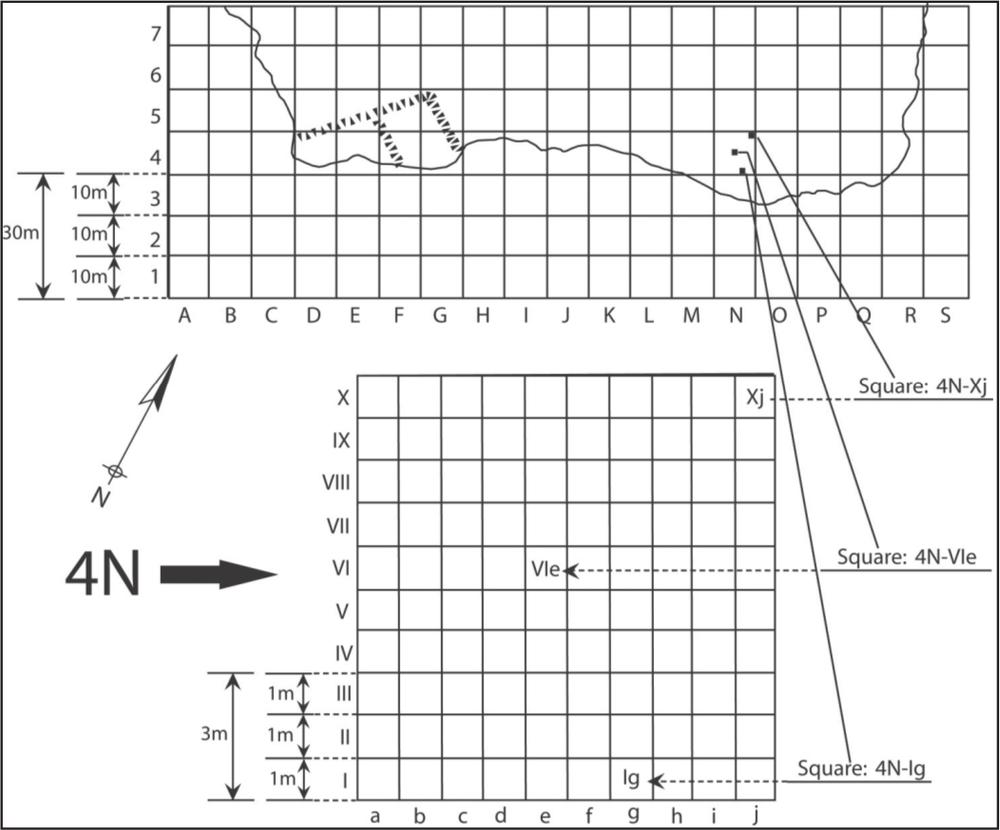
Figure 6.1 Site grid (top) and one-by-one metre breakdown (bottom) used for artefact province details.
Due to the site’s coastal environment, recovered artefacts had been impregnated by salt and required salt leaching. Under the direction of Heritage Victoria’s conservation department, artefacts were placed in synthetic mesh bags and immersed in fresh tap-water. Water was changed fortnightly from the time of recovery until the water the artefact was in had achieved a salt content reading of 20 parts per million or below. The final water change was conducted using purified water in which artefacts were submerged for another four-week period. Consequently, all artefacts were immersed in fresh water for approximately ten months. To ensure artefacts did not become damaged during transportation from the field and storage, plastic water-filled tubs were packed loosely with bagged artefacts and fitted with a strong lid. Wet polyethylene was used to cushion any loose and/or fragile artefacts.
Artefact cataloguing and analyses were conducted at La Trobe University’s archaeological laboratories. In the laboratory, each artefact was reassessed and assigned a new double-sided tag. This tag displays the grid square and stratigraphic layer on one side and a Chinaman’s Point accession catalogue number on the 89other side. After this was completed and conjoins between artefacts made where possible, all artefacts were placed in numbered archival Corflute boxes and submitted to Heritage Victoria’s conservation laboratory in Abbotsford, Melbourne, where some significant artefacts underwent further conservation treatment and others went into storage.
Artefact information has been recorded in an accession catalogue using a Microsoft Access database. Each database entry includes the artefact number, object, an artefact description, date range (where possible), quantity, weight, province, material, sub-material, function, sub-function, identity, significance (site and state) and the archival box number (figure 6.2). For consistency in catalogue entries, drop down tables were developed within the database according to category. To facilitate artefact identification and retrieval, the accession catalogue was designed to allow all artefact entries – besides the general description – to be searched in individual fields. This also enables artefact properties to be broken into variables for detailed and complex queries – such as only white ware ceramic rim fragments with 50 mm diameters or broad levels of analysis – such as all ceramic of a certain ware.
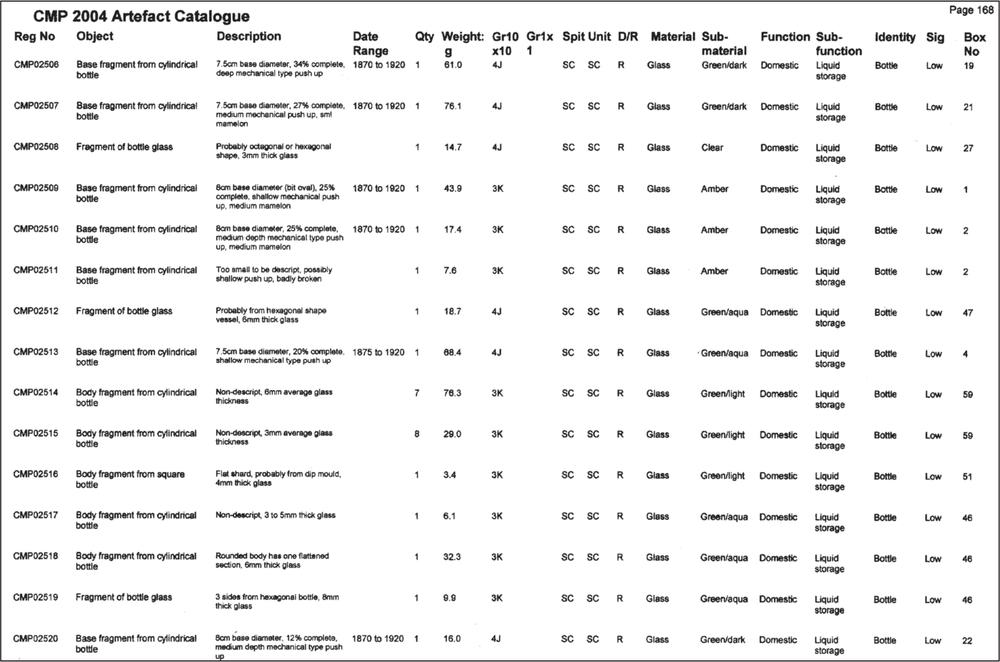
Figure 6.2 One-page example of the Chinaman’s Point artefact catalogue.
In total, 29 030 separate artefact fragments, weighing 234.655 kg and representing 6335 accession catalogue entries were recovered from the site. The majority of artefacts – 21 838 artefacts, weighing 211.479 kg – came from surface collections conducted on the tidal area of the site (the tidal zone). The remaining 7192 artefacts – weighing 23.176 kg – were excavated from sub-surface ground layers. Twelve separate artefact materials are present in the assemblage: bone, brass, ceramic, copper, ferrous metals, glass, lead, leather, mortar, shell, slate and wood. The term sherd is used in conjunction with ceramics fragments and the term shard is used when referring to glass fragments. A breakdown of artefact material types, numbers and weight is in table 6.1. Artefact densities can be seen in table 6.2. 90
| Materials | Number of artefact fragments | Weight (grams) |
|---|---|---|
| Bone | 56 | 560 |
| Brass | 2 | 17 |
| Ceramic | 3110 | 14 298 |
| Copper | 41 | 79 |
| Ferrous metal | 11 825 | 42 780 |
| Glass | 13 660 | 17 4872 |
| Lead | 29 | 589 |
| Leather | 2 | 5 |
| Mortar | 6 | 16 |
| Shell | 10 | 87 |
| Slate | 6 | 12 |
| Wood | 283 | 1340 |
| Total | 29 030 | 23 4655 |
Table 6.1 Breakdown of artefact material types, numbers and weight.
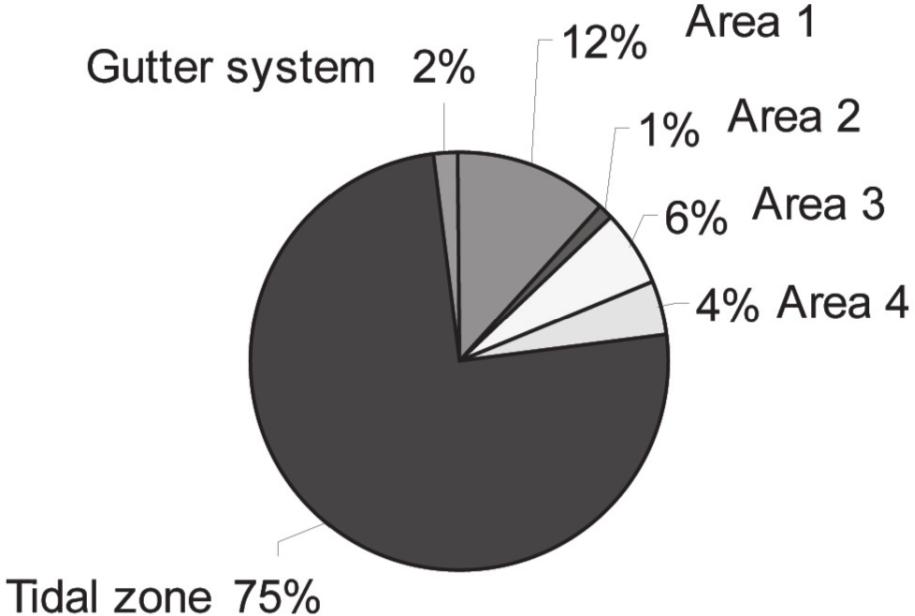
Table 6.2 Chinaman’s Point site artefact densities.
ARCHITECTURAL/STRUCTURAL
Fasteners
Nails were the dominant type of fastener recovered from Chinaman’s Point, although screws, spikes and washers were also found. Corrosion from the harsh marine environment hampered the identification and accurate sizing of many of the recovered nails. The largest nail size was approximately 75 mm long and 6 mm diameter – with diameter the most important determining factor. Smooth shaft ferrous metal fasteners exceeding these dimensions are classified as spikes. Two square shaft tack nails were recovered from the tidal zone, both approximately 25 mm long; one has a two facet chisel point and the other a four facet point. Two 25 mm diameter, machine-made, lead washers were also located in the tidal zone and could be associated with either boat maintenance or roofing nails.
Due to high levels of corrosion, some ferrous metal artefacts were deemed to have little or no archaeological value. It would be impractical to conserve and retain such artefacts. A sampling strategy that involved identifying and retaining the least corroded and most archaeologically informative pieces was employed to deal with the unidentifiable heavily corroded material. This resulted in a retention rate of approximately eight percent of metals. A percentage breakdown of retained and discarded metals can be seen in table 6.3. 91
| Metal form | Number of artefact fragments | Weight (grams) | Percentage |
|---|---|---|---|
| Nail | 319 | 1107 | 100 |
| Nail (retained) | 21 | 104 | 6.6 |
| Nail (discarded) | 298 | 1003 | 93.4 |
| Spike | 59 | 2992 | 100 |
| Spike (retained) | 7 | 557 | 11.9 |
| Spike (discarded) | 52 | 2435 | 88.1 |
| Screw | 8 | 103 | 100 |
| Rivet | 62 | 2231 | 100 |
| Rivet (retained) | 27 | 978 | 43.5 |
| Rivet (discarded) | 35 | 1253 | 56.5 |
| Cask strap | 2056 | 13 100 | 100 |
| Cask (retained) | 44 | 1016 | 2.1 |
| Cask (discarded) | 2012 | 12 084 | 97.9 |
| Cooking pot | 107 | 5440 | 100 |
| Drum plug | 65 | 122 | 100 |
| Drum rim | 20 | 113 | 100 |
| Lead | 29 | 589 | 100 |
| Slag | 279 | 754 | 100 |
| Slag (retained) | 4 | 14 | 1.4 |
| Slag (discarded) | 275 | 740 | 98.6 |
| Unidentifiable | 9286 | 16 229 | 100 |
| Unid. (retained) | 150 | 204 | 1.8 |
| Unid. (discarded) | 9136 | 16 025 | 98.2 |
| Total (retained) | 578 | 12 418 | 5.1 |
| Total (discarded) | 10 689 | 32 518 | 94.9 |
| Total | 12 290 | 42 780 | 100 |
Table 6.3 Breakdown of retained and discarded metals (Unid = Unidentifiable).
Nails (ferrous)
There are two problems in accurately dating nails recovered from historical sites in Australia. First, although a manufacture date can be roughly established from physical features, builders often held an initial prejudice against new nail types. This has created a time gap from when historical records demonstrate a nail was available, to when it was actually used in Australian structures. Second, due to the high price and scarcity of nails, builders often took nails from abandoned structures to re-use, creating a confusing chronological marker (Varman 1993: 182). Nonetheless, nails have proved to be one of the most common artefacts recovered from historical sites in Australia and are an important means of gathering historical archaeological information (Michael 1974: 99; Middleton 2005: 55, 61).
From 319 recovered iron nails, 233 are so corroded that identification to a specific type is not possible. The remaining 76 nails are recognisable and datable. Twenty are square/rectangle shaft, cut plate, rose head type nails that date from the 1840s until the 1870s (figure 6.3). The remaining 56 are hard drawn, round shaft, wire rose head type nails that date from 1853 to the 1890s (Varman 1980: 108) (table 6.4).
Spatially, the majority of nails were recovered east of square 3G within the tidal zone at Chinaman’s Point. Excavated nails areas were centralised around 4G in area 3 and 4H of area 4, suggesting possible workshop areas or the position of a perished structure. 92
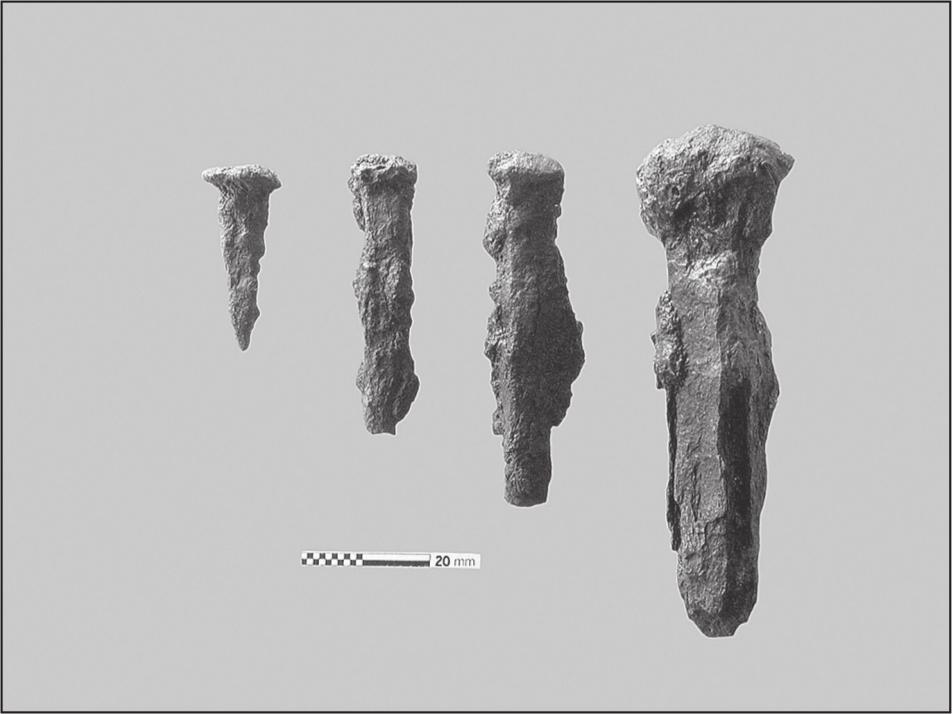
Figure 6.3 Square shaft, cut plate, rose head nails from the Chinaman’s Point site.
| Metal fasteners | MNI | Site location |
|---|---|---|
| Square shaft rose head (retained) | 7 | area 4; TZ |
| Square shaft rose head (discarded) | 13 | area 4; TZ |
| Round shaft rose head (retained) | 6 | area 4; TZ |
| Round shaft rose head (discarded) | 50 | area 4; TZ |
| Unidentifiable nail (discarded) | 233 | area 4; TZ |
| Spike (retained) | 7 | area 4; TZ |
| Spike (discarded) | 52 | area 4; TZ |
| Tack | 2 | area 4; TZ |
| Screw | 8 | area 4; TZ |
| Washer (lead) | 2 | TZ |
| Total discard | 348 | area 4; TZ |
| Total retain | 40 | area 4; TZ |
| Total | 388 | N/A |
Table 6.4 Minimum number of metal fasteners (MNI = minimun number of individuals; TZ = tidal zone).
Screws
Eight screws are present in the assemblage. One is made of brass and the others are heavily corroded iron screws; all are designed to fasten into timber materials. Screw sizes range from 28 to 68 mm long and from 4 to 8 mm in diameter. These are standard type wood screws with a multitude of timber fastening applications such as securing internal or external shelving, frames, hinges and brackets.
Six screws were recovered from the tidal zone within squares 3G and 3P of the site grid. The remaining two screws – including the brass one – were excavated from area 4 of the site, one in the central region of area 4. Thus, the screws have very similar spatial positions to the recovered nails.
Spikes
Fifty-nine ferrous metal spikes were recovered. Thirty-eight of these have a square shaft that tapers to a two facet chisel point, with 12 of the 38 displaying a rose type head. Six of the spikes have round shafts with four facet points and unidentifiable heads; the remaining 15 spikes are too heavily corroded to have their attributes accurately recorded. All spikes range between 40 and 220 mm in length and 8 to 20 mm in diameter.
On the South Coast of New South Wales, between Moruya and Bermagui (figure 6.4), Bowen (1999: 64; 2003: 12) noted that spikes were commonly used by commercial fishermen to fasten together slipway timbers. Maintenance of boats is an ongoing task for any commercial fishing operation. Slipways were used to hold a boat out of water for maintenance purposes, necessary on average every six months. To construct a slipway, bearer timbers were placed parallel to the shore from below low tide mark to well above high tide mark. These were morticed to cradle timbers at a right angle to bearers and held together by steel spikes. 93
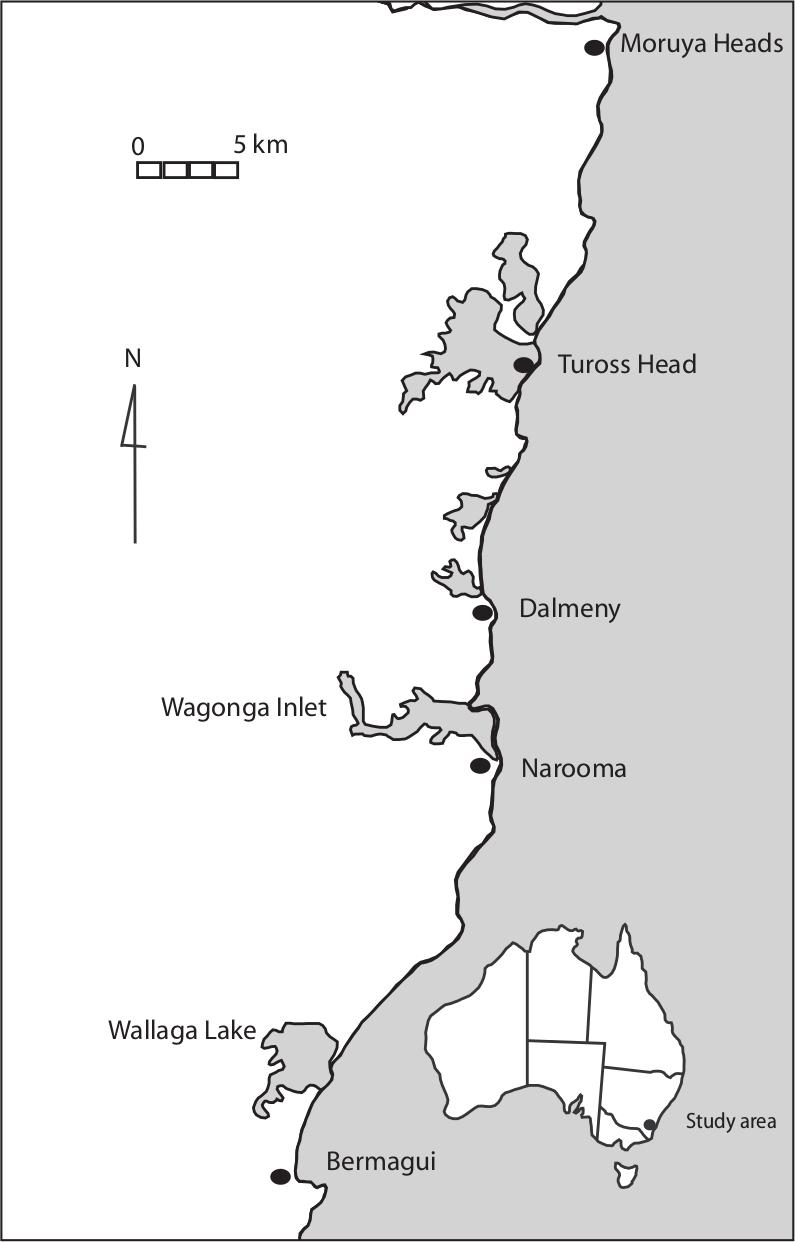
Figure 6.4 Location map for Moruya to Bermagui, South Coast, New South Wales.
Although no timber remains of a slipway are visible at Chinaman’s Point, the recovery of metal spikes at an establishment where fishing boats were almost certainly present suggests slipways were in use at the site. The metal spikes – of a similar size to those found on the South Coast of New South Wales – were recovered within a localised vicinity, slightly east of area 4 in the tidal zone.
Materials
A small representation of architectural and structural material was recovered from Chinaman’s Point including brick, timber post remains, lead sheeting and window glass. Timber post remains in area 1 and 3 and those associated with the jetty in the tidal zone have already been discussed in the site description section of chapter 5.
Bricks
With further settlement at Port Albert during the 1850s and 1860s, people desired permanent dwellings. To cater for this, a number of brick-making facilities were established in the region. For example, Henry Sherwood and Richard Huntington each operated a brick factory in the Tarraville area during the late 1850s and in the 1860s Samuel Taylor ran The Port Albert Brickworks located on the outskirts of town (Gippsland Guardian 1859, January 7; Gippsland Guardian 1860, September 21; Lennon 1975: 124).
Twenty-two brick objects, weighing 2702 g and representing a minimum number of 18 bricks were recovered in a fragmentary, deteriorating and fragile condition from the Chinaman’s Point site. Most are hand moulded, uneven, poorly fired bricks of varying textures and range in colour from red/brown to orange/tan (figure 6.5). An estimate of the original brick sizes suggests their average square (head) end measurements were 75 mm thick by 100 mm wide. Length measurements were unobtainable. These dimensions do not match standard 19th-century British, American or Chinese brick sizes which were 65 thick by 115 mm wide (British), 55 mm thick by 100 mm wide (American) and 65 mm thick by 140 mm wide (Chinese) (Gurcke 1987: 118; Manson 1982: 13). Nineteenth-century Australian brick sizes did vary considerably (Stuart 2005: 83), however, as the standard brick sizes from other countries are not apparent in the sample from Chinaman’s Point and as bricks were available locally, the Chinaman’s Point bricks are probably not an imported variety. One brick fragment has a plain stamped frog or indent and is of superior manufacture quality – i.e. shows even firing – compared to the other recovered bricks. 94
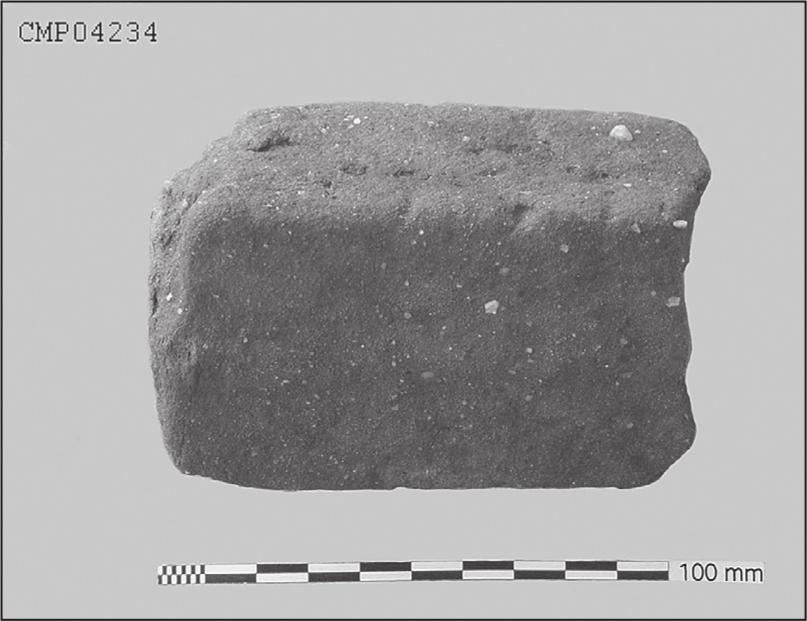
Figure 6.5 Hand-moulded mud brick from the Chinaman’s Point site.
The brick of superior quality from the site is likely to have been manufactured at one of the region’s brick factories. The remaining poorer quality, non-standard sized bricks probably came from one of the informal, one-man brick-making operations that were also plentiful in the local vicinity (Adams 1990: 49, 120).
The bricks were not located in association with a hearth or other structural setting. Seven pieces were grouped together in the gutter system at the eastern end of square 5G. However, to function properly as a means of drainage, the gutter system would need to have been kept clear of obstructions, meaning these brick pieces probably represent displaced objects from the post-site occupation period. Three further brick pieces were excavated from area 4. The remaining 12 bricks portions were located randomly within the site’s tidal zone.
Lead sheet
Two pieces of lead sheeting weighing a total of 292.3 g were recovered from the tidal zone and area 4 of the site. Both are 1.5 mm thick, approximately 80 mm wide by 150 mm long and rectangular in shape and have a series of 3 mm diameter nail holes spaced evenly around their entire perimeter. These two artefacts probably acted as water-resisting measurers, i.e. for flashing, or as subsequent building repairs to weatherproof a structure.
Window glass
One hundred and seven shards, weighing a total of 431 g and representing two types of window glass was recovered from the Chinaman’s Point site. Sixty-three shards are of the crown type window glass dating from 1800 to 1870 and 44 shards are of the improved flattened cylinder type window glass dating from 1834 to 1910 (Boow 1991: 100–02). Eighty-four shards were recovered from the tidal zone and 23 were excavated from area 4 (table 6.5). Evidence from other overseas Chinese sites in Australia (Smith 1998: 65–82), New Zealand (Ritchie 1986: 149) and the United States (Sisson 1993: 56), demonstrates that overseas Chinese dwellings were generally constructed without windows. Therefore, these artefacts are a variation to the typical overseas Chinese site and suggest the presence of at least one relatively permanent domestic structure, with windows, at Chinaman’s Point.
| Window | Type | Number of shards | Weight (grams) | Site location |
|---|---|---|---|---|
| Aqua tinge | Crown | 28 | 145 | area 4; TZ |
| Aqua tinge | Imp flat cylinder | 32 | 167 | area 4; TZ |
| Clear | Crown | 35 | 91 | area 4; TZ |
| Clear | Imp flat cylinder | 12 | 28 | area 4; TZ |
| Total | N/A | 107 | 431 | area 4; TZ |
Table 6.5 Window-glass type and amounts (TZ = tidal zone).
DOMESTIC
Domestic artefacts include those associated with cooking, food, food storage, furnishings, liquid storage and tableware. These artefact types make up a sizable proportion – 5108 catalogue entries, representing 17 381 95artefact fragments – of the Chinaman’s Point assemblage, principally due to the large amount of bottle glass and ceramic fragments recovered from the site.
Cooking
One hundred and seven metal objects, weighing 5440 g and including handles, rims, spouts, body fragments, base fragments, support legs and hooks were considered to be associated with metal cooking containers. All were recovered from within the tidal zone east of area 4 and are too corroded to enable even a rudimentary reconstruction through conjoining processes. There appear to be a minimum of two kettles, one cooking pot and one wok represented in the assemblage. There was no evidence of a cooking hearth, possibly due to erosion or to the common Chinese custom of using mobile clay stoves designed to allow easy removal upon site abandonment (Anderson & Anderson 1977: 365).
Containers
The two kettles were identified through the recovery of two pouring spouts. One spout is of a universal pouring design and may be attributed to a number of robust 19th-century cast iron kettle types (figure 6.6). The second spout is of a similar design, but appears even more robust in construction (figure 6.7). As no similar design has been located for European pouring implements, it is speculated through site association that this spout may be of Chinese origin.
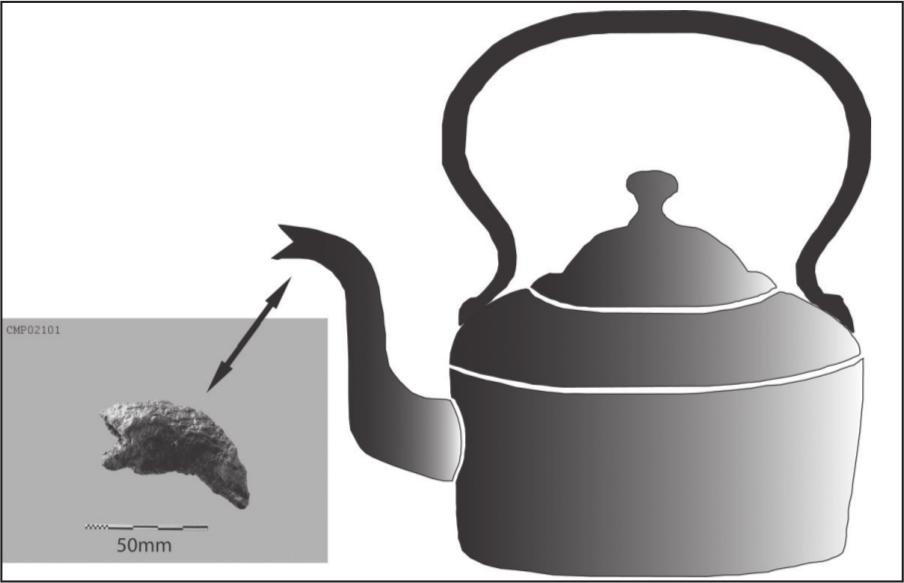
Figure 6.6 Common 19th-century cast iron spout from the Chinaman’s Point site and the type of kettle it most likely represents.
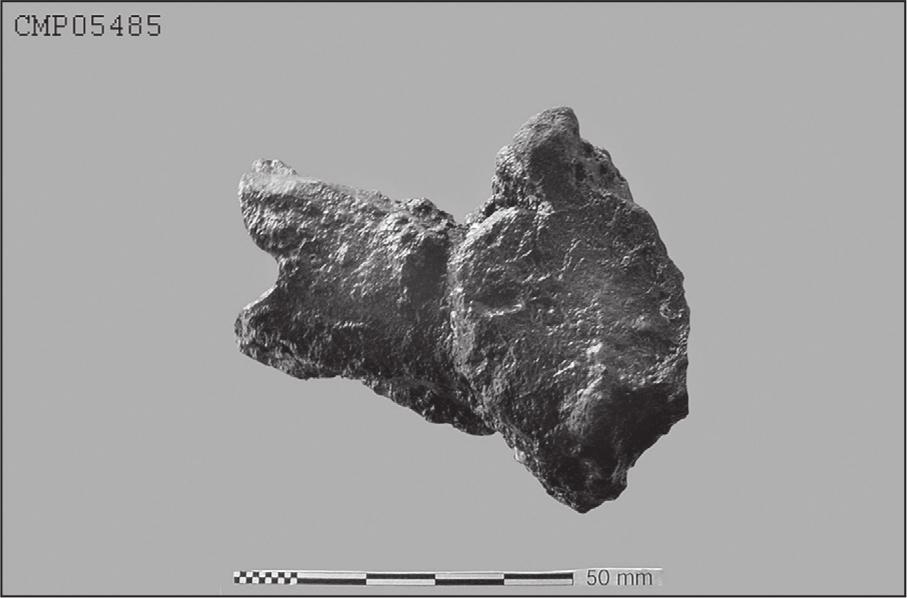
Figure 6.7 Robust pouring spout from the Chinaman’s Point site, possibly of Chinese design and origin.
The thickness of the corroded metal enabled the cooking pot and kettle body fragments (6 to 12 mm thick) to be distinguished from the wok fragments which are approximately 3 mm thick. Differing curvatures of the thicker fragments – 150 and 200 mm diameters – show that either two separate cooking pot/kettle sizes are represented or that one of the objects was oval shaped (figure 6.8). The recovery of two stumpy iron pot feet suggests the cooking pot/kettle was manufactured in the standing tripod or four-leg style, popular in both Asian and European iron cooking vessels (figure 6.9). According to Anderson and Anderson (1977: 359), Lee and Lee (1979: 27), and Passmore & Reid (1982: 35), Chinese people did not tend to roast or bake food in their day-to-day cooking practices. Therefore, an iron pot would have been used for boiling rice, soups, stews and other liquid-based dishes and the wok for stir-frying, deep-frying, simmering and steaming. Kettles, pots and woks represent common kitchen implements in Chinese culture (Evans 1980: 90; Passmore & Reid 1982: 30). 96
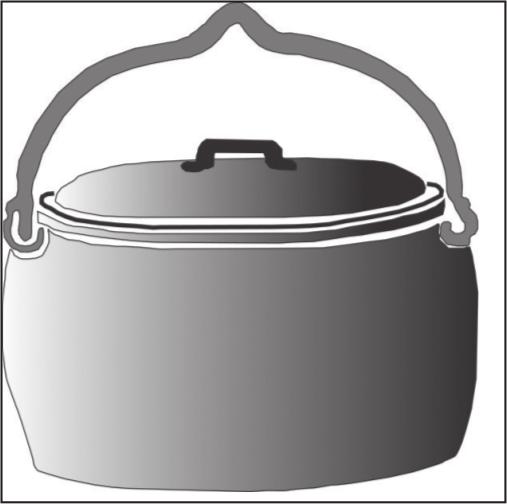
Figure 6.8 Curved cast iron cooking pot fragments from Chinaman’s Point suggest that oval-shaped cooking pots such as the one shown here may have been used at the site.
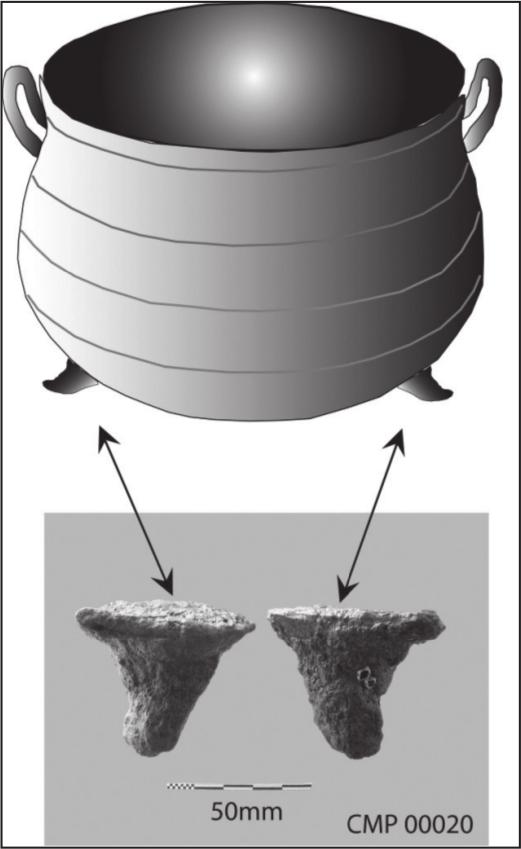
Figure 6.9 Stumpy iron pot feet from the Chinaman’s Point site and a diagram of the type of vessel they most likely represent.
Food
Bone and shell remains are the only evidence of food consumed at Chinaman’s Point. All bone remains are believed to represent aspects of the diet of site occupants. Faunal remains are useful for deciphering cultural preferences, living conditions and the possible socio-economic status of the population (Schulz and Gust 1983: 44). Fifty-six bone pieces weighing 560 g and ten marine shells weighing 87 g were recovered. The bone and shell assemblage is analysed by individual taxa and then discussed as a single data set. This is intended to identify the full range of species and species components represented in the assemblage, determine the minimum number of each individual fauna, examine butchering and culinary aspects and offer some rationale for the assemblage. Faunal quantities and distribution across the site can be seen in tables 6.6 and 6.7.
Faunal specimens have been identified, described and analysed through the aid of documentary, pictorial and physical references such as in Levine (1921), Boessneck (1969), Schmid (1972), Coleman (1975), Getty (1975), von den Driesch (1976), Halstead & Collins (1994), Lyman (1994), Leach (1997), Jansen (2000) and in the bone and shell reference collection at La Trobe University. Six bone pieces weighing 5 g and six shell pieces weighing 20 g were too fragmented for accurate identification to a taxa level. The assemblage contains 20 sheep (Ovis aries) bones, 19 cattle (Bos taurus) bones, seven fish (Pisces) bones, four pig (Sus scrofa) bones and three chicken (Gallus domesticus) bones. All bone is from domestic taxa, except marine varieties. 97
| Animal | Number of bone pieces | Weight (grams) | Site location |
|---|---|---|---|
| Cattle | 19 | 329 | area 3, 4, TZ |
| Sheep | 20 | 147 | area 1, 3, 4, TZ |
| Pig | 4 | 61 | TZ |
| Chicken | 3 | 2 | area 4, TZ |
| Fish | 7 | 9 | area 4, TZ |
| Unidentified | 3 | 12 | area 1, TZ |
| Total | 56 | 560 | N/A |
Table 6.6 Number, weight and location of recovered animal bones (TZ = tidal zone).
| Animal | Area 1 | Area 2 | Area 3 | Area 4 | Tidal one |
|---|---|---|---|---|---|
| Sheep | 1 | 3 | 4 | 12 | |
| Cattle | 2 | 3 | 14 | ||
| Fish | 3 | ||||
| Chicken | 1 | 2 | |||
| Shell | 10 | 4 | |||
| Pig | 4 | ||||
| Unidentified | 1 | 2 |
Table 6.7 Faunal distribution across the site (minimum numbers identified).
A brief discussion on the Chinese consumption of meat and the differences between European and Chinese butchering practices provide useful background to the faunal analysis. The diet of overseas Chinese people varied from traditional food practices in southern China. The significance of this variation often remains undetermined in archaeological projects – i.e. it is not clear whether this reflects acculturation or simply a reflection of food availabilities or elements of both (Ritchie 1986: 623–24; Langenwalter 1987: 76; Longenecker & Stapp 1993: 98).
While acknowledging that some dietary variation occurred, it is generally accepted that most overseas Chinese people preferred to maintain their traditional dietary habits which consisted largely of rice, cereals and grains as a staple; a wide variety of vegetables and spicy sauces and in most cases only small quantities of meat (Spier 1958: 130; Anderson & Anderson 1977: 319; Piper 1988: 34). Depending on region, meat eaten in the traditional Chinese diet – in order of importance – has been documented as pork, fish (in areas near large bodies of water fish outranked pork in importance), beef, poultry and mutton (Anderson & Anderson 1977: 336; Langenwalter 1987: 56; Buck 1937: 413). Chinese people eat almost all parts of an animal except feathers, scales, hair and bone, which are generally used in other ways. Carcasses were carefully butchered to assist this maximum-usage pattern (Mote 1977: 201; Wang 1920: 290).
Colonial European butchers commonly used knives, cleavers and handsaws to divide animal carcasses, while Chinese butchers generally used knives and cleavers (Levine 1921: 8; Piper 1984: 35). Levine (1921: 11) and Longenecker & Stapp (1993: 105) suggest that occasionally – and only for cutting the pelvic, breast or vertebrate bone – Chinese people used saws. However, saws are not included in the standard Chinese animal-butchering kit described by Levine (1921) and Longenecker & Stapp (1993) and are usually not discussed in association with Chinese butchering techniques.
Accordingly, when examining butchering patterns in bone assemblages from overseas Chinese sites, the difference between European and Chinese butchering technologies should be identifiable through the presence or absence of saw marks on the bone – except for pelvic, breast or vertebrate bone. Langenwalter’s (1980: 107) studies on butchering techniques show that width and depth analysis of chopping marks on bone are also useful in distinguishing between European and Chinese butchering marks. While chopping marks on bone from Chinaman’s Point are too weathered to enable this type of analysis, saw marks are common. 98
Sheep
In southern China, the Chinese fat-tailed sheep had minor importance as a source of meat, comprising approximately one percent of the standard dietary intake (Levine 1921: 4; Langenwalter 1987: 76). However, the widespread consumption of sheep by overseas Chinese people has been recorded at archaeological sites in the United States, New Zealand and Australia (Piper 1984: 22–23; Ritchie 1986: 621; Longenecker & Stapp 1993: 100; Lydon 1999: 97). Sheep were represented at Chinaman’s Point through metacarpi, humeri, ribs and teeth. It is estimated from the presence of four right metacarpis, bone size and tooth maturity that four incomplete individual sheep are represented. The recovered metacarpi distal ends show small, slightly notched, parallel trochlear condyles which, as described by Boessneck (1969: 355), clearly define them as sheep as opposed to the very similar skeletal structure of goat (Capra hircus) (figure 6.10). Moreover, goat was considered by the Chinese to be a greatly inferior quality of meat and was not commonly eaten (Levine 1921: 2, 4). One metacarpus displays distinct gnaw marks that are most likely from a rat, demonstrating rodent activity at the site.
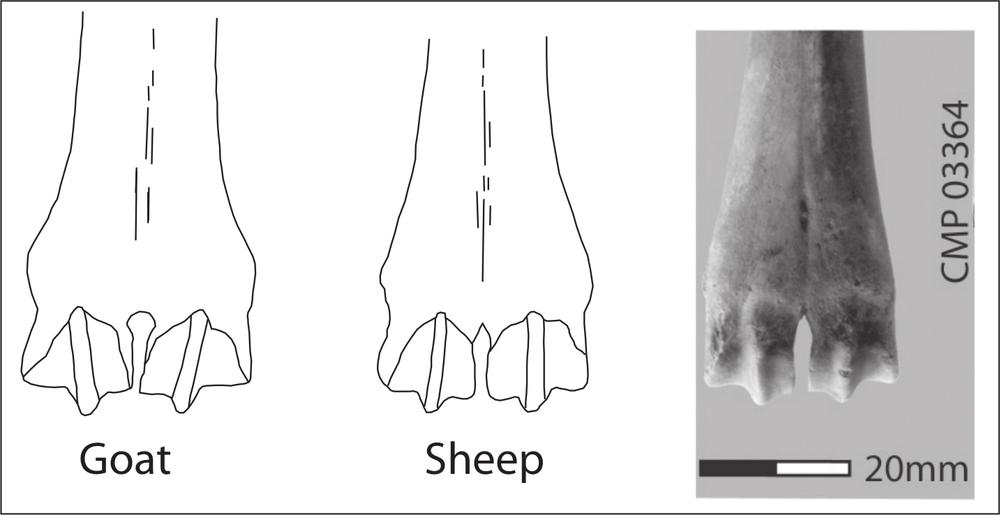
Figure 6.10 Metacarpus from Chinaman’s Point showing similarities to sheep as opposed to goat.
The humeri have had either their distal, proximal or both ends removed by saw, which is usually associated with bone-marrow extraction (Piper 1991: 273). A number of rib bones were also sawn through at approximately one third from the head end, similar to European methods of butchering sheep (Piper 1991: 310).
The assemblage of sheep teeth includes a number of worn M2 and M3 molars from animals aged between two and four years. One pre-molar tooth was also present (Getty 1975: 93). The recovery of teeth and a cervical vertebra implies cranium presence, which could reflect on-site slaughter of animals (Schulz & Gust 1983: 48; Longenecker & Stapp 1993: 110). However, as most of the recovered sheep bone display European butchering patterns, it seems more likely that sheep heads were brought to the site and used for meals such as sheep’s head soup and those involving tongue, eyes and brain.
One weathered humerus displays a possible cleaver/chopping/cut mark in conjunction with saw marks. This mark could represent bone de-fleshing by a European butcher or a Chinese cook to reduce the size of meat cuts and assist handling with chopsticks (Chinese people did not use knives during meals) (Ball 1925: 149; Chang 1977: 8). Sheep bone from Chinaman’s Point shows a consistency with low meat-bearing portions and European butchering practices (Piper 1991: 93–94). This suggests that cheap cuts of sheep were purchased from European butchers, as opposed to sheep slaughtering and butchering occurring on site.
Cattle
Cattle in Australia have always been used predominantly for meat. During the 19th century in China, cattle were usually only eaten as a luxury item and were considered to be more valuable for pulling ploughs than for consumption (Wang 1920: 292; Langenwalter 1987: 75; Piper 1988: 35). Chinese people with strong Buddhist beliefs avoided eating beef altogether and many others considered it a sacred meal to be consumed only on special occasions (Wang 1920: 289; Mote 1977: 201). Nevertheless, beef did have some role in the Chinese diet and was estimated by Buck (1937: 413) to have contributed between two and seven percent of the animal calories for southern Chinese people.
A total of 19 cattle bones represent a minimum of two incomplete animals. This number was estimated through the presence of two different sized phalanx number two bones. The recovery of cattle phalanxes, 99carpi, tarsi, tibias, patellas, sawn proximal femurs, longitudinally sawn humeri and pelvis bones indicate that the Chinese tended to eat low meat-bearing portions. One mandible was located and is also a low meat-bearing part. None of the cattle bones display cleaver/chopping marks, but, as with the sheep bone, appear to have been sawn in the European fashion (described by Ritchie 1986: 591).
Two rib bones have been sawn into unusually small 60 mm long sections. Piper (1984: 20) discusses a similar bone assemblage from a Chinese site in New Zealand, suggesting they may represent the purchase of specially requested meat cuts. Cutting ribs (and other bone pieces) into small portions is a common Chinese practice especially for the sweet stir-fry meal of chue p’aai kwat and for ease of handling with chopsticks (Levine 1921: 13; Chang 1977: 8). Purchasing ribs pre-cut to this size would minimise the preparation required for Chinese-style cooking.
Larger bones such as the tibia and humerus have had their proximal/distal ends sawn off, or have been split longitudinally (figure 6.11). Similar butchering patterns on cattle bone were noted by Ritchie (1986: 591, 623) at Chinese sites in New Zealand and were suggested to indicate the “distinctly Chinese practice” of bone-marrow extraction. Smith (1998: 151) also noted the same cut patterns from Chinese sites at Kiandra, New South Wales. Marrow bones are very cheap to purchase and are generally used for stock in soups, broths and stews (Piper 1988: 37).
Cattle age at time of slaughter – estimated through size comparisons – was between one and three years, which is a standard slaughtering age for quality beef (Longenecker & Stapp 1993: 115).
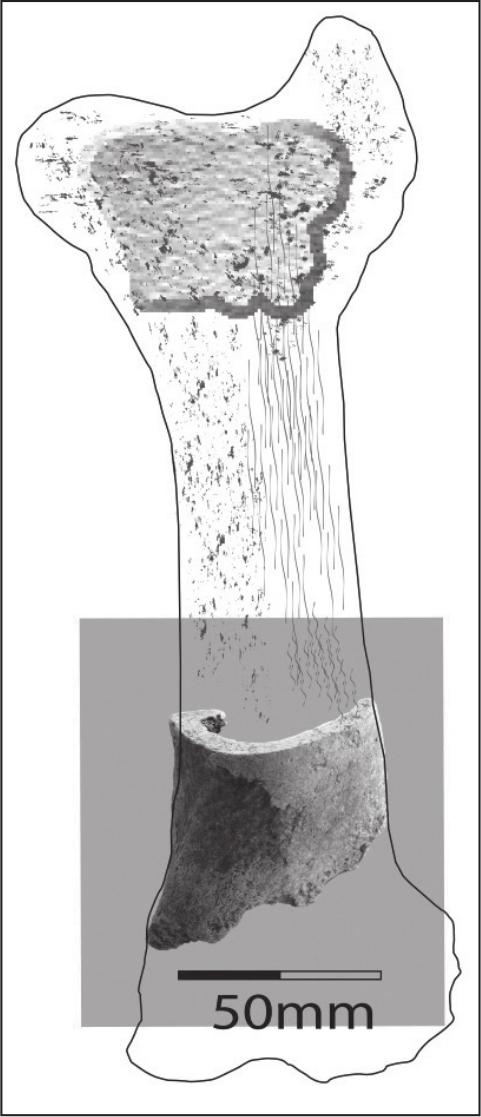
Figure 6.11 Cattle long bone from the Chinaman’s Point site showing signs of deliberate sawing most likely for the removal of bone marrow.
Pig
There is generally a low representation of pig bone from overseas Chinese sites in Australasia. Pork is the favoured meat in China, accounting for an average 72% of dietary calories (Buck 1937: 413). Its low representation in Australasia is most likely a reflection of the limited availability of pork and its high price compared to beef and mutton during the colonial period (Piper 1988: 36). A lower left-side tusk, two rib bones and a left calcaneus were the only pig elements identified from the bone assemblage at Chinaman’s Point. The tusk size and visible fusing on the calcareous indicate that the pig was between two and two-and-a-half years old at time of slaughter. This is a relatively old hog for meat purposes which suggests a female animal, as male hogs were usually slaughtered under one year old and female hogs were kept longer for breeding purposes (Levine 1921: 14; Silver 1978: 286; Longenecker & Stapp 1993: 115). No butchering marks are evident on the calcaneus or tusk and although both ribs appear to have been sawn to approximately 60 mm lengths, the ends are too weathered for a conclusive result.
100As with the recovered sheep and cattle bone, the pig components represent low meat-bearing parts of the carcass. Studies of pig cranial remains from overseas Chinese archaeological sites such as those considered by Langenwalter (1980: 107) in California and Piper (1984: 21) and Ritchie (1986: 600) in New Zealand conclude that pig skulls were commonly split open and the brain extracted. Levine (1921: 14) states the most common Chinese use of pig head is:
for lard, or cut into strips about three quarters of an inch wide and cured or it may be used for making sausage or head cheese. The snout, ears and tongue may be used fresh or pickled.
This lack of wastage in the consumption of pig is typical of Chinese eating practices (Peabody 1871: 660). It is not surprising then, that archaeological investigations at overseas Chinese sites – including Chinaman’s Point – often recover the lower meat-bearing portions of pig bone (Langenwalter 1987: 75; Piper 1984: 22; Stapp 1990: 194, 200). The older age of the slaughtered pig and the cheaper cuts also suggests that the Chinese were happy and perhaps even thought it desirable (culturally or economically), to consume meat cuts that were considered poor quality by Europeans.
Chicken
Chicken was represented by one small, broken and fragile section of ulna, a radius in similar condition and a complete coracoid from a single mature bird. Both the ulna and radius may have been chopped with a cleaver, however as discussed by Piper (1988: 38), cleaver blows to chicken bones are difficult to determine, especially on weathered samples. Eggs are common in Chinese cuisine and most Chinese people with a little spare land – in China or overseas – raised poultry for eggs (Wang 1920: 290; Yee 1975: 12). Chicken meat, however, was more for special occasions than as an everyday meal and was consumed much less frequently than other poultry such as ducks and geese (Levine 1921: 4; Buck 1937: 413; Nordhoff cited in Spier 1958: 130; Piper 1988: 35). This may account for the negligible representation of chicken bone from Chinaman’s Point.
Fish
In locations near any large body of water, fish is the most important and widely used protein source in China (Anderson & Anderson 1977: 336). It is therefore surprising (especially as it was a fish processing site) that the fish component from Chinaman’s Point contains only seven pieces of bone weighing a total of 9 g. These include the lower mandible and premaxilla from a porcupine fish (Atopomycterus nictheremus), two vertebrae from sand flathead (Platycephalus caeruleopunctatus), one Parika scaber (erectile dorsal spine) from a leather jacket (Nelusetta vittata) and three fish vertebrae that are too fragmentary for identification to species level (Wedlick 1980: 48; Roughley 1957: 139).
Port Albert’s waterways abound with fish which were even more plentiful during Australia’s colonial period. Certainly the occupants of Chinaman’s Point fish-curing establishment would have consumed by choice and for economic reasons large quantities of fish. It is possible that a substantial cache of fish remains was missed during the site excavation process. Such ‘bone pits’ have been discovered at other colonial-period overseas Chinese sites (see for example Longenecker & Stapp 1993: 118). Possibly the cooking methods – steaming or boiling – softened the bones to such a degree that they have not survived in the archaeological record. Fish resources at Chinaman’s Point may have been so abundant that only the fleshiest parts were consumed – as with the European ‘boneless fillet’ – and the wasted portion thrown into the water with the commercial fish offal, used as berley when fishing or possibly taken off site and used as fertiliser, for example at Chin Lang Tip’s Chinese market garden approximately two kilometres away. However, as most bone came from the site’s tidal zone, the most likely explanation for the scarcity of fish remains at Chinaman’s Point is that food scraps were thrown in the rubbish tip area. It is likely that the fish bones were not heavy enough to withstand the tidal currents and were washed away – probably along with other animal bone and light materials from the site.
Shell
Ten shell pieces weighing 87 g were recovered from Chinaman’s Point. This shell represents three bivalves – two from the Mytilidae family (Xenostrobus inconstans) and one mud oyster (Ostraea angasi) – and one gastropod from the Muricidae family (Thais baileyana) (Coleman 1975; Jansen 2000). Of the remaining six shells, all are gastropods that are too fragmented to identify, other than that they are of a conical variety. As only the mud oyster represents a commonly used human food source and as shells occur naturally in the environment, with no definitive connection to human activity (Colley 2005: 75), the site’s shell component is not considered to represent a significant dietary source.
Discussion
The bone assemblage from Chinaman’s Point is typical of other overseas Chinese sites in Australasia. Although the sample size is small, meat consumption appears to have mainly consisted of sheep and cattle and to a lesser 101extent pig, chicken, fish and shelled mollusc. Meat consumption ratios are difficult to determine as fish and other animal bone is suspected to be severely under-represented (due to artefact removal through tidal-based site erosion) and it is unclear what quantities of sheep and cattle bone were purchased for bone marrow rather than for flesh. It is probable that the site occupants had a standard diet of fish, varied occasionally by other meats. The dominance of sheep and cattle bones over pig differs from traditional Chinese dietary preference. However, such a bone assemblage is common at overseas Chinese sites (see for example Piper 1984; Ritchie 1986; Langenwalter 1987; Smith 1998) and can be explained in terms of availability and relative cost of meats, as opposed to a change in dietary preferences.
A preference for lower quality, cheaper meat portions is noticeable in the sheep, cattle and pig bone assemblage. The use of low meat-bearing parts is often viewed as reflecting the site occupants’ low economic status (Schulz 1979: 56; Schulz & Gust 1983: 44). Australia’s colonial Chinese population is frequently portrayed as being frugal (Gittins 1981: 72), providing a convenient explanation for the cheap meat cuts from Chinaman’s Point and other sites. However, Chinese people have a cultural preference for less fatty, lower meat-bearing cuts and marrow bones used in Chinese style cooking. As animal bones from overseas Chinese sites in Australasia and the United States generally indicate a predominance of low meat-bearing parts such as head, rib, leg, shin, knuckle and marrow bones from sheep, cattle and pig (Langenwalter 1880: 107; Ritchie 1986: 593, 600, 602; Langenwalter 1987: 75, 88, 93; Smith 1998: 154, 286), a bone assemblage with a dominance of these types of meat cuts (if associated with other suitable material or documentary evidence) could be considered an indicator of overseas Chinese occupation of a site. The occupants of Chinaman’s Point probably purchased these types of meat cuts very cheaply for use in traditional Chinese dishes.
The absence of chopping marks, the dominance of saw marks and a pattern of standard European carcass dissection (described by Ritchie 1986: 591, 610–11) of the bone recovered from Chinaman’s Point, suggest that sheep and cattle elements were purchased from European butchers. While no definite conclusions can be made in regard to the butchering of the recovered pig elements, their low representation suggests that pigs were not raised and slaughtered on site.
None of the recovered bones display evidence of burning, which is typically demonstrated by white, often fragile sections of bone (Spennemann & Colley 1990: 57). Together with the style of cooking containers recovered from the site (stewing pots and a wok), this provides further evidence of Chinese cooking techniques, including water-based meals such as soups, broths and steamed foods and quick-cooking stir-fry meals (Ball 1925: 149; Anderson & Anderson 1977: 355, 358; Piper 1984: 12).
Food storage
Two types of food container were identified from Chinaman’s Point – European and Chinese timber casks and stoneware containers.
European cask
A 2450 year-old Egyptian-built wooden cask on display in New York’s Museum of Fine Arts reveals the long history of these storage containers (Hughes 1925: 22). During the 19th century, wooden casks were the most common form of bulk container used to store and transport food and other goods (Staniforth 1987: 21).
Two thousand and fifty six pieces, weighing 131 kg, of hoop iron for cask hooping were recovered from the Chinaman’s Point site. Three widths of strap – 38 mm, 32 mm and 25 mm – mostly displaying a uniform curvature, were evident in the assemblage. These measurements are consistent with standard 19th-century regulations for the top, middle and base hoop iron widths for wooden cask containers (Hughes 1926: 20) (figure 6.12). In association with the cask hooping were 62 metal rivets weighing 2231 g, which are consistent with the type of rivet used for securing the end pieces of cask hooping. Recovered rivets display a convex cylindrical head 20 to 35 mm diameter, 6 to 10 mm body diameter and a hammered flat section that forms the stop-end or inner rivet head.
The original function of the casks was probably to hold foodstuffs. They were probably used mainly at Chinaman’s Point for brining fish, as metal tubs would have quickly rusted and tainted the flesh. Timber casks could be re-used over long periods and may have been fitted with tight covers to reduce evaporation and dilution of the brine through rain water (Ashbrook 1955: 217). As approximately 76% of cast hooping fragments were recovered from area 1 – believed to have been an industrial area of the site – it is conceivable that barrels were positioned here for fish-brining purposes and in other areas of the site for storage of fresh water and other goods. 102
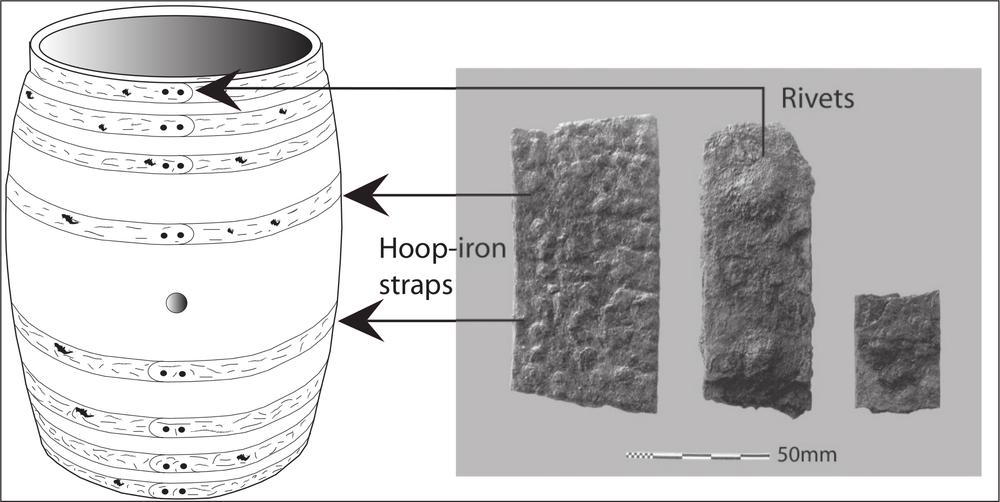
Figure 6.12 Cask hoop (with rivets) from the Chinaman’s Point site shown in association with a 19th-century European iron-hooped cask.
Chinese cask
A Chinese cask is held at the McCrossin’s Mill Museum in Uralla, New South Wales, labelled ‘early 1900s dark soy sauce barrel’ (Wilton 2004: 78). This cask differs in hoop-iron design from European casks as the horizontal, cylindrical hoops (25 mm wide) are supported by vertical, straight sections of iron (20 mm wide). To unite the vertical and horizontal straps, the vertical iron band has been folded and hammered tight around the cylindrical band.
In area 1 at Chinaman’s Point, corroded and fragmented cask hooping was located in association with very fragile timber remains. A section of approximately 20 mm wide hoop iron was bent and hammered flat around another approximately 28 mm wide section of hoop iron to form a 90 degree ‘T’ angle similar to the cask at McCrossin’s Mill Museum. It is probable that this hooping is from a Chinese-style timber cask. The feature was too fragile to be removed without the destruction of material and form. Therefore, it was recorded, drawn, photographed and left in situ (figure 6.13).
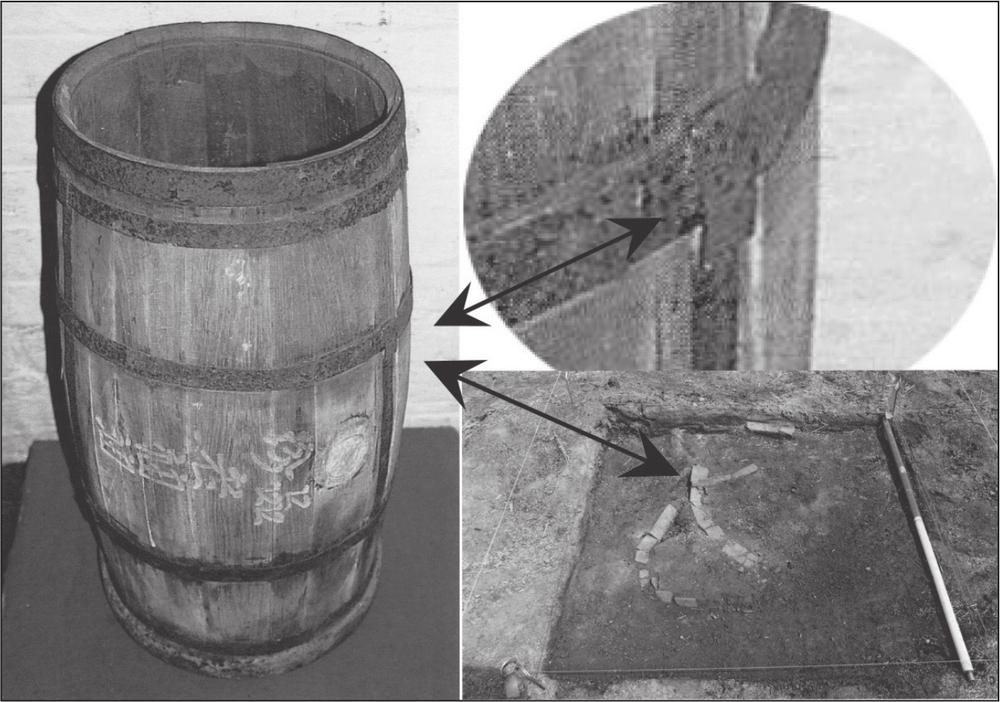
Figure 6.13 A Chinese-style timber cask (left and insert) and the in situ cask hooping from Chinaman’s Point. Image of Chinese cask from Wilton 2004: 78.
103The storage and transport of Chinese food items is most commonly associated with Chinese-style brown and green glazed stoneware ceramics. It is likely that Chinese casks held a variety of food items other than dark soy sauce. The Chinese cask remains from Chinaman’s Point may have contained imported items for use by the site occupants or been used to export commodities such as pickled fish from the site. At the very least, its presence reveals that Chinese-style timber casks were used in colonial Victoria and provides a basis to assist future researchers identify such artefacts.
Chinese stoneware
Chinese stoneware vessels specifically designed for food storage include the brown glazed wide-mouthed shouldered jars (and associated lids) and green glazed ginger-style jars. Both vessel types were recovered from the Chinaman’s Point site. The ceramics used by 19th-century overseas Chinese people are the subject of increasing amounts of research. Documentary information on Chinese stoneware vessels and other Chinese ceramics discussed below under the heading ‘Liquid storage’, ‘Tableware’ and ‘Recreational’, has come predominantly from Quellmalz (1972; 1976), Chace (1976), Etter (1980), Ritchie (1986), Brott (1987), Wegars (1988; 1998; 1999), Jones (1992), Wylie & Fike (1993), Sando & Felton (1993), Svenson (1994), Yang & Hellmann (1996), Lydon (1999) and Muir (2003).
During analysis of the Chinese ceramics from Chinaman’s Point, it became clear that the base and body fragments from wide-mouthed shouldered jars are indistinguishable from those of the Chinese spouted jar (figure 6.14). Ritchie (1986: 234, 238) has also documented this similarity in artefacts from overseas Chinese sites in New Zealand and suggests that the body and base sections “could have been mass produced for both pot types”. In a fragmentary assemblage, it is only when rim, spout or shoulder sections of these vessels are represented that the individual items can be identified. For this reason, brown glazed stoneware fragments that could not be clearly identified as either a wide-mouthed or spouted jar are referred to here as being either wide/ spouted jars. The minimum number count for wide/spouted jars (table 6.8) has been estimated through base diameter reconstructions. Type, number of sherds, MNI and location for Chinese stoneware vessels is shown in table 6.8.
| Chinese stoneware | Number of sherds | Weight (grams) | MNI | Site location |
|---|---|---|---|---|
| Liquor bottles | 167 | 805 | 7 | TZ |
| Spouted jar | 63 | 545 | 19 | area 4; TZ |
| Wide-mouthed jar | 36 | 176 | 5 | TZ |
| Wide/spouted jar | 2377 | 10 966 | 26 | area 3; 4; TZ |
| Green glaze jar (round) | 31 | 68 | 2 | TZ |
| Lid/shallow bowl | 60 | 168 | 24 | TZ |
| Total | 2734 | 12 728 | 57 | N/A |
Table 6.8 Type, number of sherds, MNI and location for Chinese stoneware vessels (TZ = tidal zone).
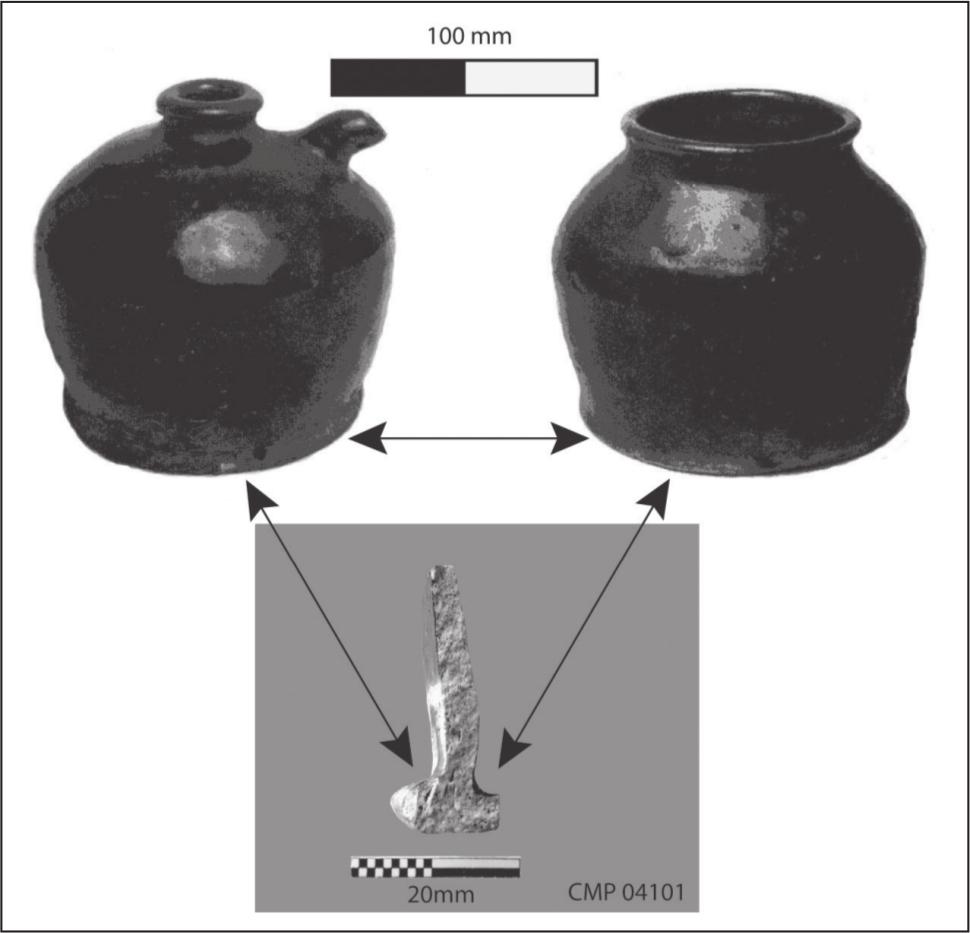
Figure 6.14 The Chinaman’s Point base sherd could represent a Chinese spouted jar (left) or a Chinese wide-mouthed shouldered jar (right). Images of complete jars from Muir 2003: 44–45.
104Wide-mouthed shouldered jar
These utilitarian brown ware vessels are generally recovered in association with seven other Chinese brown ware containers: spouted jar, straight-sided jar, globular jar, liquor bottle, barrel jar and pan and are among the most common artefacts discovered at overseas Chinese sites (Yang and Hellmann 1996: 4–9; Lydon 1999: 215). They were produced in China from coarse stoneware that was shaped on a spinning wheel to a consistent ‘idealised form’ (Ritchie 1986: 231) and have a thick outer coating of brown iron glaze and a thinner, often uneven inner brown glaze (Muir 2003: 44). Their bases are concave and left unglazed externally (figure 6.15). The minimum number count for wide-mouthed shouldered jars from Chinaman’s Point (shown in Table 6.8) has been estimated through rim fragment diameter associations. Interestingly, the usually very common straight sided and globular jars (figure 6.16) were not found in the Chinaman’s Point assemblage.
Wide-mouthed jars are commonly between 130 to 150 mm high (Muir 2003: 44), with samples recovered from Chinaman’s Point displaying an average 4 mm in body thickness, between 100 and 200 mm in base diameter and 80 to 150 mm in rim diameter. Papers such as Yang & Hellmann (1996) have examined the uses of imported Chinese brown ware vessels in the United States and what their contents may have been, however archaeologists still struggle to ascertain a specific range of contents. It is generally accepted that they were used to store a wide array of preserved and raw foods such as eggs, vegetables, bean curd, fruit, garlic, soy bean, food pastes, salt and sugar. They also had an extremely versatile re-use value (Olsen 1978: 32; Yang & Hellmann 1996: 3; Muir 2003: 44).
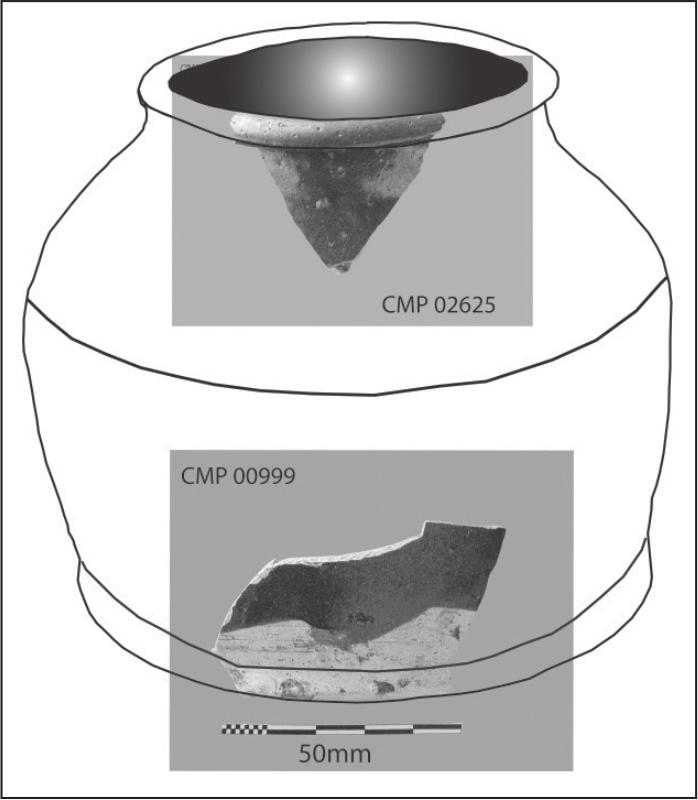
Figure 6.15 Drawing of a wide-mouthed shouldered jar with associated artefacts from the Chinaman’s Point site.
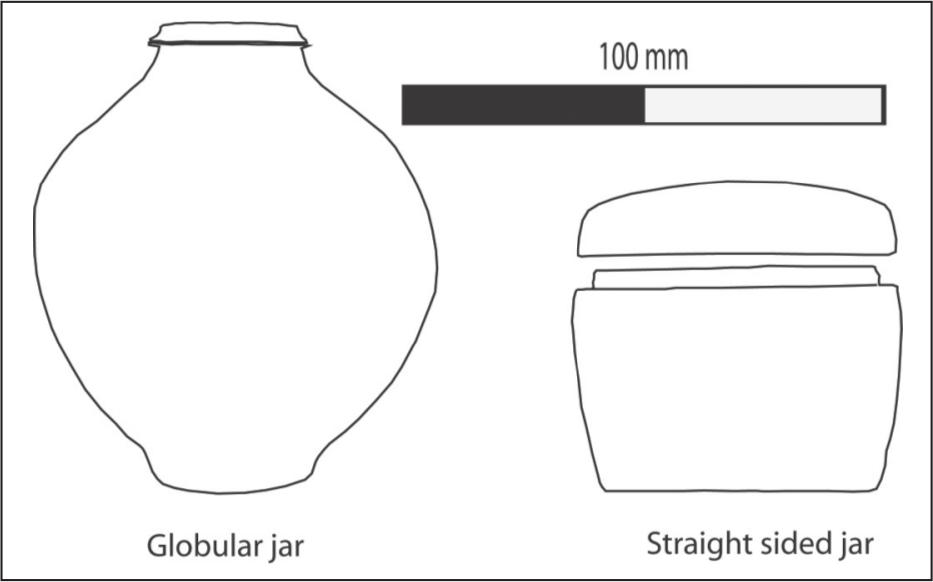
Figure 6.16 Surprisingly, the Chinese globular jar (left) and straight-sided jar (right), were surprisingly not represented at the Chinaman’s Point site.
Wide-mouthed jars recovered from other overseas Chinese sites often display burning on the base sections, indicating that they have been used for cooking purposes (Ritchie 1986: 242). No stoneware bases from Chinaman’s Point revealed evidence of burning, however two base sherds from wide/spouted Chinese brown glaze vessels had residue adhered to their inner surface. This residue likely represents food remains and although expensive analyses could not be conducted for this project, future chemical analysis of these residues holds potential to reveal further information about the everyday lives of overseas Chinese people in colonial Australia. 105
Lid/shallow bowl
Chinese wide-mouthed jars are often located in association with unglazed, concave, stoneware lids. Ritchie (1986: 242) suggests the lids were fitted to seal the wide-mouthed vessels with soft unfired clay, the remnants of which are still adhere to some lids recovered from New Zealand sites. Yang and Hellmann’s (1996: 3–4) discussion on functional re-use suggests the saucer shape of the lids enabled them to be re-used as shallow bowls for sauces and other food.
The minimum number count for lid/shallow bowls from Chinaman’s Point (table 6.8) has been estimated through rim fragment diameter associations. The lids range between 80 and 150 mm in diameter, have an average 3 mm body thickness, sit between 10 and 15 mm deep in the bowl and range in colour from cream to buff red (figure 6.17). The lid diameters correspond with the wide-mouthed jar rims, thereby complementing Ritchie’s (1986) and Yang & Hellmann’s (1996) theory that the two items are associated artefacts.
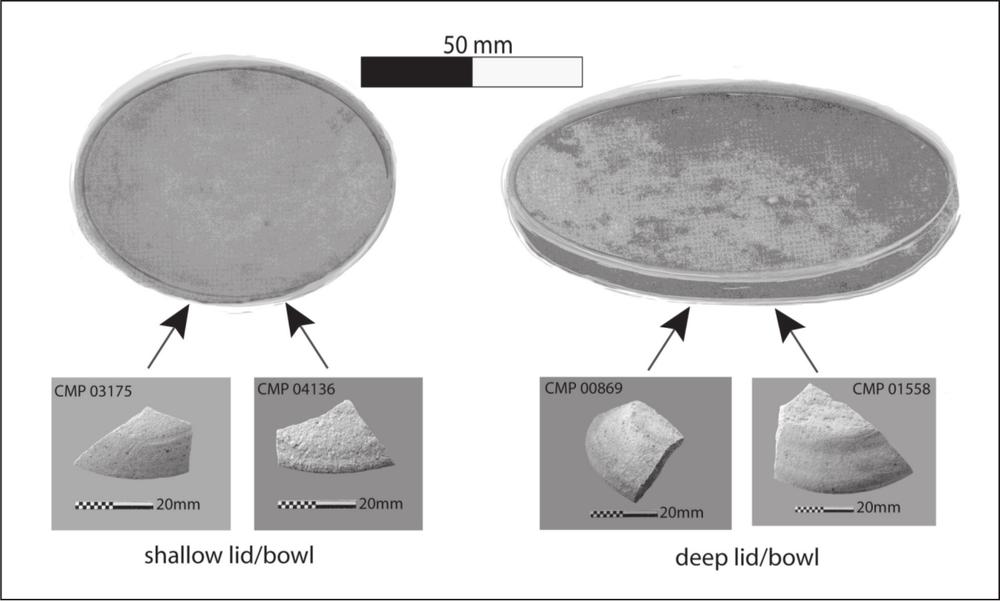
Figure 6.17 Fragments of unglazed lid/shallow bowls from the Chinaman’s Point site and pictures of the complete items.
Chinese green-glazed jar
Green-glazed Chinese stoneware vessels are generally associated with the term ‘ginger jar’. However, as discussed by Olsen (1978: 35), these vessels contained a range of preserved foods other than ginger such as sliced turnip, green onions, green plums and sweet gherkins. Consequently, Ritchie (1986: 259) uses ‘ginger jar’ as a generic term, further suggesting they may also have contained various types of cosmetic or medicinal creams. Two green-glazed jar shapes are commonly recovered from overseas Chinese sites: the hexagonal and the round (figure 6.18). They are produced from a stoneware material, in a similar fashion to the brown glazed vessels, only their glaze is a glossy light or dark green colour (Muir 2003: 46). Wood (1999: 224) has analysed these green glazes to reveal that they were produced from a mix of ground glass and natural minerals found in river mud.
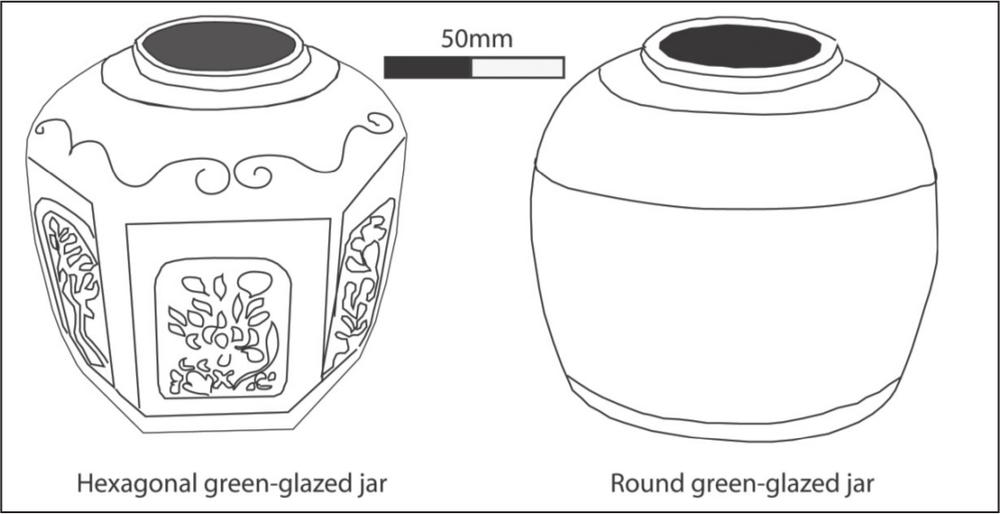
Figure 6.18 The two most common types of Chinese ginger jar: the hexagonal (left) and the round (right).
106The minimum number of green-glazed vessels was ascertained through the recovery of three different sized vessel rim diameters – 70 mm, 90 mm and 120 mm (table 6.8). Rim, body and base fragments reveal that each vessel is of the round wide-mouthed variety. In keeping with the green-glazed jars recovered from other overseas Chinese sites such as in Ritchie (1986: 260) and Brott (1987: 245), the green-glazed jars from Chinaman’s Point display a thick outer green-glaze that has been allowed to drip down the exterior to leave thick dollops or drips of glaze. They also have a light brown interior glaze (figure 6.19).
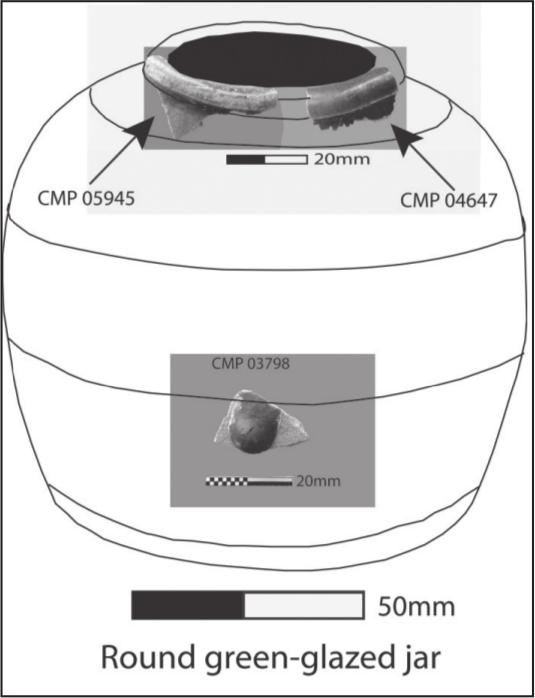
Figure 6.19 Chinese ginger jar rim fragments and a dollop of glaze (centre of jar) from the Chinaman’s Point site.
European stoneware
Like Chinese stoneware, European stoneware is generally associated with mass produced, heavy, thick-walled vessels that are most commonly used as utilitarian wares and storage containers with a huge range of re-use values (Sharpe 1992: 48). When kiln-fired, stoneware is non-porous and therefore does not require a glaze to seal the vessel. Even so, an external salt glaze and internal slip glaze was commonly applied for aesthetics or to enable easy cleaning for re-use purposes. Stoneware vessels were produced in a huge range of colours although the utilitarian and storage wares were most commonly a white/cream or light tan to dark brown colour (Gleeson 1997: 64). They were often impressed with a potter’s mark or had transfers printed with black ink, or were manufactured without markings (Arnold 1989: 111–12).
Eleven dark brown, salt glazed, European-style stoneware sherds, weighing 145 g and representing a minimum number of two food storage vessels were recovered from Chinaman’s Point. The minimum vessel count was estimated through the recovery of two similar but separate styles of vessel rim. None of the sherds display any evidence of a manufacturer or trademark. The only recovered base fragment is 80 mm in diameter. The two rim fragments have 60 mm diameters and body sherd thicknesses range from between 3 and 6 mm. These attributes are consistent with the European bung jar, a common storage vessel during the Australian colonial period (Ford 1995: 208). These containers require a large cork stopper to seal their opening, hence the name ‘bung jar’ and stored anything from pickled foods and preserved jams through to shaving creams and medicinal ointments (figure 6.20). They were also regularly sold without contents, as general storage jars (Arnold 1989: 112).107
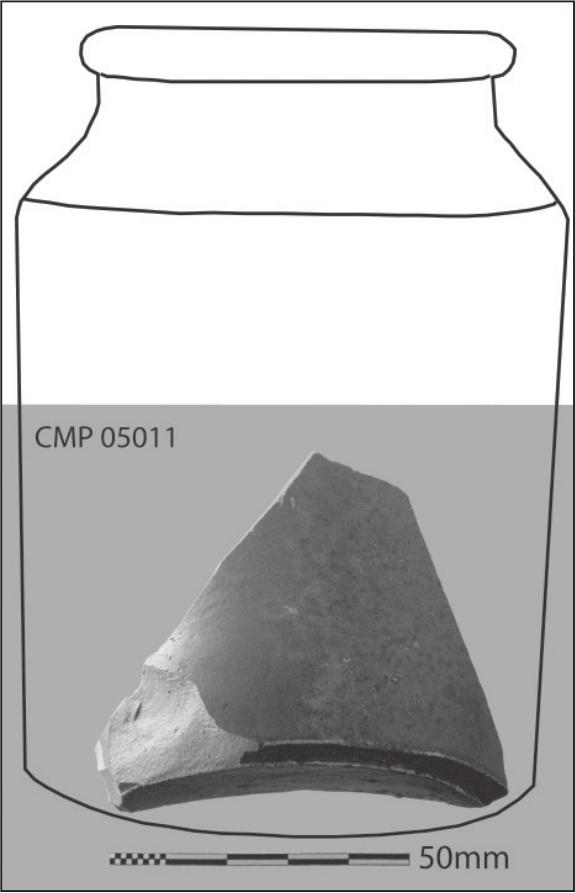
Figure 6.20 Base fragment of common European bung jar from the Chinaman’s Point site.
Furnishings
Box hasp
A flat, rectangular piece of brass weighing 13 g and displaying strategic circular and rectangular holes was recovered from the tidal zone at Chinaman’s Point. It measures 61 mm long, 33 mm wide and although set in one complete piece, has three separate rectangle-shaped sections that form two large enclosed rectangles, one small open-ended rectangle and six cylindrical holes. The item has 2 mm diameter holes in each corner of the rectangle, as if to fasten the object to a flat surface and a 2 mm and 1.5 mm diameter hole in its central region. The artefact’s unusual and deliberately constructed proportions suggest it had a specific function, perhaps as a box hasp – a locking mechanism that fits over a fastener and is secured by a pin, bolt, or padlock – on a Chinese luggage or storage chest/box.
Ornate hasps are especially popular in China. Internet sites of dealers in Chinese antiques demonstrate good comparisons, but not an exact match, between the Chinaman’s Point artefact and hasps on antique Chinese storage boxes (figure 6.21). For further examples see (www.trocadero.com and www.chinese-furniture.com).
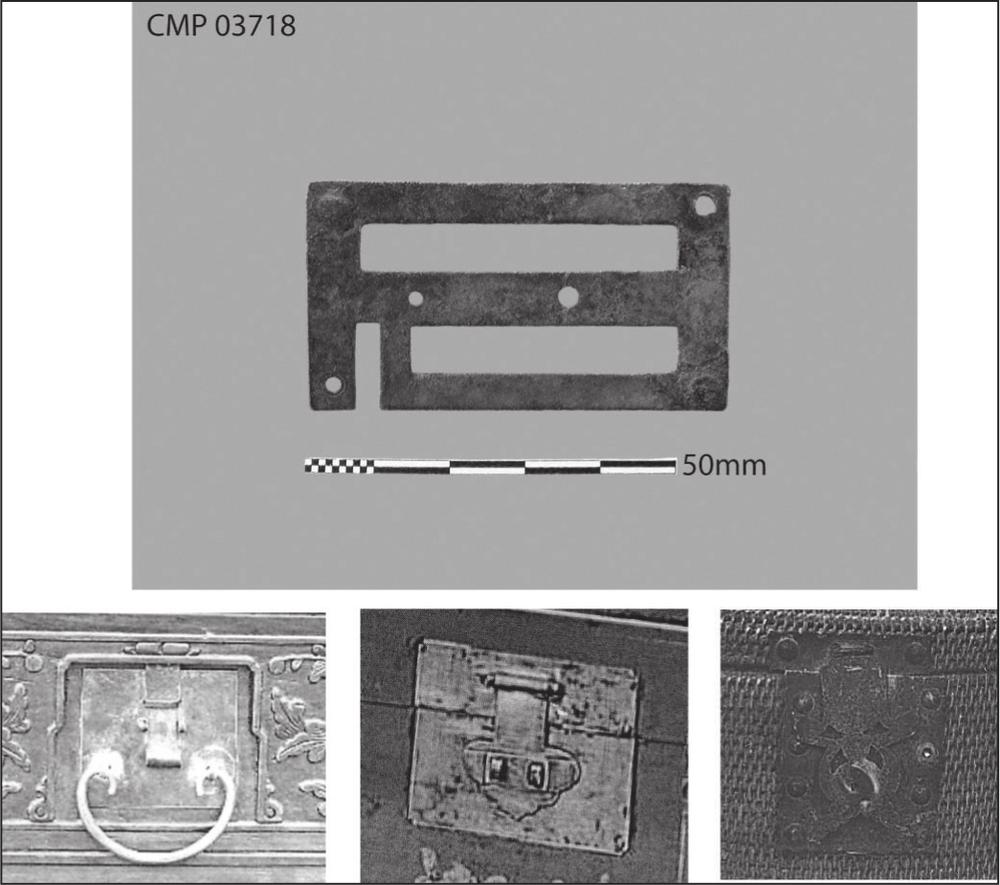
Figure 6.21 Suspected box hasp from the Chinaman’s Point site (top) and examples of antique Chinese storage-box hasps (bottom). Picutres of box hasps from web pages www.trocadero.com and www.chinese-furniture.com.108
Liquid storage
The following section provides an outline of the main liquid storage containers recovered from the Chinaman’s Point site. These items include two types of material: bottle glass and Chinese stoneware.
Bottle glass
The popularity of glass containers in colonial Australia and the general durability of glass fragments ensure their regular recovery from historical archaeological sites. Analyses of glass assemblages are useful in identifying site occupation dates (discussed in chapter 7), patterns of consumption, living conditions and providing general insights into site activities. Repeated discoveries of similar bottle types across separate sites can also infer an ethnic site occupation, see for example Wegars’ (1993: 223) work on the identification of perfume vials and Ritchie’s (1986: 181, 195, 204) discussion on preferred domestic products, pharmaceutical containers and certain types of alcohol bottles. The data below describes the main glass container forms, specific attributes, their most likely original contents (no adhesive labels were recovered), shard quantities and the minimum number of vessels represented and provides some interpretation of the recovered assemblage as a whole.
The high level of bottle-collector activity and site erosion through tidal movements is reflected in the recovery of only four complete glass bottles. Therefore, excluding buttons and window glass, the glass recovered – 13 997 shards, weighing 18.361 kg – represents a very fragmentary assemblage. The glass fragmentation and post-depositional movement of tidal-zone artefacts caused difficulty in analysing the glass bottle assemblage. Nineteenth-century glass bottles have a known colour-to-content association that enables broad patterns to be established. For the above reasons, this bottle glass analysis is structured around glass colour: dark green (often called ‘black glass’) light green, aqua-green, amber, light blue, aqua-blue and clear. Terms used to describe the basic bottle components from the top down are: finish, neck, shoulder, body and base (after Jones 1986: 34). Through analysing colour, shard form, bottle finishes and fragments of embossed glass, the main bottle styles appear to be beer, wine, aerated water, alcoholic spirits (gin, schnapps and whiskey), condiments (sauces, essences and oil) and medicinal containers.
One hundred and thirty-eight different bottle forms, representing a minimum number of 845 individual vessels have been identified from the Chinaman’s Point assemblage (tables 6.9 and 6.10). All minimum number of individual vessel counts have been estimated through an analysis of bottle base fragments. Spatially, bottle glass was recovered from all areas of the site, but most prolifically from area 4 and the tidal zone (table 6.11).
| Glass colour | Number of shards | Weight (grams) | Base types | MNI | Total% |
|---|---|---|---|---|---|
| Dark green | 2993 | 52 641 | 30 | 278 | 32.9 |
| Light green | 6646 | 86 384 | 17 | 247 | 29.2 |
| Aqua-green | 2591 | 25 978 | 36 | 196 | 23.2 |
| Amber | 1236 | 14 617 | 29 | 90 | 10.6 |
| Light blue | 78 | 568 | 3 | 4 | 0.5 |
| Aqua-blue | 168 | 1559 | 17 | 22 | 2.6 |
| Clear | 285 | 1859 | 6 | 8 | 1 |
| Total | 13 997 | 18 3606 | 138 | 845 | 100 |
Table 6.9 Colour, number of shards, number of base types, MNI and MNI percentages for glass containers.109
| Glass colour | Cyl MNI | Sq MNI | Poly MNI |
|---|---|---|---|
| Dark green | 231 | 47 | 0 |
| Light green | 206 | 41 | 0 |
| Aqua-green | 171 | 12 | 13 |
| Amber | 76 | 14 | 0 |
| Light blue | 1 | 3 | 0 |
| Aqua-blue | 9 | 8 | 5 |
| Clear | 7 | 1 | 0 |
| Total | 701 | 126 | 18 |
| Total% | 83% | 15% | 2% |
Table 6.10 Colour, form, MNI and MNI percentages for cylindrical, square and polygonal glass containers (Cyl = cylindrical; Sq = square; Poly = polygonal).
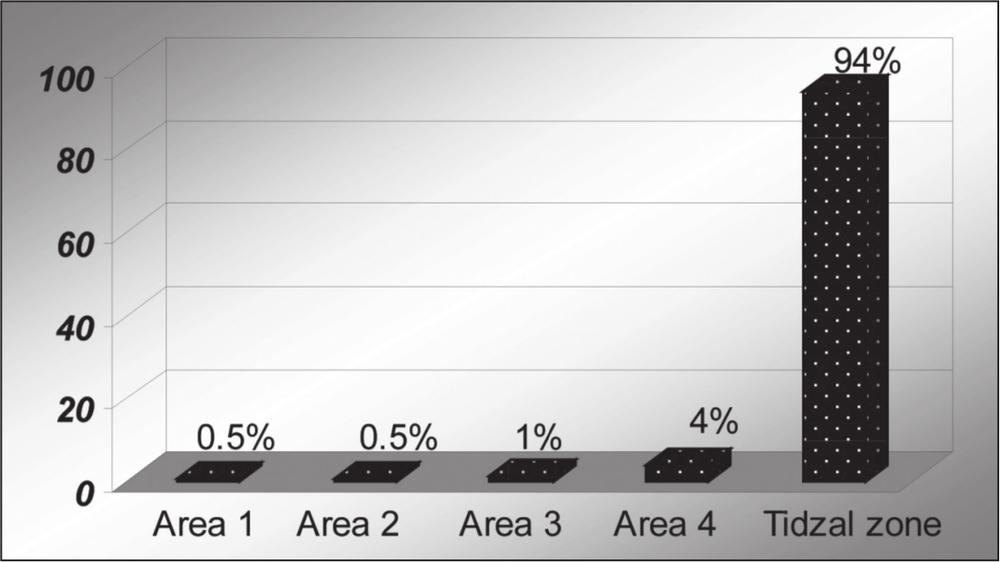
Table 6.11 Chinaman’s Point bottle glass distribution.
As there is no available classification of glass colour in historical archaeology, the colour notation system from the Munsell (1966) book of colour standards has been used to provide an indication of the glass colours discussed. A great deal of literature exists on the identification and analysis of glass items. Glass artefacts from Chinaman’s Point are interpreted primarily through the aid of Jones (1971; 1981; 1986), Toulouse (1971); Vader & Murray (1975), Hutchinson (1987), Wilson (1981), Miller & Sullivan (1984), Jones & Sullivan (1989), Ritchie (1986), Arnold (1987; 1990), Fike (1987), Stapp (1990) and Boow (1991).
Dark green
Dark green glass is often so dark in colour that it appears black, especially in the thicker bottle sections; hence it is often referred to as ‘black glass’ (Boow 1991: 20). Dark green glass from Chinaman’s Point was at its lightest, Munsell hue 7.5GY 3/6, with a middle hue 7.5GY 3/2 and 5GY 2/1 at its darkest shade. Cheaply produced from impure materials – usually with high quantities of natural iron oxides in the sand – dark green glass bottles were manufactured in a range of shapes, sometimes with a globule-type ownership seal on the bottle body and occasionally with embossing (Wills 1974: 16; Dumbrell 1983: 152). These bottles are generally associated with aerated water and alcohols – primarily beer, wine and spirits (Vader & Murray 1975: 37; Boow 1991: 24, 37). Aerated water is unlikely to have been heavily consumed at an all-adult, male dominated Chinese fish-curing site. Imported colonial beer was bulky, which made it expensive to transport compared to its relative sale value, had low alcohol content and went stale during the slow sea voyage to Australia (Dingle 1980: 235). Moreover, for most of the 19th century, Victoria’s brewing industry only produced small quantities of poor quality beer, which in turn created a colonial preference for spirits, predominantly rum and brandy (Dingle 1980: 230, 232, 241). Therefore, the dark green bottles from Chinaman’s Point most likely contained wine and spirits.
Dark green bottles are the dominant type in the Chinaman’s Point glass assemblage by minimum number count. Thirty-five shards reveal evidence of embossing, which in a small number of cases indicated the original bottle contents to have been whisky or schnapps.
One cylindrical dark green bottle base showed evidence of deliberate post manufacture modifications. This base had the push up centre section (the pontil) chipped away to create a small opening in the base centre. Such modifications have been noted – but not analysed – from two other sites in Australia, both with 110an association to overseas Chinese occupation. This base is discussed in detail in the ‘Recreational’ section of this chapter, where a plausible function is suggested.
Light green
Sometimes called ‘forest glass’ or ‘natural green’, light green glass can be produced from only slightly more than the basic glass ingredients of sand and an alkali flux such as lime or soda with the addition of ash from burnt rotten vegetation which reduces the colour impact from iron impurities (Birmingham & Bairstow 1987: 153). Therefore, without the cost of expensive oxides and other compound additives and with more aesthetic elegance than dark green glass, light green glass became favoured among 19th-century glass bottle makers (Proh 1973: 23). Light green bottles had an extremely versatile use in colonial Australia and although they are associated more with wine and aerated water than with beer or spirits, their contents varied widely (Fike 1987: 13).
At its lightest Munsell hue, light green glass from Chinaman’s Point is 7.5GY 7/6, with a middle hue 7.5GY 5/4 and 7.5GY 4/6 at its darkest shade. By shard numbers (6646) and weight (86 384 g), light green is the most common glass colour from Chinaman’s Point, dominated by the middle hue. Seventeen bottle base designs and seven finish types are present. Seventy-two separate shards have evidence of embossing with 64% of these – representing a minimum number of seven vessels – confirmed to be the square bodied Udolpho Wolfe’s Schnapps bottle.
Udolpho Wolf’s Schiedham Aromatic Schnapps is a Dutch-produced, gin-based alcohol created from juniper berries and was widely considered to have been a distilled drink of excellent quality and alcoholic value for money (Valder & Murray 1975: 37; Wilson 1981: 75). Heavily advertised through colonial newspapers and pamphlets including in the local Gippsland papers (Gippsland Standard 1884, March 21) this bottle is a very common find at historical sites in Australia (Vader & Murray 1975: 40). Gin bottles and to a slightly lesser extent brandy, are also common at overseas Chinese sites (see for example Langenwalter 1980: 106; Ritchie & Bedford 1983: 239; McCarthy 1986: 37; Gaughwin 1995: 235). Whether overseas Chinese people found European gins to be of better quality, cheaper or more easily obtainable than the Chinese distilled equivalents (mm ga pei and mui guai lo) is uncertain. It is clear however, that overseas Chinese people in Australasia were consuming greater quantities of European alcohol than Chinese alcohol.
Even with bottles that specifically state their contents, there is no way of ascertaining what the bottles at Chinaman’s Point had contained, as it is likely that many were purchased as refilled second-hand vessels. Boow (1991: 24) indicates, “there are numerous references to used-bottle sales and part payment for returned empties” and both Ritchie & Bedford (1983: 237) and Staski (1993: 135–36) have recovered European manufactured bottles from overseas Chinese sites that have been pasted with Chinese language paper labels. In some cases, these labels had been pasted over embossing that denotes the original bottle contents. This suggests that the re-use of bottles by overseas Chinese people was a common and organised practice.
The Chinese preference for European gins and brandy over other alcohols is noted in colonial-period texts. Adams (1997: 24–26) compiled a number of original food supply invoices from 19th-century overseas Chinese gold miners in Victoria’s Omeo region (figure 6.22). These invoices show gin and brandy as the most frequently purchased alcohols. The Reverend Young’s 1868 report into the state of Victoria’s Chinese population estimates that overseas Chinese people were spending annually almost as much money on spirits as they were on food. Moreover, Reverend Young states that “Mr Wade, of the Coopers’ Arms Hotel, Little Bourke Street, informed me that he sells monthly to the Chinese 40 gallons of gin … in bottles”, an amount equalling the monthly Chinese purchase of all other alcoholic sprits combined (Young 1868 cited in McLaren 1985: 63). 111
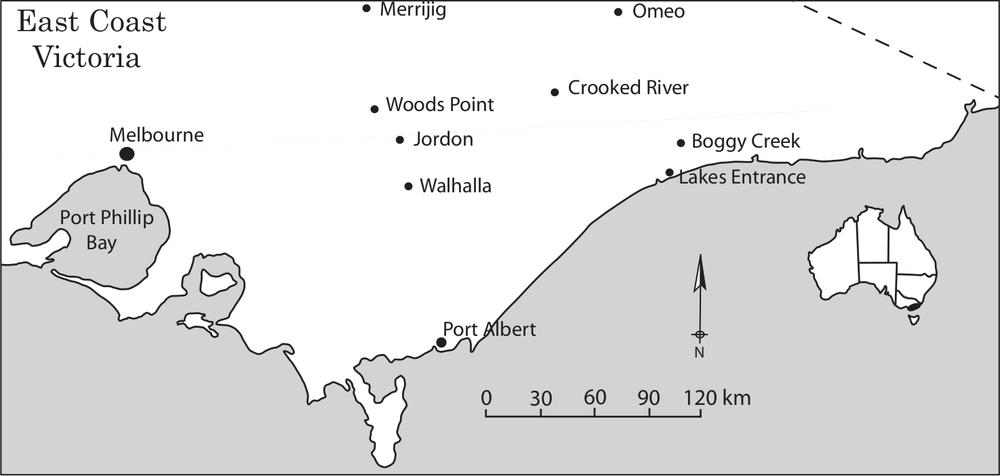
Figure 6.22 Map of Gippsland’s main colonial goldfields including Omeo, top right of map (Melbourne, Port Albert and Lakes Entrance are included as reference points only).
The light and dark green bottle assemblage from Chinaman’s Point suggests there was a preferred consumption of gin over other sprits. However, the fragmentary nature of the assemblage, the versatile use of green bottle glass and bottle re-use makes this difficult to confirm. It would be fair to say, however, that the occupants of Chinaman’s Point consumed considerably more European than Chinese wine and spirits (table 6.12).
| European alcohol bottles MNI | Chinese alcohol bottles MNI |
|---|---|
| 811 | 7 |
Table 6.12 Minimum number of European compared to Chinese alcohol bottles (MNI for European alcohol bottles is an estimate only due to the uncertainty of bottle contents).
Aqua-green
Aqua-green glass is a refined version of light green glass. It is produced through mixing good quality sand i.e. low in iron content, with a standard flux and a small quantity of oxide (Arnold 1990: 5). It had an extremely wide range of uses, including as window glass, drinking glasses, decanters, plates and bottles. In bottle form its contents were also wide ranging, holding anything from soft drinks, cooking additives and condiments, to medicinal liquids and alcohols.
A breakdown of aqua-green glass fragment attributes can be seen in table 6.13. The lightest aqua-green coloured shards correspond to Munsell hue 5GY 9/4 and have only the slightest tinge of green. The middle colour range correlates with the Munsell hue 5GY 8/2 and the darkest verge on a light green, but with a more transparent quality correlating with Munsell hue 5GY 8/4.
| Shards | Weight (grams) | Base types | Finish types | MNI |
|---|---|---|---|---|
| 2591 | 25 978 | 36 | 16 | 196 |
Table 6.13 Green aqua bottle glass attributes.
Ninety-eight shards of aqua-green glass show signs of embossing or other identifying marks which reveal a range of original bottle contents including Champion’s vinegar, other vinegar or oils, coffee essence, Worcestershire sauce and tomato sauce. A number of manufacturer and trade marks were also recovered such as ‘T.B. & Co’, ‘R.M. Goodfellow & Co’, ‘J. Lesson’s’, ‘John Kilner & Sons’, ‘Blogg Brothers’ and ‘Lea & Perrin’. Many shards were too fragmented to accurately identify the embossed symbol, number pattern or wording.
Lea & Perrin Worcestershire sauce bottles have also been noted from other Australasian overseas Chinese sites by, for example, Ritchie & Bedford (1983: 250) and McCarthy (1986: 35). Worcestershire sauce has similarities to Chinese soy sauce – both are an all-purpose spice, have a strong fragrance and flavour, are very salty and use fermented wheat as a base ingredient. Traditional Chinese cooking ingredients were presumably periodically unavailable to the Chinaman’s Point site occupants, therefore European condiments such as Worcestershire sauce may have been used as a ‘best fit’ substitute.
112Similarly, vinegar is a key component of most Chinese food dressings, table sauces, sweet and sour dishes, sautés and stews (Passmore & Reid 1982: 34), which explains the strong representation of Champion’s and other vinegar bottles from Chinaman’s Point. Likewise, most Chinese cooking requires a quantity of vegetable oil (Passmore & Reid 1982: 34), reflected at Chinaman’s Point and other overseas Chinese sites such as those studied by Ritchie & Bedford’s (1983: 250) and Blanford (1987: 195) in the recovery of European-style salad oil bottles, most commonly the waisted band and the twist-neck types. Other domestic food and medicinal bottles in the Chinaman’s Point aqua-green glass assemblage – sauces, pickles, jams, coffee essence, pharmaceutical cure-alls and other pain killers – have been identified predominantly through bottle form or characteristics as opposed to embossing. The use of these items is considered to represent either a substitute for the Chinese traditional equivalent or purely individual choices based on personal preference.
Thirty-six cylindrical aqua-green bottle base pieces, representing a minimum number of 30 individual bottles show evidence that the push-up sections have been deliberately and carefully knocked out. No complete modified base rims were represented, however accurate base measurements of 75 mm diameters were obtained. Each base has been modified through the use of a centre punch-type tool, tapped at intervals around the bottle base rim, effectively removing the push-up section and leaving distinct markings on the base shards (figure 6.23).
Modified glass artefacts at overseas Chinese sites have been noted by Ritchie & Bedford (1983: 248) McCarthy (1986: 36) and from the Chinaman’s Point site (discussed below with opium-related materials). These are usually suggested to be covers for opium heating lamps and are comprised of shoulder and neck bottle sections. However, no overseas Chinese sites display base modifications similar to the type recovered from Chinaman’s Point. The Chinaman’s Point base modifications are all at the bottle’s base, making the manufactured item too long in the body for use as opium-heating lamp covers.
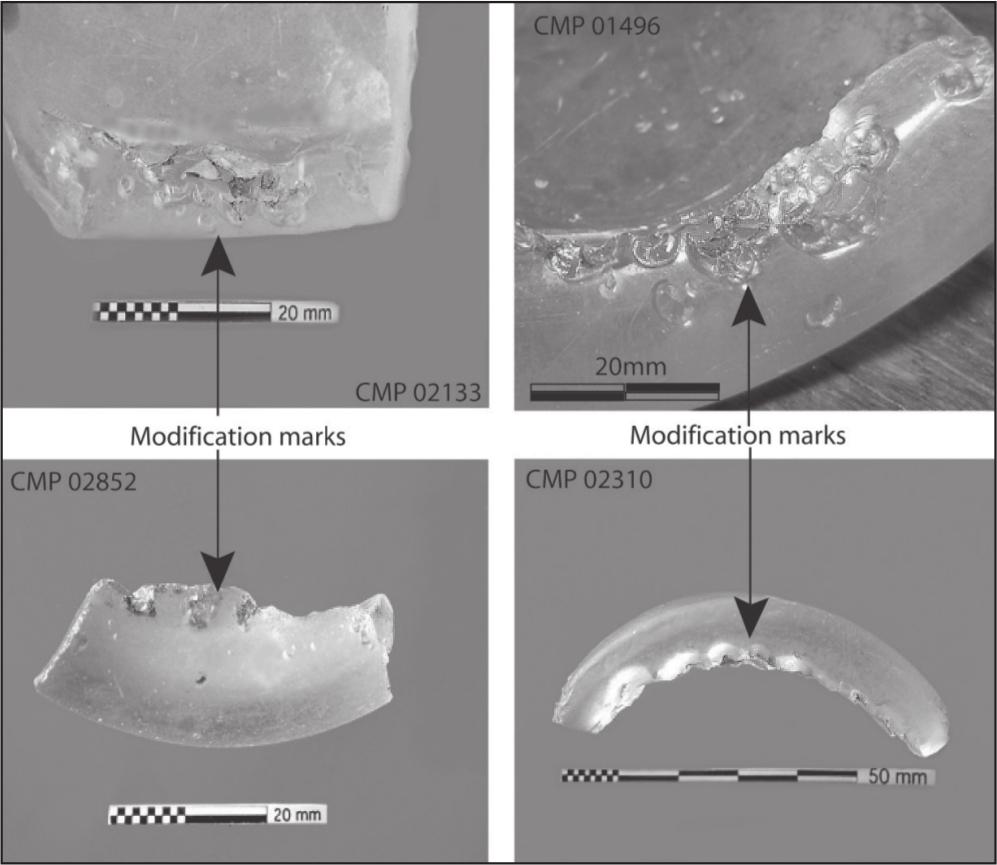
Figure 6.23 Deliberate modification marks are clearly visible on these bottle base fragments.
During Australia’s colonial period, domicile lamp bases and lamp chimneys were standard household items used for general lighting. Lamp chimneys are made of thin and delicate glass, with a range of standard base sizes up to and exceeding 75 mm in diameter (Cuffley 1973: 186). By using oil or kerosene lamp bases or any form of solid container to hold a wick or candle base, an aqua-green bottle without a base section would have made a robust lamp chimney (figure 6.24). The occupants at Chinaman’s Point may have produced such items for general domestic lighting purposes or for fishing at night. 113
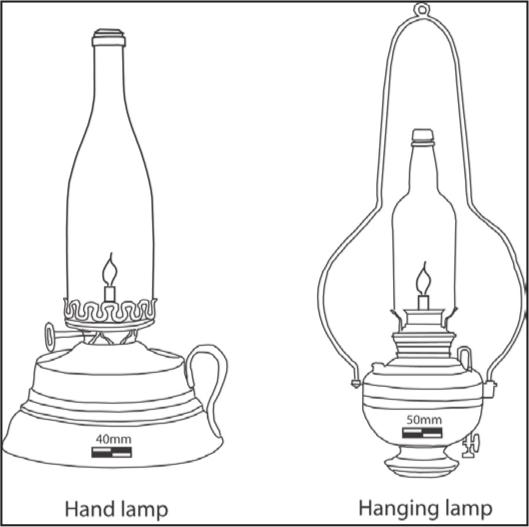
Figure 6.24 Reconstruction of oil lamps using modified bottles as substitute lamp chimneys.
In Wards’s (1954: 198, 203) anthropological study of a Chinese fishing village, she notes that fishermen often work at night using:
glass globes and mantles for the purse-seine fishermen’s bright lights … the bright kerosene lights are used to attract fish … bright cat’s-eye lights [can] be seen all around the coast.
An 1888 report to the United States Commission of Fish and Fisheries states that the Chinese fishermen of San Francisco also fished at night using “a boat with a blazing torch at the bow … to attract large schools of squid to the surface” (Collins 1892: 60). On 4 December 1873, the Illustrated Australian News reported on the Chinese fishermen at St Kilda, stating, “The fishing is chiefly carried on at night”. The method of fishing with lights at night to attract fish, particularly squid, to the surface is common in many parts of the world. In the 1880 royal commission into the New South Wales fisheries, Chin Ateak is asked if he has ever traded in squid. He replies, “The squid … plenty valuable … at Melbourne plenty of that; schooner send plenty up” (Votes and Proceedings of the New South Wales Legislative Assembly 1879–80, vol. 3: 1225–26). It is likely that the Chinese fish curers at Chinaman’s Point participated in night fishing and therefore required some form of light to attract fish. With a rolling boat, cold water and flapping fish, glass light covers would have broken easily and needed replacing regularly. It is conceivable that the deliberately modified bottle base sections represent the by-products from a candle, oil or kerosene lamp cover-making process.
Inkwells
Fourteen shards, weighing 139 g and representing a minimum number of five inkwells were recovered from Chinaman’s Point. Their colour is predominantly aqua-green, but some shards appear to have a subtle blue-green appearance, due to ferrous iron impurities in the glass ingredients (Lockhart 2006: 45). One bottle is a complete short bodied (32 mm high) cylindrical (48 mm diameter) shear-top inkwell, produced in a two-part mould (figure 6.25). Another is represented by the finish, neck and body fragments of a hexagonal-shaped shear top inkwell (possibly a Williams Australia type). Still another displays fragments from a smooth sided, cabin-shaped inkwell and two are represented by sections of a ribbed, shear-top, cabin-shaped inkwell, one of which has an ‘R’ or a ‘B’ embossed on its base.
Each inkwell represents a common type recovered from historical sites in Australia. They suggest that at least one occupant of the Chinaman’s Point site was literate. Land lease documentation discussed in chapter 7 reveals the English signature of Ah Hoo in association with short passages of ink writing on several colonial period documents. Ah Hoo may have had associates who helped with such official tasks, but the recovery of five individual inkwells suggests that writing (either in Chinese characters or other written language) was undertaken at the Chinaman’s Point fish-curing establishment. 114
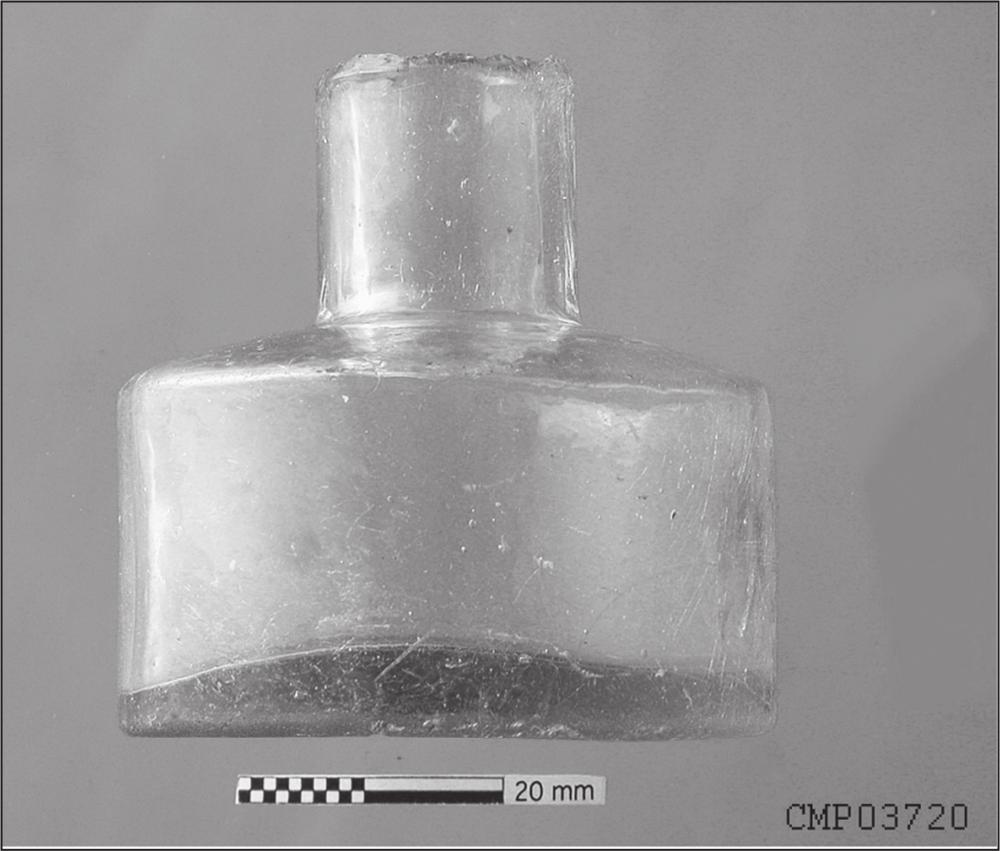
Figure 6.25 A cylindrical, short bodied, shear top inkwell from the Chinaman’s Point site.
Amber glass
Amber coloured bottles generally held beer, wine, tonics and medicines in a liquid, pill or powdered form, but sometimes contained other substances including aerated waters and domestic or industrial goods such as acids and cleaners (Vader & Murray 1975: 56, 58; Boow 1991: 17, 23). As with the greens, amber glass can occur unintentionally through iron impurities in the sand mix (Lockhart 2006: 45). However, by adding carbon to the glass mix a range of amber colours can be deliberately produced (Birmingham & Bairstow 1987: 154). The lightest coloured amber from Chinaman’s Point matches Munsell hue 5YR 8/6 and appears as a very pale translucent amber. A middle colour range for amber correlates with Munsell hue 5YR 4/8. The darkest amber could easily be considered a black, especially in the thicker sections. It is only by holding a broken edge up to the light that a dark amber is revealed, correlating best with Munsell hue 5YR 2/2.
A breakdown of amber glass fragment attributes can be seen in table 6.14. Fifty-one shards show embossing, mostly base numbers such as ‘M 69’ or ‘38 2 R’ or fragments of lettering that don’t allow their full meanings to be known.
| Shards | Weight (grams) | Base types | Finish types | MNI |
|---|---|---|---|---|
| 1236 | 1 4 617 | 29 | 8 | 90 |
Table 6.14 Amber bottle glass attributes.
One embossed shard shows its maker to be ‘Hamilton & Pulfer’ in ‘Bendigo’ and the letters ‘PHEN’ suggest it may have contained phenyl extract. Another amber body shard is embossed with ‘NOT TO BE’ suggesting it held some form of poison. Other embossed shards include fragments of lettering such as ‘Co Pty’, ‘HT2’, ‘TASMA’ and ‘NE &’. However, much of the recovered amber glass is without embossing or other forms of marked identification.
Aqua-blue/light blue
When glassmakers made clear and sometimes aqua-green glass, ferrous iron impurities in the glass ingredients often resulted in a very faint aqua-blue or aqua-green colour (Lockhart 2006: 45). Nineteenth-century glass makers accepted such slight colour variation as normal with neither colour actively intended. However, the aqua-blue and blue glass colour discussed in this section is slightly darker than these unintentionally occurring aqua-blue or greens and therefore seem to be a deliberately produced colour. This colour is made by adding quantities of cobalt or copper oxide when preparing a glass mix (Birmingham & Bairstow 1987: 154). At its lightest Munsell hue the aqua-blue is 2.5B 8/4, with a middle hue of 10BG 7/6, which is somewhere between aqua and light blue and the darkest shade of light blue is 2.5B 3/6. These coloured bottles are often oval or rectangular in design and are generally associated with medicines, cosmetics and specialities such as castor and eucalyptus oils (Valder & Murray 1975: 62; Fike 1987: 13; Davies 2001b: 70–71). They were produced with 115an array of finishes, but were most commonly fitted with applied single collars, formed with a flat, patent or prescription finish (figure 6.26) (Fike 1987: 8, 15; Jones & Sullivan 1989: 93).
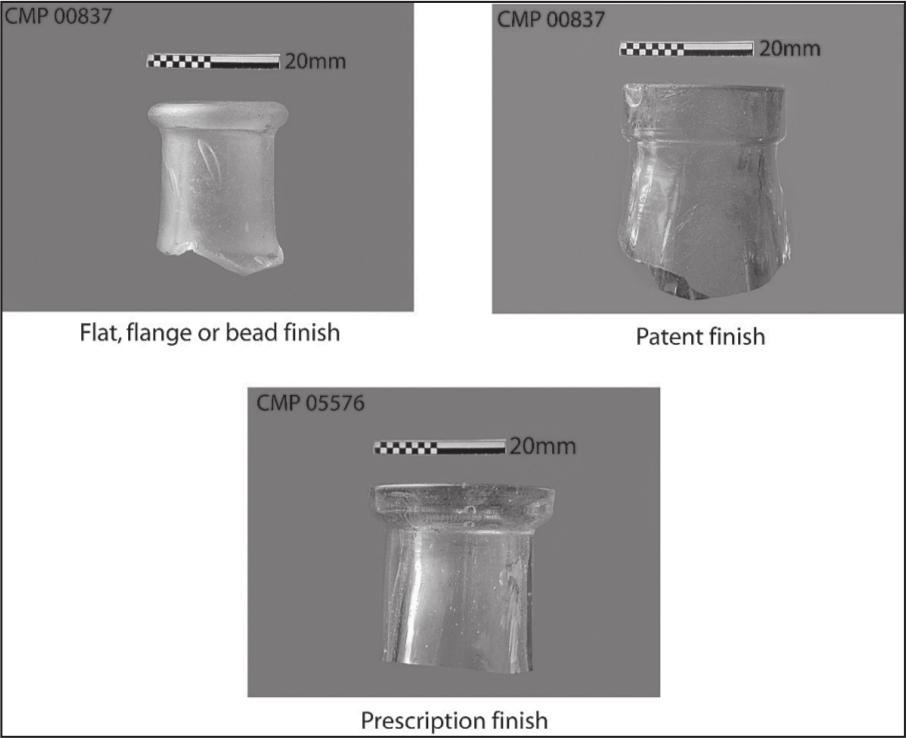
Figure 6.26 Examples of three common types of aqua-blue or light blue applied single-bottle collars or finishes from the Chinaman’s Point site.
A breakdown of aqua-blue/light blue glass fragment attributes can be seen in table 6.15.
| Shards | Weight (grams) | Base types | Finish types | MNI |
|---|---|---|---|---|
| 164 | 2127 | 20 | 6 | 26 |
Table 6.15 Aqua-blue/light blue bottle glass attributes.
Various embossed lettering was apparent such as ‘RT & Co’; ‘J’; ‘RI’; ‘IRE’; ‘EMP’; ‘MEDAL’; ‘TTE’ (possibly BITTERS); and ‘RPE & Co’ (possibly Robert Harper & Co Imports of Bendigo). The original contents of these bottles will perhaps never be known more accurately than a medicine, cosmetic or speciality oil. They add to the evidence that overseas Chinese people used some of the vast array of these types of products available in colonial Australia. Mainstream colonial-period medicines usually had an opium and/or alcohol content (Fike 1987: 3), but this was not advertised on the bottle and most consumers would have been unaware of the true contents and so it is unlikely these bottles represent a substitute for opium use. However, European medicines were probably used as alternative drugs, thereby demonstrating sampling, ordinary use or possibly even addiction to the standard medicinal products available during Australia’s colonial period.
Medicinal vials
In the archaeological literature, a degree of assumption surrounds this small, aqua-green, Chinese-style medicinal vial. Often discussed in the glass section of artefact analyses, it is generally accepted that they contained opium-based medicinal substances.
Numerous styles of Chinese medicinal vials have been recovered from overseas Chinese sites (see for example the appendix in Chandler 2005: 105–10). Ten glass segments weighing a total of 71 g and representing a minimum of five medicinal vials were recovered from the tidal zone at Chinaman’s Point. As these small glass bottles are unusual in appearance, artefact collectors often pick them up at overseas Chinese sites. Without exception, all Port Albert residents and artefact collectors interviewed for this project had a collection of these bottles, showing that the vials were once abundant at the site. Only one type was recovered from the Chinaman’s Point excavation or found in Port Albert residential collections. Their regular form shows they were made in a dip mould (Blanford 1987: 201), which produced a thick-walled bottle, slightly wider at the shoulder than base. All vials from the Chinaman’s Point site were aqua-green in colour. The glass typically contains many air bubbles, is ovoid or rectangular in cross section and generally measures between 55 mm and 62 mm tall and up to 14 by 12 mm wide (figure 6.27). The bottle neck and finish is plain, as if snapped straight from the manufacturer’s blower pipe and were possibly fitted after body manufacture. It is likely that a cork stopper – as opposed to a shear top or crack-top finish – was used to seal the bottle contents. These are the most common type of vial recovered from overseas Chinese sites in Australia. 116
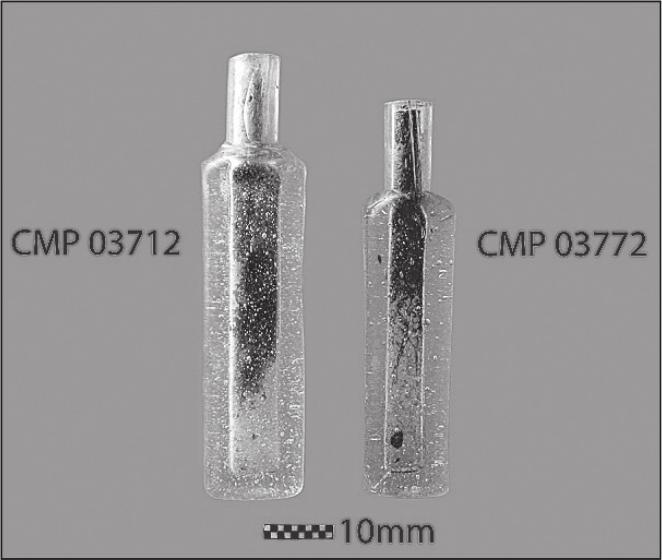
Figure 6.27 Medicinal vials recovered from the Chinaman’s Point site.
These vials are believed to have been manufactured in China (Ritchie 1986: 195) and are rarely recovered in a European context. Their association with opium is assumed given that most Chinese medicines (besides herbal medicine) from at least 1100 AD to approximately the mid-1900s contained liberal doses of opium (Zheng 2005: 12). Opium is partially soluble in water and in alcohol and very soluble in vinegar and in oil (Thomson 1845: 96). Opium would have been united with one or more of these substances to produce a range of Chinese medicines, which were then distributed in these small vials.
Evidence from the United States, New Zealand and Australia show that these particular vials contained more than one substance type. A vial recorded in the Asian American Comparative Collection (Catalogue No. Acc-89–45) has a cork seal and a red paper label with black printing that reads “U-I-Oil/Sole Manufacturer/ Wong Cheung Wah/Canton, China”. This suggests its contents were at least in part oil-based. From excavations at Cromwell’s Chinatown and elsewhere in New Zealand, Ritchie & Bedford (1983: 251–52) and Ritchie (1986: 195) recovered four vials containing visually distinct substances. Yet to be chemically analysed, they are a clear liquid, a dark brown liquid, a red powder and small dry grey pellets. One of Ritchie & Bedford’s vials displayed a paper label the same as the American example, reading “U-I-Oil/Sole Manufacturer/Wong Cheung Wah/Canton, China”. A further four medicine vials recovered by Ritchie (1986: 195) display Chinese characters that have been translated to indicate they once contained various ‘all-purpose’ remedies. Chandler’s (2005: 43, 106–07) compilation of artefacts from overseas Chinese sites in northeast Victoria – from private collections – includes Chinese-style medicinal vials containing substances that also are yet to be chemically analysed. Each vial is sealed with a piece of cork. Two vials contain a white powder, one contains a ‘yellowing’ powder (when in powered form, opium is yellowish in colour) (Thomson 1845: 96) and another contains a brown liquid and has an orange paper label again bearing the words ‘U-I-Oil, sole manufacturer, Wong Cheung Wah, Canton, China’.
Without knowing the chemical make-up of these vial contents, it cannot be determined what substances they contain – except perhaps something mixed with oil. However, with such visual variation in vial contents, Ritchie (1986: 394) appears correct in stating, “they contained a wide range of medical preparations”. That some of the vials had opium content seems almost certain. It also seems likely that some of the vials contained no opium content.
Most of the Australian and New Zealand literature discussing Chinese medicine vials suggests they served as a source of opium for addicted users after the drug became illegal to smoke in 1914 (1901 in New Zealand) (Ritchie and Harrison 1982: 28; McCarthy 1986: 36; Lydon 1999: 101; Galloway 2005: 127). However, as Chinese medicine vials are prolific at overseas Chinese sites where the occupation period ends before 1914, such as Chinaman’s Point, it is unlikely the vials represented an alternative source of opium in these cases. Moreover, when heavy tariffs were placed on imported opium for smoking purposes to the United States between 1883 and 1890 (and in Australia after 1901), the result was increased activity in Chinese opium smuggling operations, which created an increase in opium supplies for the general user. This continued well after the banning of opium smoking in Australia (The Chemist and Druggist of Australasia 1901: 369; Breacher 1972: 44; Sando & Felton 1993: 169).
Another notable result of the banning of opium smoking in the United States and Australia (in 1914 in both countries) was that it created an opening for the low-priced, purer and more easily smuggled opium variants such as heroin (diacetylmorphine) (Breacher 1972: 46–47; Sando & Felton 1993: 169). Heroin was developed in Britain in 1874 and by the 1890s had become available throughout the world (Manderson 1993: 5; Booth 1996: 77). Heroin may have been among the contents of the Chinese medicinal vials and may have some connection with the modified bottle bases discussed in association with ‘chasing the dragon’ (see discussion below under the heading ‘Alternative smoking method’).
117The abundance of opium-smoking equipment found at the Chinaman’s Point site is evidence that opium for smoking was a readily obtainable item. The recovered medicinal vials most likely represent the use of standard colonial-period medicinal treatments for medical complaints.
A further possible content of the vials is some form of laxative. A side effect of opium use – smoking or otherwise – is constipation. The British army used opium from the 18th century to treat dysentery (Booth 1996: 58) and until the mid 20th century, European doctors prescribed opium-based medicines as a cure for all forms of diarrhoea-related complaints (Muskett 1894: 52).
Clear glass
The cheapest and most common method of producing clear glass is to use sand that is as pure as possible – ideally 99.9% silica – then to add manganese to the glass mix (Birmingham & Bairstow 1987: 153–54). From the mid 1800s, the manufacture of clear (often called colourless) glass became popular and was used for an extremely wide variety of bottle and other products (Lockhart 2006: 45). A side effect of adding manganese to the glass mix is that with prolonged exposure to sunlight, the clear glass turns a transparent purple colour, with a Munsell hue varying around 5P 8/4 (Proh 1973: 24). Approximately 30% of the clear glass recovered from Chinaman’s Point displays a purple tinge.
A breakdown of clear glass fragment attributes can be seen in table 6.16. Sixteen shards display forms of embossing, most of which are unidentifiable single or broken sets of numbers and letters. The embossing ‘ON’S’, ‘GAR’, ‘ION’S’ and ‘R’ probably represents the London export Champion’s vinegar bottles (Boow 1991: 190). Other than vinegar, the original content of the clear glass bottles from Chinaman’s Point is unknown.
| Shards | Weight (grams) | Base types | Finish types | MNI |
|---|---|---|---|---|
| 285 | 1859 | 6 | 6 | 8 |
Table 6.16 Clear bottle glass attributes.
Shoulder and neck sections of bottle in the clear glass assemblage have been modified to produce opium heating lamp covers. These bottle sections are detailed with the opium related materials discussed below.
Discussion
Besides the Chinese medicinal vials and the two separate types of modified bottles, the diverse range of alcohol, medicines, condiments and other bottle types is typical of Australian colonial sites. Through glass analysis, a good insight into patterns of consumption and general lifestyles of site occupants has been obtained. While acknowledging issues of bottle re-use and the fragmentary nature of this assemblage, bottle glass from Chinaman’s Point is dominated by the types frequently associated with alcohol, most likely wine and sprits. Without solid reference to actual alcohol volumes consumed at the site – which is unobtainable due to glass fragmentation levels and artefact scavenger-activities – and without a good indication of site-inhabitant numbers, the site occupants cannot be categorised as either heavy or temperate drinkers. Recorded incidences of Chinese drunkenness are not common in colonial Australasia or the United States of America and overseas Chinese populations are referred to in the documentary record as generally sober (Staski 1993: 141; Adams 1997: 23). However, archaeological evidence from the majority of overseas Chinese sites suggests they were consumers of alcohol (see for example Langenwalter 1980: 106; McCarthy 1986: 36; Ritchie 1986: 167; Blanford 1987: 208; Stapp 1990: 194; Staski 1993: 141; Gaughwin 1995: 242; Smith 1998: 127).
It appears that the drinking habits of overseas Chinese people were consistent with Confucian values, which usually recommend moderate behaviour but appear flexible in regard to alcohol consumption, stating, “There is no limit to wine drinking, as long as one does not become disorderly” (cited in Passimore & Reid 1982: 402). Rather than a sustained sobriety, evidence shows that overseas Chinese people drank alcohol just as Europeans did, only the overseas Chinese drank in private, appear to have preferred gin and were rarely intoxicated in public. These findings are consistent with studies on other colonising nationalities, such as the work conducted by Staski (1984) in regard to colonial America’s traditional attitudes and the stereotypes of ‘drunken Irishman’ and sober Jewish Americans. In fact both groups were found to have been heavy consumers of alcohol.
Even though enormous quantities of Chinese domestic goods were exported from China to Australia, the glass bottles from Chinaman’s Point and other overseas Chinese sites are of non-Chinese manufacture. Chinese medicinal vials may be an exception. The absence of Chinese-produced glass at overseas Chinese sites reflects China’s limited glass-manufacturing industry in the 19th century (Ritchie 1986: 167; Staski 1993: 134). 118
Chinese stoneware
Two types of Chinese brown glazed, stoneware, liquid-storage containers were recovered from the Chinaman’s Point site: the liquor bottle and the spouted jar. See Table 6.17 for a summary of item quantities.
| Sherds | Weight (grams) | MNI | |
|---|---|---|---|
| Liquor bottle | 167 | 805 | 7 |
| Spouted jar | 63 | 545 | 19 |
Table 6.17 Chinese liquor-bottle and spouted-jar fragment quantities.
Liquor bottle
Chinese brown glazed liquor bottles, sometimes called tiger whisky bottles due to the occasional display of a tiger pattern stamped into their base, appear as tear-drop shaped containers with a carafe-type flared neck. These ceramic bottles held distilled liquor that is often referred to as Chinese wine, similar, but a little spicier in taste to European gin (observation by the author). It was produced from either a grain or starch base and is commonly associated with two types of very strong Chinese alcohol – mm ga pei (also ng ga Py) and mui guai lo (also mei guei lo) – traditionally used in cooking, medicines and for drinking (Anderson & Anderson 1977: 342; Passmore & Reid 1982: 403; Naquin & Rawski 1987: 74; Hellmann & Yang 1997: 182).
Chinese liquor bottles have a glossy, brown glaze that has been double-dipped in the glaze solution and fired at higher temperature to produce a better quality bottle than other Chinese brown ware vessels (Ritchie 1986: 232). They can also display considerable colour variation including light and dark browns, orange-brown, blue-brown, green-brown and black. The liquor bottle is also made of a much finer grain than other Chinese brown stoneware (Muir 2003: 45).
Flared rim sections suggest that a minimum of seven vessels are represented in the artefact assemblage. Base fragments are flat-bottomed as opposed to concave, have a 10 to 15 mm raised basal ring and range in diameter from 80 to 100 mm. Body sherds are on average 3 mm to 5 mm thick and display an internal and external glaze. Flared rim sherds have a 50 to 70 mm external diameter. No embossing or impressed characters were found on any of the liquor bottle sherds, nor do they show any post-production modifications or evidence of re-use.
Joins are clearly visible on the internal side of select sherds, indicating that the base, body and neck sections were separately produced and then joined to form each bottle (figure 6.28). This three-segment manufacture process for Chinese liquor bottles has also been noted by Ritchie (1986: 232) at sites in New Zealand and by Praetzellis & Praetzellis (1979: 22) at sites in the United States. The liquor bottles from Chinaman’s Point conform to the standard manufacturing process and typical size ranges of those recovered from other 19th-century overseas Chinese sites. They demonstrate use of alcohol for drinking, cooking and in medicines.
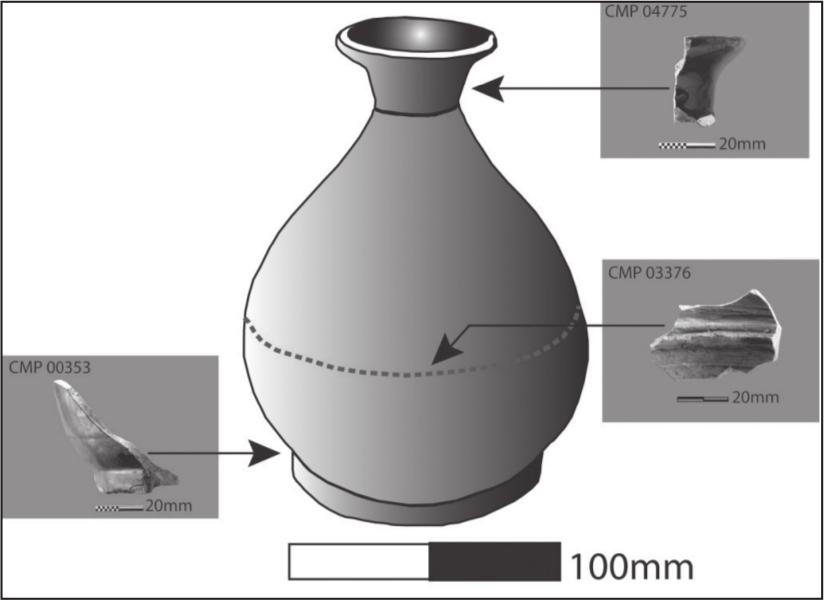
Figure 6.28 Drawing of a Chinese liquor bottle and pictures of artefacts from the Chinaman’s Point site (artefact 03376 shows internal ceramic join).
Spouted jar
Chinese brown spouted jars are commonly associated with the storage of soy sauce. Yang & Hellmann (1996: 5) have argued, on the basis of oral evidence, that they were also used to hold a range of cooking liquids such as spicy mild alcohols, vinegars, oils and molasses. Examples from Australasian sites show a fairly standard 119size and cylindrical shape, between 120 and 140 mm high, 140 to 150 mm in base diameter and with a squat body, outwardly rolled rim section and a protruding upper body spout (Ritchie 1986: 234, 237; Muir 2003: 45). Spouted jars of a smaller size have been noted from sites in the United States and square varieties have been recovered from sites in Canada (Quellmalz 1976: 294; Pastron & Garaventa 1981: 405–06; Wegars 1988: 45). Yang & Hellmann (1996: 5) suggest that in some rural areas of China, spouted jars were often re-used as teapots.
Each of the spouted jar fragments from Chinaman’s Point are cylindrical and are consistent with the standard squat shape and size recovered from other Australasian sites (figure 6.29). As mentioned above in the ‘Food storage’ section, base and body fragments from wide-mouthed shouldered jars are indistinguishable from those of the Chinese spouted jar. As only rim and spout sections were counted as spouted jars, there is a low representation of spouted jar sherds from Chinaman’s Point and quite a lot of wide/spouted jar sherds.
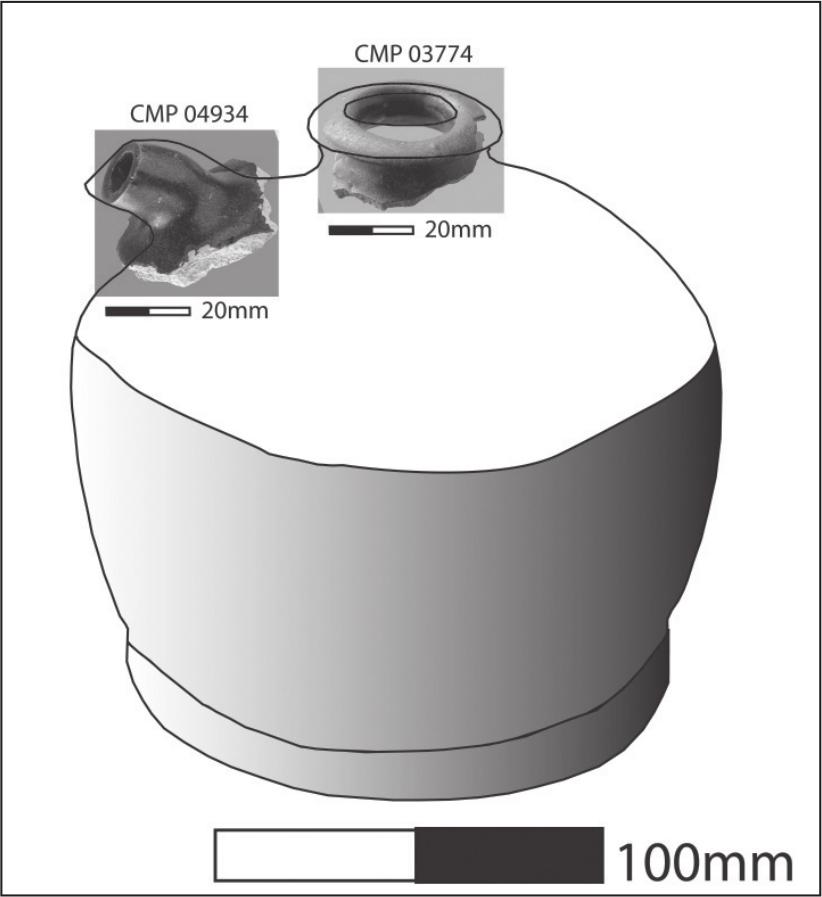
Figure 6.29 Chinese spouted jar and fragments from the Chinaman’s Point site.
The minimum vessel count for spouted jars was estimated from recovered rim sections. Rim fragments measured between 30 and 50 mm external diameters, with slight variations noticeable in the rim thicknesses, probably the result of production by hand. Fourteen spout sections were recovered, each approximately 25 mm long and displaying an average internal diameter of 15 mm. As discussed by Ritchie (1986: 237), the spouts appear to have been formed by moulding a short slab of clay around a stick to create a clay tube that was then pressed directly onto the vessel body.
Tableware
This section discusses objects used for serving and eating food. Ninety-seven and a half percent of the ceramics from Chinamen’s Point are of Chinese form, decoration and origin. The remaining 2.5% is European tableware. Similar disparities in the percentage of Chinese and non-Chinese ceramics at overseas Chinese sites are noted by McCarthy (1986: 12), Ritchie (1986: 205, 281), Mueller (1987a: 265), Staski (1993: 138), Gaughwin (1995: 234–35), Smith (1998: 114) and Lydon (1999: 143).
Asian porcelains, many of which are generically classified as Chinese tz’u (Medley 1976: 13), are frequently recovered from overseas Chinese sites. All of the recovered Asian ceramics have been identified as accurately as possible to be of Chinese origin. This is opposed to Japanese ware that is also regularly located in association with American overseas Chinese artefact assemblages and occasionally from Australasian assemblages – see Stenger (1993: 323–30) and Wegars (1998). The artefacts discussed below include Chinese bowls, spoons and teapots and European cups, bowls and plates.
Chinese tz’u sherds, their weight and minimum number of vessels are represented in table 6.18. European white ware, bone china and stoneware sherds are represented in table 6.21. Minimum number of vessel count was determined through rim and base fragments, design and decorative elements. 120
| Chinese tz’u | Sherds | Weight (grams) | MNI |
|---|---|---|---|
| Bowls | 181 | 580 | 19 |
| Spoons | 16 | 43 | 8 |
| Teapot | 54 | 427 | 2 |
| Total | 251 | 1050 | 29 |
Table 6.18 Type, number of sherds and MNI for Chinese tz’u ceramics
Chinese bowl
Recovered Chinese bowls were all Chinese porcelain of plain blue-green celadon, the three friends pattern or the double happiness pattern. These artefacts were recovered predominantly from area 4 and within the tidal zone at Chinaman’s Point.
Blue-green celadon, often called wintergreen ware (Olson 1978: 118; Sando & Felton 1993: 157) bowls were recovered in three sizes (figure 6.30; table 6.19).

Figure 6.30 Three sizes (50, 100 and 160 mm rim diameters) of Chinese celadon bowl from the Chinaman’s Point site.
| Celadon bowl | Rim diam. (mm) | Sherds | Weight (grams) | MNI |
|---|---|---|---|---|
| Wine cup | 50 | 12 | 74 | 4 |
| Teacup/rice bowl | 100 | 91 | 276 | 7 |
| Rice/serving bowl | 160 | 74 | 241 | 6 |
| Total | N/A | 177 | 591 | 17 |
Table 6.19 Chinese celadon bowl rim diameters and quantities.
Seven of these bowls have a manufacturer’s mark in underglaze cobalt-blue within the foot-ring of the bowl. Two base-mark types are apparent. The first type is similar to those recovered in New Zealand by Ritchie (1986: 212) which he suggests may be corrupted imitations of traditional Chinese manufacture marks, but still in some instances provide information on artefact date and place of manufacture. Hellmann & Yang (1997: 174) discuss these types of base marks, suggesting they represent Chinese poetry that was produced specifically as export porcelain. Jones (1992: 37) suggests these types of base marks “serve to further illustrate the ambiguities in interpretation of Chinese art and calligraphy”. The base marks from Chinaman’s Point are fragmentary pieces too small to be useful for specific bowl-type identification other than to confirm they are base marks of a Chinese nature, similar in appearance to those discussed by Ritchie, Hellmann & Yang and Jones. The second type of base mark represents a very basic, hand-painted, cobalt-blue underglaze containing a single or double circle type design (figure 6.31). The meaning of these marks is unknown, but they may represent an individual potter’s mark or a hallmark for a particular kiln or ceramic producer. 121

Figure 6.31 Manufacture marks in the foot ring of celadon bowls from Chinaman’s Point. Left type is the single or double circle design, right type are similar to those discussed by Ritchie, Hellmann & Yang and Jones.
Fragments of Chinese bowls with what appear to be double happiness or three friends bowl patterns were located at Chinaman’s Point (table 6.20). Both of these patterns are commonly found at overseas Chinese sites. Although the designs on the bowls are distinct, the small size of the recovered fragments hinders a definite identification of the pattern (figure 6.32). It is more accurate to identify these artefacts broadly as Chinese tz’u sherds.
| Sherds | Weight (g) | MNI | |
|---|---|---|---|
| Chinese bowl | 11 | 23 | 2 |
Table 6.20 Chinese bowl fragments displaying either the double happiness or three friends pattern.
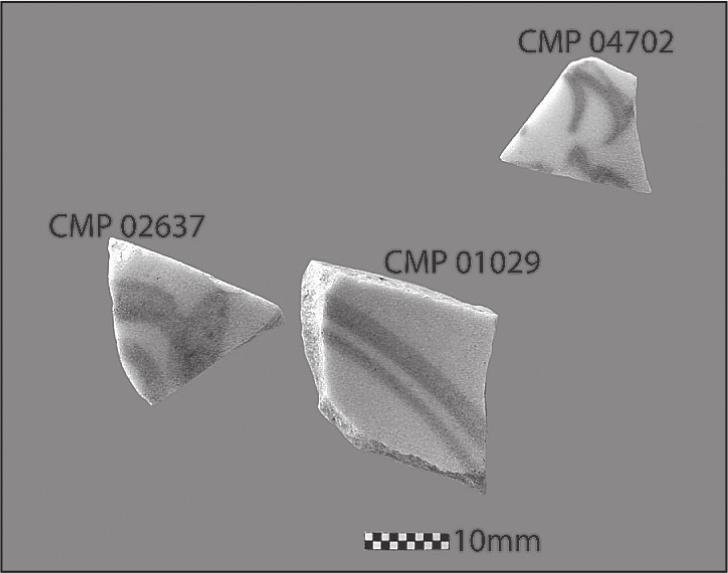
Figure 6.32 Chinese tz’u shards (either double happiness or three friends pattern) from the Chinaman’s Point site.
Chinese spoon
Each Chinese spoon sherd is of plain blue-green celadon, 3 to 4 mm thickness and represents a standard sized (approximately 50 mm across the spoon mouth), traditionally shaped Chinese soup spoon (figure 6.33). Such spoons – which often have an underglaze decorative motif – are used for eating soups and other liquid-based meals. They are commonly recovered at overseas Chinese sites (Muir 2003: 47).
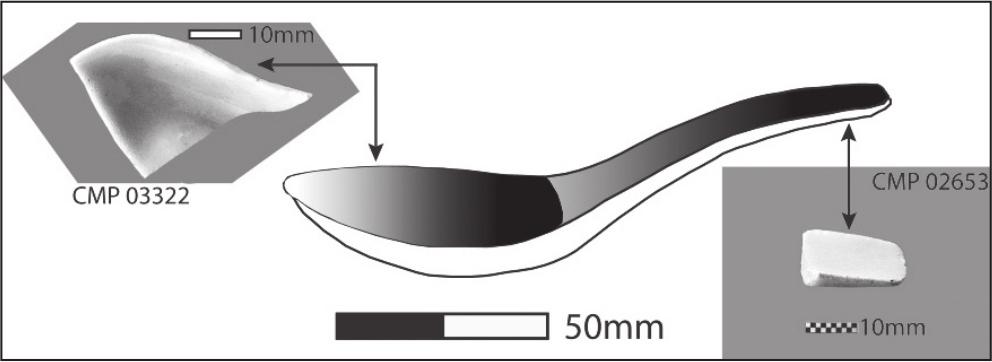
Figure 6.33 Chinese spoon sherds from the Chinaman’s Point site.122
Chinese teapot
Drinking tea could probably be considered a Chinese cultural activity. A Chinese legend states that the Emperor Sheng Nung, c. 2737 BC, observed that people who drank boiled water were less prone to disease than those who did not (Kan & Leong 1963: 229). Consequently, from approximately this period, tea drinking became increasingly popular among Chinese people. Tea was grown extensively in China from the fifth century AD and is often attributed as a major factor in the good health and productivity of Chinese populations (Mote 1977: 199). Ethnographic evidence from Anderson & Anderson (1977: 365) shows the teapot is an essential item in southern Chinese kitchens.
Porcelain teapot fragments represent a barrel shaped teapot, which is typically straight-sided with a central spout, then tapers from a high shoulder with opposing handles to form the smaller rim and lid sections. Two separate decorative forms of the barrel teapot were recovered from Chinaman’s Point. One represents a plain white teapot with a base diameter of 120 mm, a body of 2 to 4 mm thickness, a 170 mm long curvy spout, a rim diameter of 60 mm and an external lid diameter of 75 mm (figure 6.34). Only lid fragments remain of the second teapot. The lid sherds have an overglaze polychrome floral motif and an external rim diameter of approximatly 85 mm (figure 6.34).
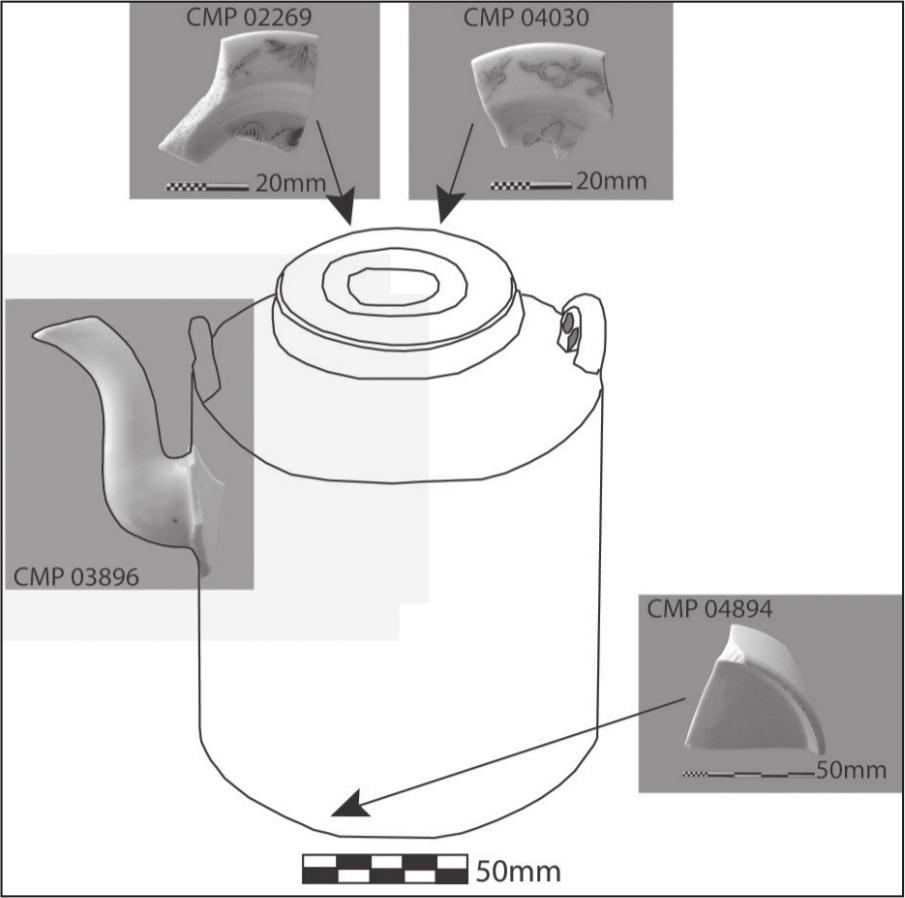
Figure 6.34 Two separate decorative forms (the plain white and the floral motif) of barrel-shaped Chinese teapot sherds from the Chinaman’s Point site.
European ceramics
Information to identify and analyse European ceramics came predominantly from Sussman (1985; 1997), Cameron (1986), Coysh & Henrywood (1986), Majewski & O’Brien (1987), Arnold (1990), Miller (2000) and Brooks (2005a). The type, number of shards and minimum number of vessels for European ceramics can be seen in Table 6.21.
White ware is a low fired, opaque, porous, mass-produced, affordable and very durable refined earthenware. During the 19th century, white ware was widely used to manufacture a huge range of plain and decorative tableware, toiletries and other basic utilitarian items (Brooks 2005a: 34). Recovered sherds consist of base, foot ring, side, marl and rim (ranging from 180 to 210 mm in diameter) sections and are of 3 to 7 mm in thickness (figure 6.35). The underglaze maker’s mark was visible on the underside of one white ware item. This mark represents the B & L beehive symbol from Hill’s Pottery in Britain. This artefact along with other white ware sherds is discussed further in the site-dating section of chapter 7.
Bone china is a coarse-bodied porcelain that was first introduced to Britain in 1794 as a soft paste porcelain. From early in Australia’s colonial history it was – and still is – imported to Australia in large quantities (Miller 2000: 9). Bone china occurs principally as plain or decorated tea ware and is most easily identified by an off-white body and micro-crazed glaze (Brooks 2005a: 27). Bone china was represented at Chinaman’s Point through the recovery of non-decorative cup and plate or saucer sherds (table 6.21). The cup was identified through an 80 mm diameter rim section of 2 mm thickness and the plate or saucer through a small fully glazed foot ring sherd, side sections of 2 mm thickness and a very small section of marl. 123
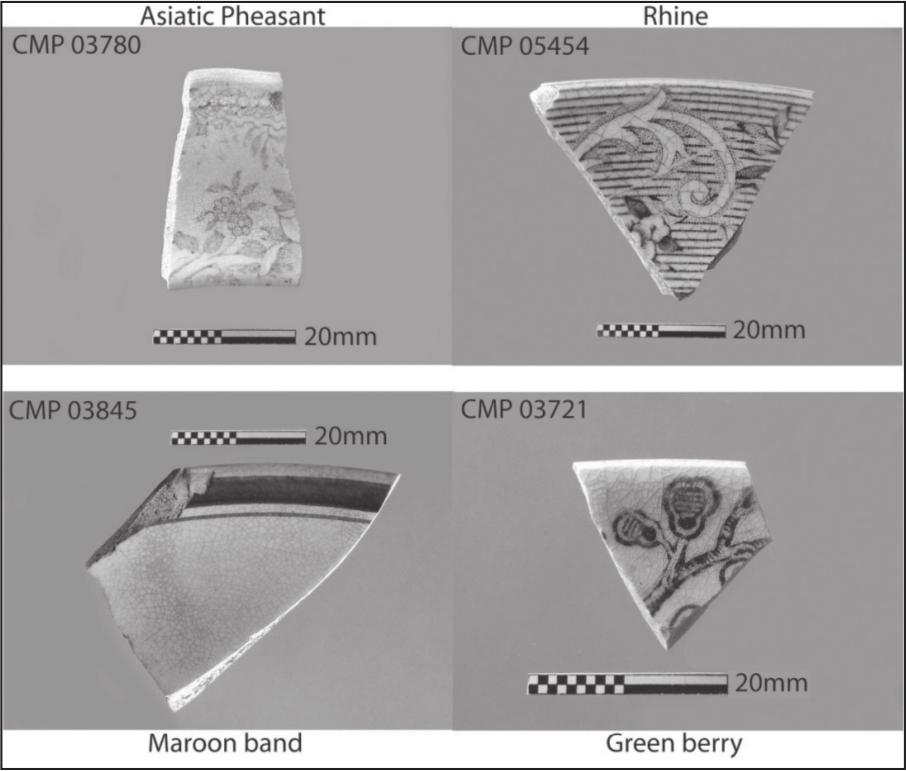
Figure 6.35 European plate ceramics from the Chinaman’s Point site.
Most ceramics from 19th-century Australian sites are of British manufacture and the Chinaman’s Point European ceramics were most likely also manufactured in Britain, although this can only be confirmed for the B & L beehive symbol artefact. As the recovered European ceramics from Chinaman’s Point represent only a small quantity of relatively cheap, functional utilitarian wares, their on-site presence is probably best explained as opportunistic and practical. Networks of Chinese trade extended to Port Albert and beyond, as evidenced in part by the large percentage of Chinese ceramics in the assemblage. The non-Chinese ceramics, along with nails, meat and other items purchased from European stores reinforces the notion that Chinese people had access to sources of supply for their general living requirements.
| European ceramic | Pattern | Number of sherds | Weight (grams) | MNI |
|---|---|---|---|---|
| White ware (plate) | Rhine | 21 | 102 | 2 |
| White ware (plate) | Asiatic pheasant | 6 | 22 | 2 |
| White ware (plate) | Maroon band | 5 | 18 | 1 |
| White ware (plate) | Green berry | 16 | 47 | 1 |
| White ware (plate) | Plain | 10 | 71 | 2 |
| White ware (plate) | Unidentified | 4 | 15 | 1 |
| Bone china (1 cup & 1 saucer) | Plain | 5 | 10 | 2 |
| Stoneware (jar) | Salt glaze | 11 | 145 | 5 |
| Total | N/A | 78 | 430 | 16 |
Table 6.21 Type, number of sherds and MNI for European ceramics.
INDUSTRIAL
Industrial components from Chinaman’s Point include artefacts considered to have an association with the procuring and processing of fish resources.
Fishing
Port Albert’s long association with the fishing industry has left considerable local and regional archaeological remains. There is a slight possibility that some remains relating to fishing from the Chinaman’s Point site have a European association. This is because European fisherman regularly visited the site to sell fish and because some items such as boat parts could have drifted with tidal movements from other regions into the site area. Where ambiguity over Chinese or European use of an artefact exists, brief discussion will be provided. 124
As argued in chapter 1, the Chinese-style artefacts found at the site, the place name ‘Chinaman’s Point’ and primary historical documentation confirm that Chinese people occupied the site. No newspaper reports, land title or other historical literature was located to suggest that European people had at any period occupied the site or near vicinity for fishing or any other purpose.
Anchor
A broken, heavily corroded and possibly homemade anchor was located in the tidal zone at Chinaman’s Point. The anchor is made of 30 mm round solid steel, with a 320 mm body length that turns at a 75º angle to form another 200 mm of shaft (figure 6.36). The stock is in place, but broken at one end and the anchor arms and flutes are missing. The presence of the anchor helps confirm that boats were a part of the working operations at the fish-curing site. In addition to its function of holding a vessel in place, an anchor was often used to secure one or both ends of a net to the ocean floor for net-fishing purposes (figure 2.4).
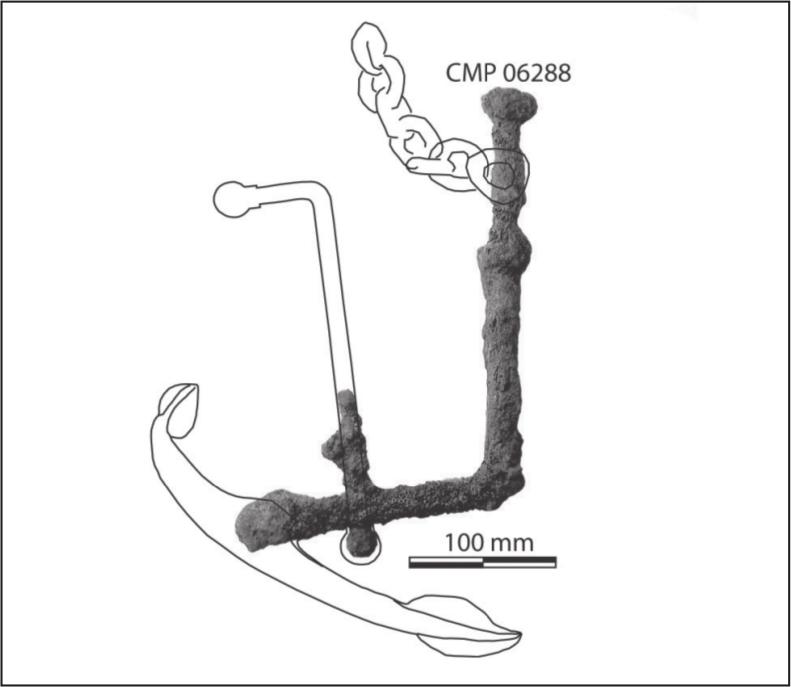
Figure 6.36 Corroded anchor remains from the Chinaman’s Point site.
Boat timbers
As mentioned in the architectural/structural section above, the remains of a slipway for boat maintenance were identified at the site. Four sections of broken, milled, softwood timber planks were recovered from the tidal zone and area 1 of the site. As with the timber jetty remains discussed previously, no scientific analysis of these timbers was possible due to financial restraints. However, Pearson (1992: 12) suggests that Victorian fishing vessels of this era were usually constructed with New Zealand kauri pine or Tasmanian huon pine for their outer timber planking. The recovered planks have a maximum length of 250 mm and all display nail holes, with one piece containing four square shaft copper nails and two pieces showing the remains of white oil-based paint. The planking, copper nails and oil-based paint are necessary for the construction and maintenance of boats, again suggesting the presence of boats at the site. As some of the boat timbers were excavated from the site’s ground layers and were found in the general vicinity of the slipway remains, they are considered to be associated with the Chinese period of occupation.
Dried paint
In addition to the painted planks, one white-coloured and two cream-coloured masses of hardened oil-based paint were recovered from the site’s tidal zone. These bodies of paint are still in the shape of the tins that once held them, the tin having rusted away (figure 6.37). The cream coloured paint mass is 115 mm in diameter and the white paint mass is 90 mm in diameter. Also within the tidal zone, several paint tin-rims were located, some with cream or white oil-based paint still adhered and matching the respective rim diameters of the hardened masses of paint. Oil-based paint may have been used to paint land structures and is also essential to protect boat timbers from the harsh marine environment. Part of the material evidence identified by Bowen (2004: 83) for early commercial fishing activities on the far South Coast of New South Wales includes “launch repair equipment such as copper nails … traces of oil-based paint and broken sections of launches”. The presence of these items at Chinaman’s Point confirms that these are expected items of recovery where early commercial fishing activities have occurred. 125
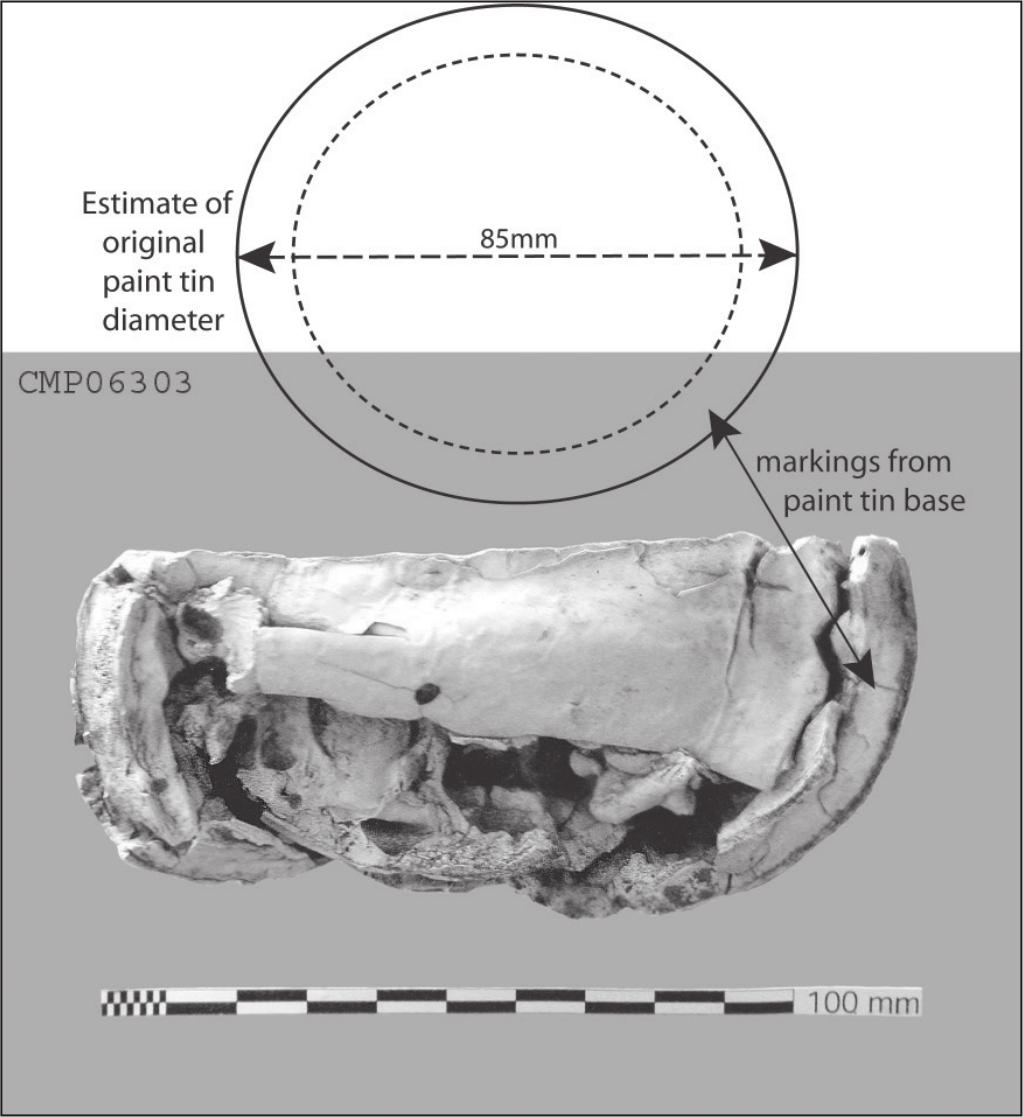
Figure 6.37 Mass of oil-based paint, still in the approximate shape of a paint tin, from the Chinaman’s Point site.
Copper nails
As copper is resistant to the corrosive marine environment, copper nails are often used for boat construction and maintenance purposes. Eight copper nails, weighing a total of 26 g – not including the four previously discussed as embedded in timber – were recovered from the tidal zone at Chinaman’s Point. Five of these are square shaft rose head type nails with 2.5 and 3 mm widths and of varying lengths between 25 and 95 mm. Three have 4 mm square shafts, a rose head on one end and a washer and the nail shaft hammered to form a burr on the other end. The smaller shaft copper nails are suitable for securing outer boat planking, which would be simply nailed to the vessel’s structural timbers. To secure two or more structural boat timbers together, copper nails were hammered through the timbers so that they protruded through to the outer side. A washer would then be placed over the nail and the end hammered until burred. This process is visible on copper nails from Chinaman’s Point (figure 6.38). Copper nails are further evidence of boat use, maintenance and perhaps construction at Chinaman’s Point.
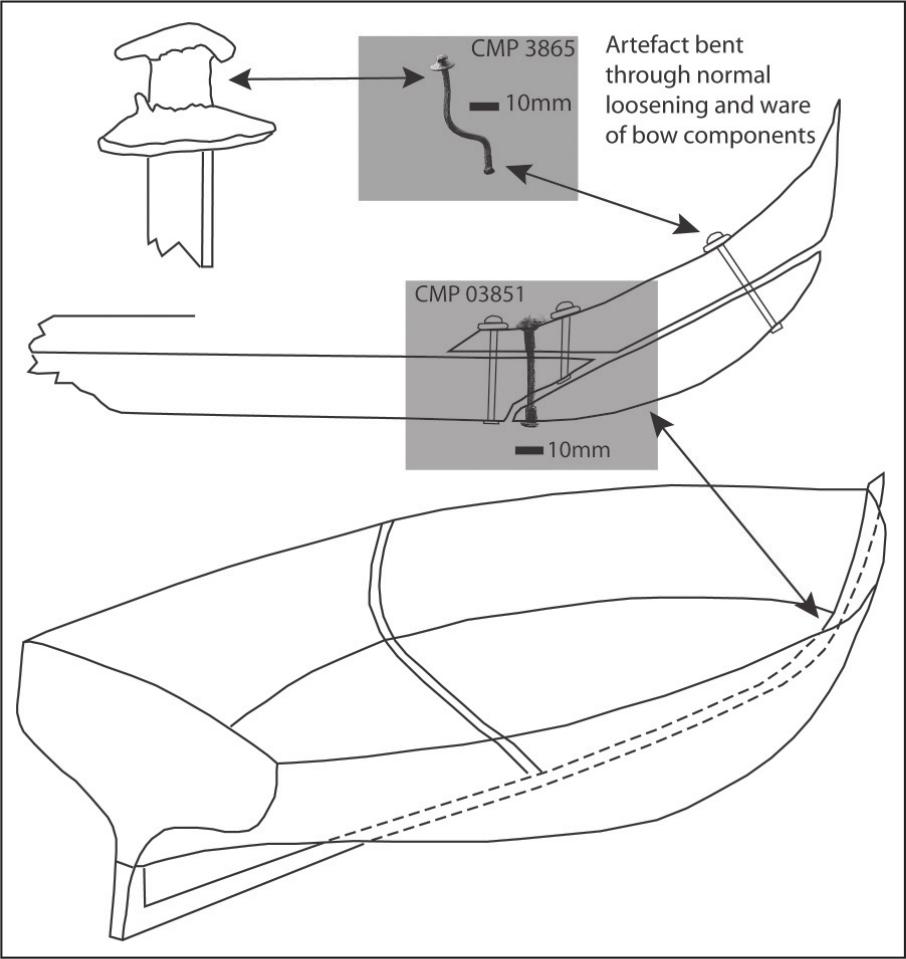
Figure 6.38 Deliberately burred copper nails from the Chinaman’s Point site suggesting the on-site existence of boats and boat-construction or maintenance activities.126
Net sinkers
Fishing nets, either cotton or hemp, require cork or glass net floats on their top rung to keep the upper net sections on the water surface and net sinkers on the lower rung to pull the net downwards. This ensures the fishing net hangs upright in the water. Twenty-two lead net sinkers and one line sinker, weighing a total of 284 g were recovered from the Chinaman’s Point site. All the lead sinkers were recovered from the site’s tidal zone except for one, which was excavated from area 4. Cut marks on the sinker edges suggested they had been cut with a pair of snips from lead sheeting between 1 and 3 mm thick, to various lengths between 30 mm and 60 mm. The flat lead sheeting was then presumedly rolled around the bottom rung of fishing net or some other cylindrical object to form a tube (figure 6.39). The net sinkers are in various stages of production, showing that they were manufactured on site. This was common among colonial European fishermen, who usually also made all their own nets (Chaplin 1985: 42).
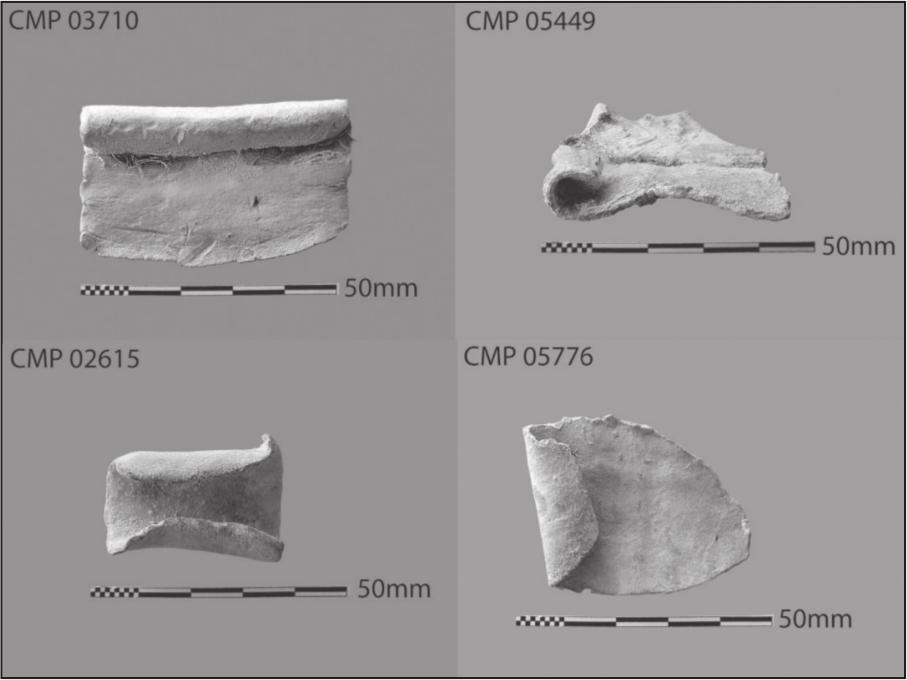
Figure 6.39 Selection of lead net sinkers from the Chinaman’s Point site.
The single line sinker is too light in weight to be a net sinker. It appears to be designed to trawl for barracouta (Thrysites atun), commercially popular in Victoria from the 1880s to the mid-1900s (Kerr 1985: 49; Evans 2003: 6). If the fishermen judged the fish to be on the surface, trawl lines were rigged with a hook lure. However, if the fish were swimming some distance below the surface, small tubes of lead were placed at approximately 350 mm intervals along the trawl line to sink the lure, enabling them to ‘fish deep’ (Evans 2003: 187).
The recovery of lead net sinkers from Chinaman’s Point provides further evidence of boat use by the Chinese fish curers. Importantly, the sinkers represent strong evidence that the site occupants themselves actually fished, as opposed to simply purchasing the catches of European fishermen. It is possible that some of the net sinkers represent objects fallen from European fishing nets whilst a catch was unloaded. However, dropped lead sinkers would be expected to stay in situ (probably around the proposed site jetty area) even with tidal movements. As these items were found in different site locations and in various stages of manufacture, their use is predominantly attributed to the site occupants. The line sinker is also significant as it suggests the Chinese fish curers were fishing with lines, which is not generally associated in the historical literature with overseas Chinese fishing activity in colonial Australia. However, as line trawling was not common in Victoria until the 1880s, well after the peak of overseas Chinese fishing activities in Australia, the recovered line sinker probably means the Chinese site occupants were involved in fishing activities after the 1880s, using the standard methods of the period.
Recording
Weighing instrument (balance scale)
Historical records show that during the colonial period – as now – fish were sold and purchased by weight. The Chinaman’s Point fish curers would have required some way to weigh each basket of fish they purchased or caught. They would also have needed to keep an accurate tally of basket numbers and weights, the quantities of different fish types and total weights. Evidence from the site suggests that balance scales, slate boards and slate pencils were used for this purpose.
Excavation of overseas Chinese sites occasionally recovers components of small, delicate, manually-operated balance weighing instruments called li-ding, which are generally associated with weighing opium or small quantities of gold (see for example Ritchie & Harrison 1982: 24, New Zealand; Stanin 2004b, Butcher’s 127Gully, Victoria). Chinese merchants and general buyers and sellers of food and other commodities used much larger balance scales, of which there are a great many varieties. Balance scales involve a balanced horizontal bar with an object of known weighted placed on one side of the bar and an object of unknown weight placed on the opposite side. The known weight is either added to or reduced until the bar remains exactly horizontal, thereby establishing the unknown quantity of weight.
The heavily corroded and broken remains of a large balance scale were recovered from the tidal zone at Chinaman’s Point. The scale has a T-shape and is made from a 22 mm diameter solid steel bar. The vertical section is 200 mm long and hooked at the end to allow it to be hung from a frame or suspended by rope or chain. The horizontal arm sections are slightly curved. One arm is approximately 200 mm long and ends with a downward-facing hook to hang the item to be weighed. The other arm is approximately 220 mm long with no hooked section, suggesting an arm that held a sliding counter balance weight. The centre T section is thicker, with a diameter of approximately 50 mm – now heavily corroded – possibly indicating where some form of horizontal indicator arrow was positioned (figure 6.40).
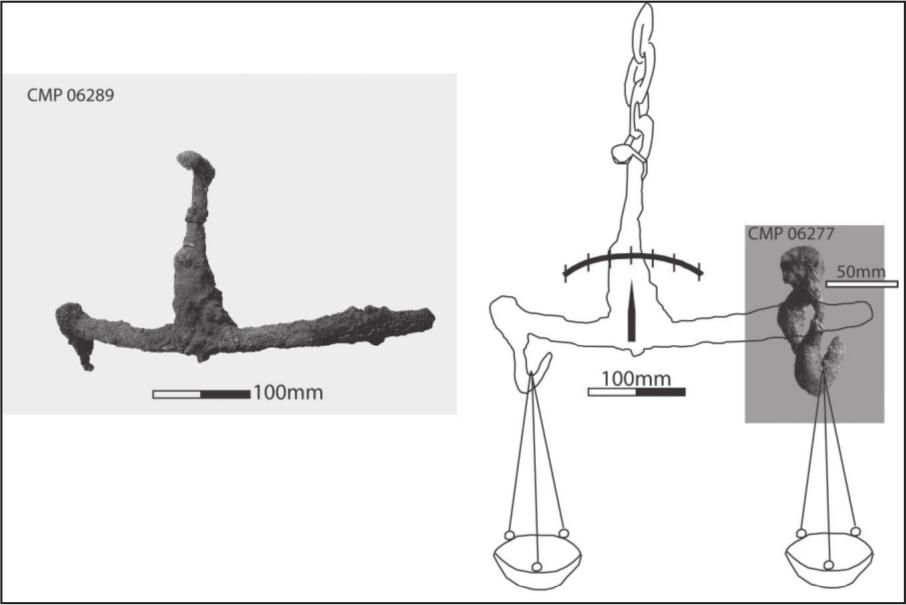
Figure 6.40 Corroded balance scales (left) from the Chinaman’s Point site and a reconstruction of the scales with a sliding counter balance hook (right) also recovered from the site.
Metal hook
A steel hook was recovered from the tidal zone. At its top is a closed circle with a finger grip and the hook is below (figure 6.40). This design suggests it may have been part of the sliding counter weight section of a balance scale. The hook is 133 g in weight and 110 mm long. The circular top is 30 mm in diameter and, although heavily corroded, displays wear marks as if it has been repeatedly pulled back and forth across a metal pole. It is likely that a rod (the horizontal arm of the balance scale) was fitted through the circle and the hook used to suspend a tray of counter weights.
The balance scales demonstrate the economic importance of the Chinaman’s Point site. The scales would have been central to European–Chinese interaction at the site and highly significant to both groups as the fish being weighed was the livelihood of both seller and buyer.
Slate board and slate pencil
Slate pencils and writing boards were commonly used during the 1800s and are often recovered from historical sites in Australia. Slate provided a cheap, effective, durable and reusable means of recording information in a temporary form (Davies 2005: 64). By the early 1900s, however, the popularity of slate writing equipment was in decline. It was still advertised for sale in Australia during the 1920s and used in primary schools until approximately 1945 (Mee 1927: 2645; Finlay 1990: 58). Generally, however, by the 1920s, wood-cased graphite pencils and sheet paper had become very affordable and rapidly became the more popular writing implements (Petroski 1990: 29).
One slate pencil and five broken pieces of plain slate writing board were recovered from the tidal zone at Chinaman’s Point. Slate writing board can be distinguished from roofing slate by its thickness and smooth polished surface. The pencil is 40 mm long, 6 mm in diameter and weighs 2 g. Each of the slate board pieces are 2 mm thick, blue-grey in colour, weigh 10 g collectively and three of the pieces display a chamfered edge (figure 6.41). These implements may have been used to record the weight of the fish baskets and to calculate how much money fishermen received for their catch. 128
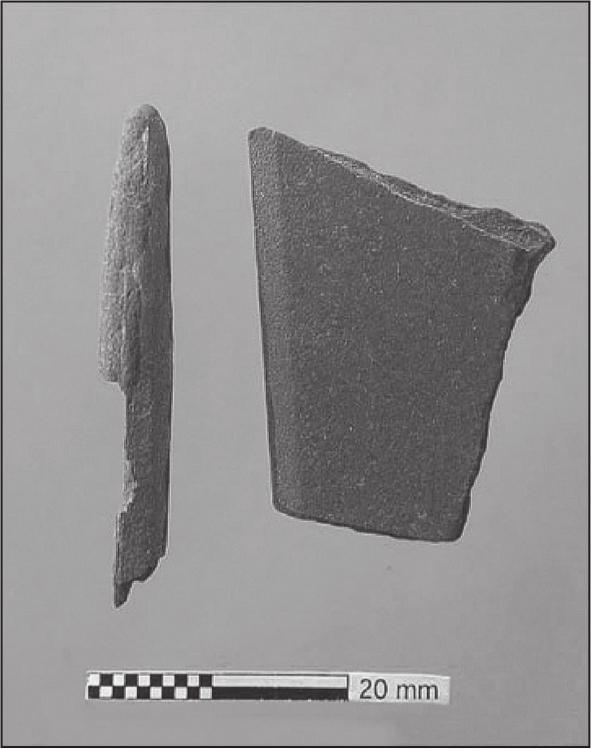
Figure 6.41 Broken slate pencil and writing board from the Chinaman’s Point site.
Slag
Slag (a by-product of smelting and usually industrial-related) is a complex mixture of inorganic materials that has been exposed to high temperatures and has failed to reach the full molten state of its co-conglomerate substances, eventually becoming a separate body of material (Raymond 1984: 55). Slag is extremely resistant to weathering, difficult to classify chemically and complicated to date (Bachmann 1982: 1). Two hundred and seventy-eight pieces of slag, weighing a total of 420 g were found at the Chinaman’s Point site. Most was recovered from the tidal zone, but a small portion was excavated from area 4. The slag consists of angular, black/grey, very porous lumps an average of 25 mm in diameter. As slag from a single smelting process produces “a sizable heap of waste” that is generally calculated by the meter cubed when encountered archaeologically (Bachmann 1982: 5), the recovered slag from Chinaman’s Point only represents a very small quantity.
Following Bachmann’s (1982) guide to slag identification, the slag from Chinaman’s Point appears to be a non-ferrous metallurgical slag with mineral inclusions, consistent with that produced from metal smelting. For the purpose of this project – cost reasons and the likely low value of information to be obtained – it was decided not to pursue chemical composition of the slag. The slag’s dark colour, very porous nature, lightweight and lump-like shapes indicate it is almost certainly the product of intentional or unintentional iron smelting. For iron to produce slag it must be heated to a minimum temperature of 1050°C (Bachmann 1982: 30). The heat from a normal surface-level campfire is approximately 500°C, but with a dug ground hearth or a hearth with built-up sides, temperatures can reach 1100°C (Maddin 1988: 264). This suggests the slag at Chinaman’s Point was produced in an enclosed hearth.
Nineteenth-century blacksmiths, several of whom operated in the Port Albert district, commonly travelled with a portable clay forge to undertake repair work and small manufacturing jobs (Adams 1990: 39). This ‘smithing’ produces slag as a by-product from hammering red hot metal, known as ‘smithing slag’ or ‘tap slag’ as opposed to smelting which generates lumps of slag (Bachmann 1982: 5, 31). Smithing slag tends to have smooth surfaces, a convex or concave shape, is fine and brittle and, when recovered archaeologically, is usually coated in a brown iron-oxide crust – unlike the slag recovered from Chinaman’s Point.
Due to the small amount of slag recovered, a controlled metal smelting operation at Chinaman’s Point seems unlikely. As iron smelting temperatures could be reached unintentionally in a ground pit or stone-lined fire, the slag from Chinaman’s Point appears to have been produced by metal objects attached to timber (such as nails or other metal objects), being thrown into a large enclosed fire.
Tools
Ammunition
Colonial fishermen faced the persistent problem of seals ripping holes in fishing nets. While sharks would opportunistically attack fish-laden nets, seals would deliberately follow fishermen, laying in wait until a net was ‘shot’ around a school of fish. Then, when the net was being hauled in, the seal would rip into the cotton mesh to get at the fish (Allan in Ellis & Lee 2002: 29). Colonial fishermen in Victoria would shoot seals on sight 129(Albert Clark 2003 pers. comm.). This provides a plausible reason for the recovery from the Chinaman’s Point site of one rim-fire percussion cap from a shotgun cartridge. As the faunal analysis does not show evidence of native game consumption, it is unlikely the site occupants used a gun for hunting purposes. It is also possible the cap represents a discard from hunters of a later period.
The percussion cap was recovered from within the tidal zone. It is made of brass and is comprised of the inner centre-fire primer section and the outer case head of an ammunition cartridge, most likely (due to diameter) a ten gauge shotgun (White & Munhall 1963: 8). The inner firing pin shows a distinct indentation mark from the striking of a hammer pin, indicating a spent cartridge. As a complete item, the outer ammunition casing would have been made of thin cylindrical brass, measuring approximately 22 mm in diameter, 60 mm long and dating from the 1850s onwards (Winant 1959: 207–08). This type of cartridge could have shot a single lead ball or a cluster of lead pellets. The dimensions of the inner percussion cap recovered from Chinaman’s Point are 10 mm in diameter, 5 mm long, 0.5 g in weight and with no evidence of a head stamp or maker’s mark (figure 6.42). It is conceivable that the spent cartridge left lying on a boat’s decking and had been thrown or somehow displaced from the vessel while docked at the site.
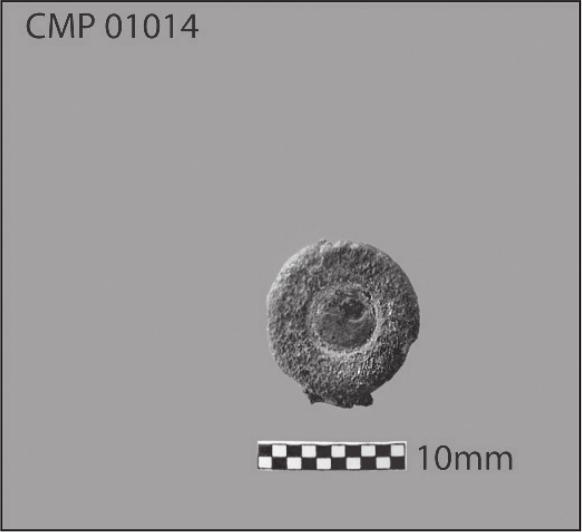
Figure 6.42 Spent bullet cartridge from the Chinaman’s Point site.
Bayonet or sword
Processing bulk quantities of fish for curing would have required an array of cutting implements. A broken section of what appears to be a bayonet or sword was recovered from the tidal zone of the site. Although heavily corroded, the object can be distinguished from a standard knife through blade thickness, a distinctive tapering to the end point – most of which is missing – and a double-bladed shaft.
The blade is 10 mm thick in the body, tapering on either side to form opposing blades that are 25 mm apart from edge to edge, 114 mm long from the broken tip end to the broken shaft end and 82 g in weight (figure 6.43). As this artefact is associated with a fish-curing site, it probably had an on-site purpose other than weaponry. A full-length bayonet or sword would be too long for use as a domestic or occupational tool. However, the blade is broken at 114 mm long, which could conceivably allow it to be used in tasks such as gutting, scaling, heading and portioning the fish processed at Chinaman’s Point.
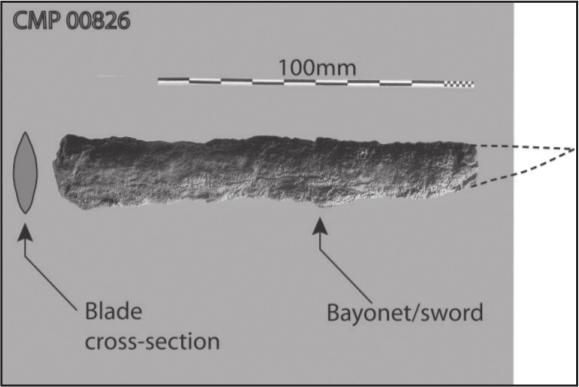
Figure 6.43 Corroded and broken section of a bayonet or sword blade from the Chinaman’s Point site.
The blade’s corrosion hampers an accurate identification. From pictorial evidence in books displaying common swords of the time, possible matches include early-style British and American cutlass or infantry swords (pictured in Peterson 1956: 263, 275), or 19th-century Australian infantry bayonets from the short rifle, artillery carbine or Martini-Henry rifle (pictured in Skennerton 1988: 15, 18, 36). Acknowledging the ethnic nature of the site, the blade could equally represent one of a number of Chinese iron sabers (see Trousdale 1975: 60). 130
Horseshoe
Three broken sections of horseshoe, representing a minimum number of two complete horseshoes, were recovered from within the tidal zone at Chinaman’s Point. During Australia’s colonial period, horses were the principal mode of land transport and horseshoes were very common. One horseshoe piece has two complete nails still positioned within the shoe eyelets and a 100 mm outer radius that indicates it came from a pony rather than a horse. The two remaining horseshoe pieces have portions of nail still attached and a 150 mm outer radius. The combined weight of the three pieces is 63 g.
The Chinese fish curers at Metung owned two packhorses that they used to cart cured fish to the Chinese miners on Gippsland’s goldfields (Bell in the Bairnsdale Advertiser 1955, September 5; Halstead 1977: 32; Tomlin et al. 1979: 101). There was also a great deal of European-operated bullock and packhorse movement between Port Albert and Gippsland’s goldfields (Adams 1997: 6; Olsen 1974: 119). It is possible that the Chinaman’s Point fish curers had a horse or horses for transport of goods. However, as there is no supporting historical documentation for this and no other horse-related items were recovered from the site, the horseshoe remains seem more likely to have come from horses visiting the site either during or after the Chinese occupation period.
Cleaver
Cleavers are used by Chinese people for chopping, slicing and crushing a myriad of items. An anthropological study of foodways in southern China (Anderson & Anderson 1977: 364) observed the versatility of Chinese cleavers, stating that they are used for:
splitting firewood, gutting and scaling fish, slicing vegetables, mincing meat, crushing garlic (with the dull side of the blade), cutting one’s nails, sharpening pencils, whittling new chopsticks, killing pigs, shaving (it is kept sharp enough, or supposedly is) and settling old and new scores with one’s enemies.
Cleavers are often recovered from overseas Chinese sites (see McCarthy 1986: 53; Stapp 1990: 209). Although a multi-functional tool, Chinese cleavers are generally described – archaeologically or otherwise – in association with meat butchering and other food preparation (Levine 1921: 8; Passmore & Reid 1983: 33; Longenecker & Stapp 1993: 117). They are easily identifiable from European style cleavers by the Chinese preference for a curved blade: as put by Levine (1921: 13) when describing Chinese butchering practices, “for cutting through the flesh … a curved blade is best”.
One almost-complete, but heavily corroded Chinese-style metal cleaver was recovered from the tidal zone at Chinaman’s Point. It is 180 mm long, 55 mm wide, 9 mm thick on the top side which tapers down to the blade section and weighs 367 g (figure 6.44). As it is likely that this cleaver was sometimes, possibly even predominantly, used by the Chinaman’s Point fishermen to process fish it is therefore considered an industrial component of the site for the purpose of this project.
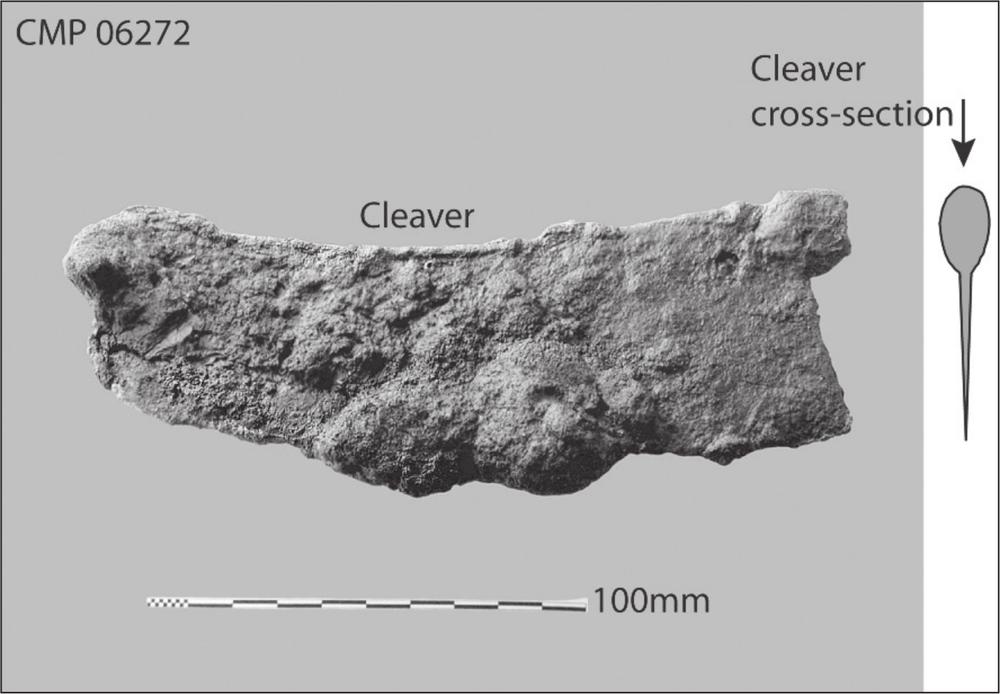
Figure 6.44 Corroded Chinese-style metal cleaver from the Chinaman’s Point site.131
PERSONAL
Personal components from the site include artefacts originally manufactured for individual personal use. The only items in this category from the Chinaman’s Point site are clothing buttons.
Buttons
Due to the rapid deterioration of personal clothing, archaeological excavations only occasionally reveal analytically useful items. Buttons, generally the most robust parts of clothing, are the exception and are valuable for dating purposes and in interpreting style, status and gender of the wearer (Lindbergh 1999: 50). Six buttons were recovered from the site (table 6.22). Five buttons were recovered from the tidal zone at Chinaman’s Point and one button was derived from excavation area 4.
Five of the buttons are pressed glass, two-hole, undecorated, opaque milk, British-style, utilitarian, 12 mm in diameter and associated with cuff collar and shirt fasteners from clothing such as cotton and linen shirts and underwear (Cameron 1985: 113, 153). The remaining button is a metal copper alloy, four-hole, 14 mm diameter button, stamped with the quality mark ‘BEST MAKE’ (figure 6.45). This type of button was used in durable trousers, overalls, suspenders and coats (Cameron 1985: 20; Lindbergh 1999: 51–52).
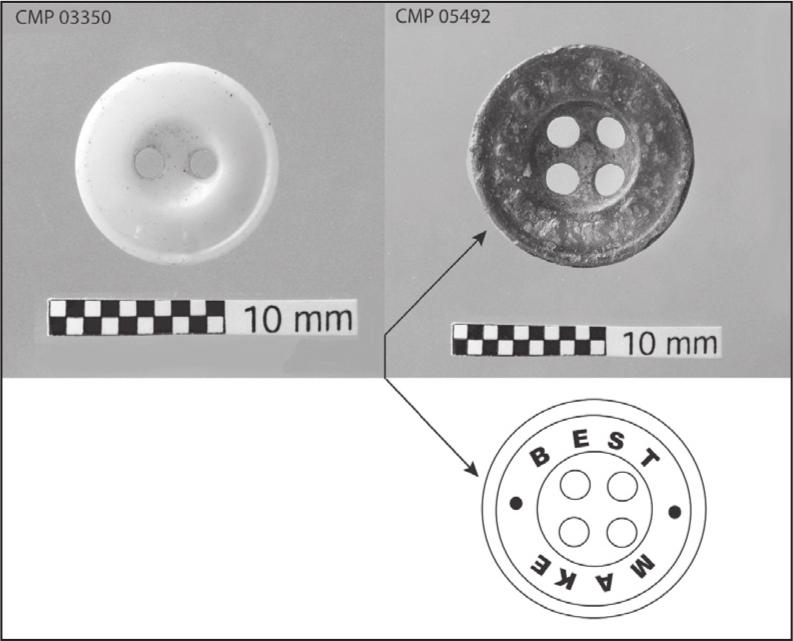
Figure 6.45 Glass (left) and metal (right) buttons from the Chinaman’s Point site.
The buttons from Chinaman’s Point are consistent with common, utilitarian-type, colonial-period clothing fasteners that were designed typically for men’s work clothing. In a study of buttons from 19th-century whaling sites in Tasmania, George (1999: 12, 62) found that whalers favoured bone or copper alloy buttons, as these materials would withstand the corrosive saltwater environment in which they worked. The glass and copper alloy buttons from Chinaman’s Point complement George’s (1999) findings, showing that the Chinese fish curers also had a preference for non-corrosive buttons. The potential for these buttons to aid in dating the site occupation period is discussed in chapter 7.
| Button material | Number of buttons | Sew holes | Weight (grams) |
|---|---|---|---|
| Milk glass | 5 | 2 | 0.4 |
| Copper alloy | 1 | 4 | 0.6 |
| Total | 6 | N/A | 2.6 |
Table 6.22 Type and number of recovered buttons.
RECREATIONAL
This category comprises artefacts created originally or through modification for the purpose of individual or group enjoyment. All artefacts that have an association with recreational activities at Chinaman’s Point – besides alcohol consumption – are related to opium use. Materials, number of pieces, weight and minimum number of individual ceramic opium smoking bowls, metal opium-bowl connectors, glass opium-lamp covers, opium-can remains and Chinese-style medicine vials can be seen in Table 6.23. Opium use by overseas 132Chinese people has been documented through historical accounts and archaeological remains in Australia, New Zealand and the United States. Opium-related artefacts from Chinaman’s Point are interpreted primarily through the aid of Etter (1980), Ritchie & Harrison (1982), Ritchie (1986), Hodgson (1999), Sando & Felton (1993), Wylie & Fike (1993), Wilton (2004), Galloway (2005) and Zheng (2005).
| Opium related item | Material | Number of pieces | Weight (grams) | MNI |
|---|---|---|---|---|
| Smoking bowl | Ceramic | 47 | 87 | 32 |
| Bowl connectors | Brass | 2 | 4 | 2 |
| Lamp bases | Glass | 41 | 1540 | 41 |
| Lamp covers | Glass | 19 | 249 | 12 |
| Medicinal vials | Glass | 10 | 71 | 5 |
| Opium can | Brass | 27 | 39 | 2 |
| Total | N/A | 146 | 1990 | 103 |
Table 6.23 Representation of opium-smoking equipment.
Opium smoking
The opium poppy (Papaver somniferum) was introduced to China from southern Europe several centuries ago (Courtwright 1982: 64). This highly addictive drug was initially used for medicinal purposes as it blocks messages of pain to the brain, effectively relieving symptoms associated with coughs, colds, poor respiration, gastric complaints, laryngitis and many other illnesses or painful conditions (Hodgson 1999: 17). However, it is opium’s ability to induce feelings of contentment and to alleviate anxiety that rapidly entrenched its popular use in all levels of Chinese society (Zheng 2005: 56), not only as an ingested medicine, but also, by approximately the 1600s, as a recreational indulgence (Encyclopaedia Britannica 1981: 1052; Wylie & Fike 1993: 256). By the 1850s and the beginning period of significant Chinese movement into Australia, opium use had become a way of life and many Chinese people were addicted to smoking opium (Wilton 2004: 66).
In Australia, opium was a legal all-purpose panacea of the colonial period and the early 1900s. It was available from general stores and was a component in common remedies such as Allen’s Irish Moss Gum Jubes and Mrs Winslow’s Soothing Syrup. Opium was also used in medicines such as laudanum and Chlorodyne, which were principally mixtures of opiates laced with a generous dose of alcohol. European addiction to opium was also common in colonial Australia (Phillips 1978: 84; Hodgson 1999: 2).
With the movement of Chinese people to colonial Australia, the Chinese technology for smoking opium was brought to Victoria (Wilton 2004: 68). It was during this second half of the 19th century that non-Chinese people in Australia, including some Aboriginal people, began to smoke opium, as opposed to ingesting the drug through medicines (The Chemist and Druggist of Australasia 1901: 85, 241; Manderson 1993: 32; Adams 1997).
It is difficult to estimate accurately how widespread opium smoking was among overseas Chinese people in colonial Australia, especially given that many overseas Chinese people only smoked opium occasionally as a casual social activity (Galloway 2005: 67) and that colonial European accounts of Chinese opium use are ambiguous. Wylie & Fike (1993: 257) suggest that in China between 1870 and 1890, approximately 10 to 30% of Chinese people smoked opium. Ritchie (1986: 365) indicates that in colonial New Zealand, approximately 60% of the overseas Chinese population smoked opium. In the Victorian goldfields in 1868, Manderson (1993: 22) estimates that as many as 90% of overseas Chinese people smoked opium. In 1868, Reverend Young returned from touring each of Victoria’s mining districts to report that approximately half the Chinese population in Victoria smoked the “evil … injurious … wretched … wicked … disastrous … monster” drug opium (cited in McLaren 1985: 53).
The most common method of recreational opium use by Chinese people was to smoke it through a specially designed implement that was comprised of four main components: a smoking bowl, bowl connector, a ‘gee rag’ and a pipe (figure 6.46). The bowls are a broad-cupped shape and have a convex lid with a small central hole and a cylindrical base flange/connector that joins to the pipe, which is usually made of bamboo. The ‘gee rag’ is a piece of cloth that enables a tight fit between the base flange and the pipe, also acting to collect ashes and unburnt opium particles, which were re-used (Etter 1980: 99). A constant flame was required (generally in the form of a specialised opium lamp) and a knitting-needle shaped implement used to pick up and manipulate 133
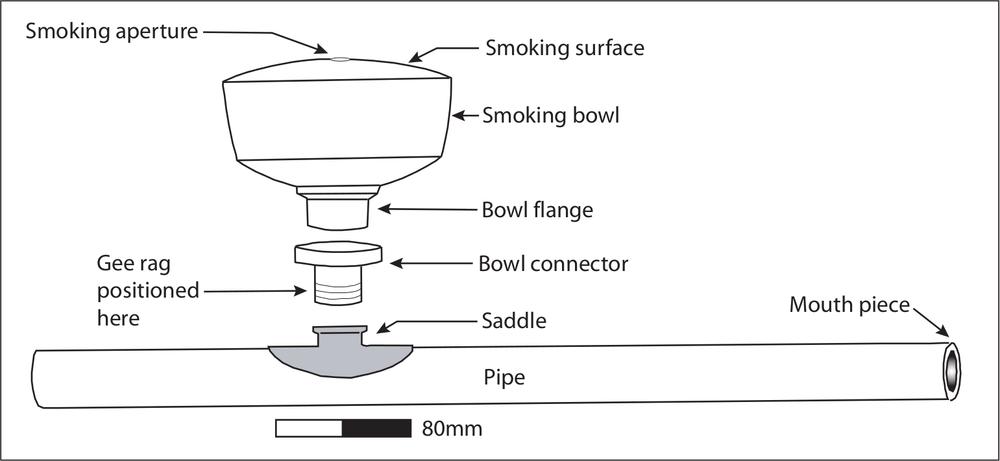
Figure 6.46 Opium smoking pipe, bowl and other parts. Opium is placed over the smoking aperture and then held over a flame.
Etter (1980: 99) provides a good description of the use of an opium pipe:
Smoking opium was a viscous liquid – like Molasses – and had to be cooked before smoking. A pea-sized portion of opium was impaled on the needle and heated over the cooking lamp until it became soft, like gum, as its moisture evaporated. The smoker then placed the opium-laden needle into the aperture of the pipe bowl and withdrew the needle. The opium remained on the top of the bowl, around the aperture like a small doughnut. Ideally, the smoker reclined on a couch and holding the pipe at an angle to the flame of the lamp, inhaled and sucked the flame against the opium. The opium burned to smoke and the smoker breathed this in, much cooled down through the pipe.
Slight variations to this process have been noted by Ritchie (1986: 367) and Wylie & Fike (1993: 259–60). Both authors quote a description of opium-smoking procedures written in 1881 by Dr. H. H. Kane of New York.
Opium smoking bowl
Opium bowl and bowl segments are frequently recovered from overseas Chinese sites. An integral component of the opium-smoking process, bowls are manufactured predominantly from earthenware or stoneware to form an array of shapes, although the basic design (figure 6.46) always remains the same. Opium-bowl sizes are typically between 40 and 50 mm in height and 50 and 80 mm in diameter (Etter 1980: 99).
A fragmentary assemblage of ceramic opium smoking bowl sherds was recovered from the tidal zone at Chinaman’s Point. The sherd count, weight and minimum number of individual bowls can be seen in table 6.23. The bowl type was ascertained through smoking surface shape, body shape and decorations. The minimum number is estimated through colour and flange-piece counts. While the assemblage fragments did not reveal how a complete bowl would have looked, they would likely have been similar to the bowls shown in figure 6.47. Eighteen percent of the sherds, representing two separate bowls, are of stoneware and the remainder are earthenware. Etter (1980: 100) and Wylie & Higgins (1987: 346) suggest earthenware bowls were the cheaper variety and more likely to be recovered from worker camps. Twenty sherds display distinct fingerprint marks on their inner surface, which is consistent with Ritchie’s (1986: 369) and Wylie & Higgins’s (1987: 336) observation that bowl smoking surfaces and body sections were manufactured separately then joined together by hand while the clay was still wet, before firing. 134
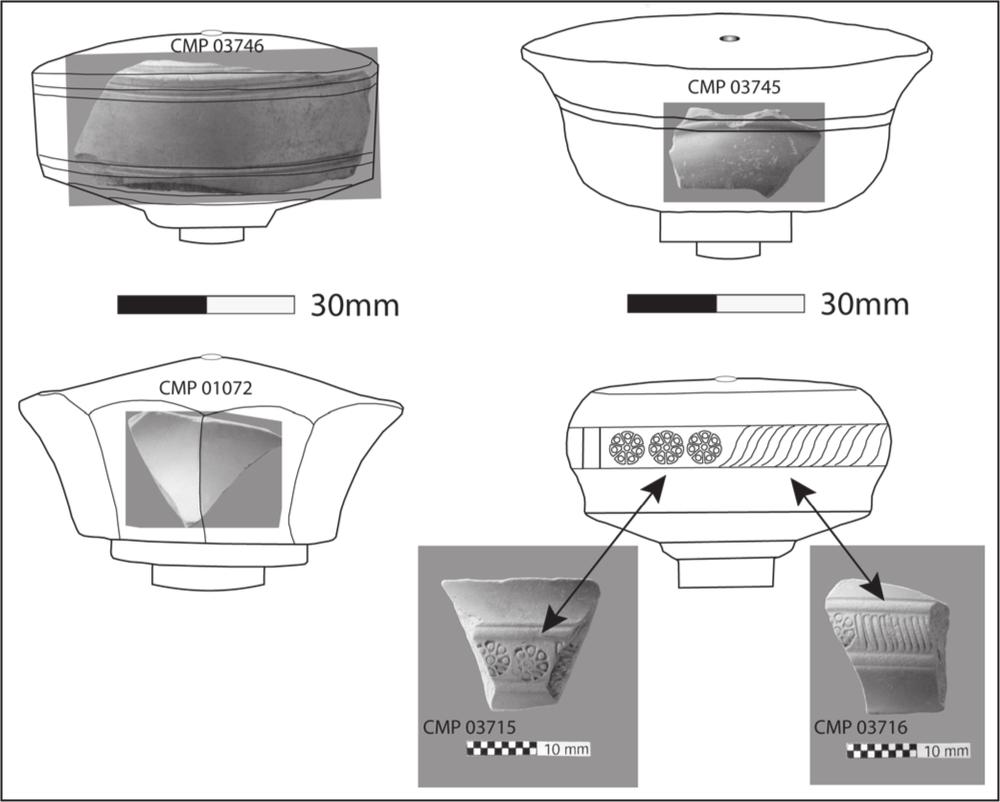
Figure 6.47 Common opium smoking bowl shapes, designs and artefacts from the Chinaman’s Point site.
Three different clay colours are evident in the bowls: a black stoneware with an internal and external slip glaze; an orange/tan slipped and un-slipped earthenware (the most numerous type of recovered sherd) and grey earthenware with an external slip glaze. Four variations within the bowl finish are noticeable: no slip, an orange/red slip, a brown slip and a highly fired black glaze.
Charring is apparent on approximately 23% of the bowl lid/smoking surfaces recovered from Chinaman’s Point. Ritchie (1986: 367) observed char marks on 50% of the bowl smoking surfaces recovered from his New Zealand study. While Etter (1980: 99) suggests the opium was placed on the outside of the bowl’s surface, Ritchie (1986: 367) and Wylie (1980: 3) refer to a method where the prepared opium is placed inside the bowl, therefore requiring the flame to have actual contact with the bowl. This flame contact, they suggest, causes char marks on the smoking surface.
Opium-heating lamps (shown below in Figure 6.49) appear to be designed to prevent the flame from touching the opium or the bowl. As charring is only visible on some of the smoking-surface sherds, it seems likely that prepared opium required only the heat given off from an opium-smoking lamp to emit smoke – as opposed to actual contact with flame – otherwise all shards would display charring.
Moreover, the size of the opium needle inserted through the opium bowl’s smoking surface aperture (any tapered implement could be used) appears to be only slightly smaller than the bowl aperture itself (Wylie & Higgins 1987: 325), commonly from 1 to 3 mm in diameter (Wylie & Fike 1993: 263). This would make it very difficult to place a ball of opium inside the bowl. Ritchie did note that some of the apertures had been enlarged up to 12 mm in diameter (Ritchie 1986: 368). However, a later study by Wylie and Fike (1993: 268) shows that worn or damaged bowl aperture was often deliberately enlarged to between 8.5 and 13.5 mm in diameter to enable replacement ceramic or metal aperture inserts to be fitted. The charring on opium-bowl surfaces appears more likely to represent bowls that have been held over the heat for too long, been used with a poorly burning lamp, a lamp with no shade, or with a substitute candle or other exposed flame.
Chinese markings – as opposed to decorations – appear on only one of the Chinaman’s Point bowl sherds. These were made by a pressed stamp leaving raised (positive) characters on the lower section of the bowl, near the flange. According to Wylie & Fike (1993: 270), this is a common position for such stampings. They appear as two very faint symbols, almost touching each other but distinctly separate, one enclosed in a square figure. The characters are too faint to be recognisable and even from sites where they are legible such marks are often very difficult to interpret due to ambiguity in their meanings and their frequently fragmented state (Wylie & Fike 1993: 270).
Opium-bowl connector
Brass or copper connectors were used to attach the opium bowl to the pipe (Etter 1980: 99). Bowl connectors comprise a stem piece that fits into the pipe and an apron section that houses the bowl flange. Two cylindrical brass bowl connectors were recovered from Chinaman’s Point. The flanged sections of both were either broken off or corroded away. One was recovered from the tidal zone of Chinaman’s Point and the other was excavated from area 4. Both are 15 mm in diameter, stand 10 mm high, weigh 2 g each and have three concentric, 135negative (pressed inwards) rings on the outside body (figure 6.48). One still displays a small fragment of ‘gee rag’ cloth attached to its outer surface and both are internally blackened through use.
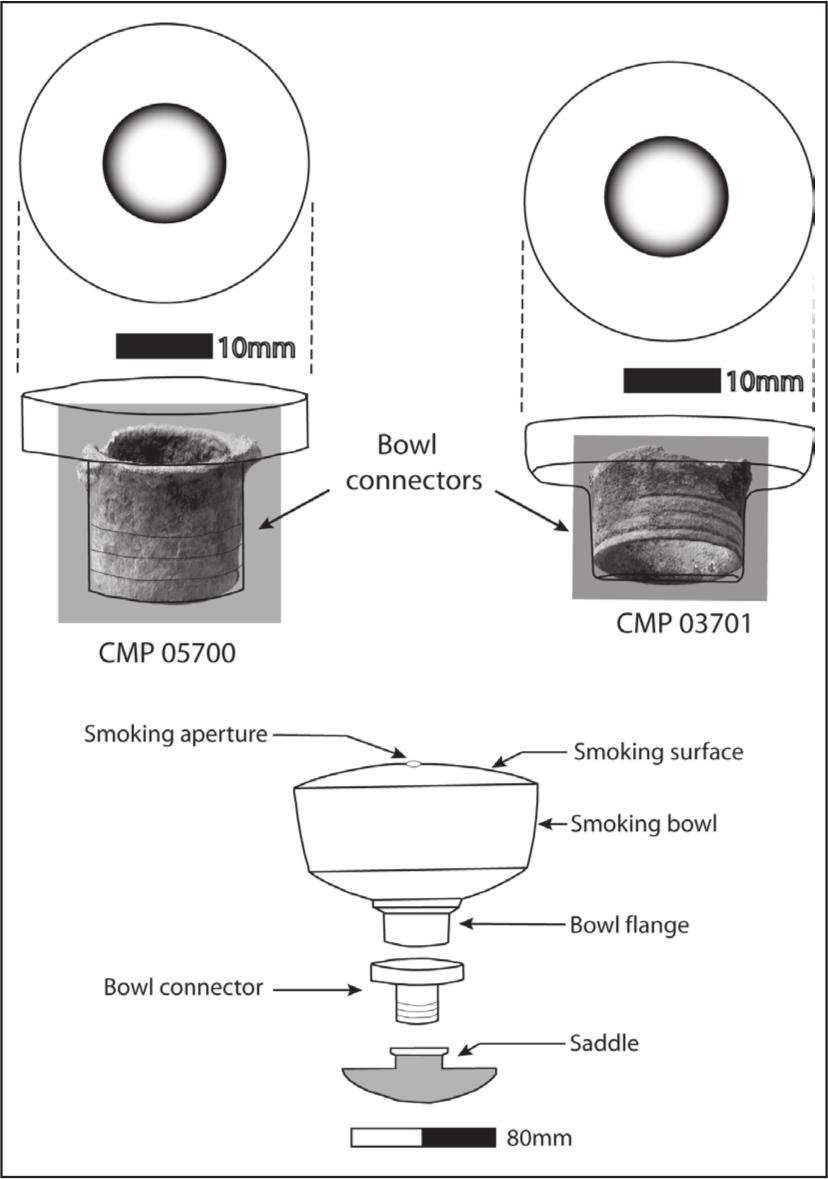
Figure 6.48 Opium-bowl connectors from the Chinaman’s Point site (top) and diagram showing the connector’s position between bowl and saddle.
Opium-lamp cover
Opium lamps comprise four archaeologically recoverable components: a base, a globular fuel reservoir, a wick support and a lamp cover (figure 6.49). An opium lamp’s purpose is to provide a constant source of heat through an enclosed flame first to heat and then smoke opium – opium lamps also provided a source of light.
The minimum number of opium-lamp covers (table 6.23) was determined through upper rim/neck sections. Four fragments are of clear glass, one has a purple tinge and the remaining 14 are aqua-green. Five fragments were excavated from the base of the gutter system in area 3 and the remainder were recovered from the site’s tidal zone. Lower portion body diameters are unavailable due to the broken pieces. All upper rim sections have a 35 mm outside diameter and range from 1 to 5 mm in neck length – from shoulder to upper rim (figure 6.50).
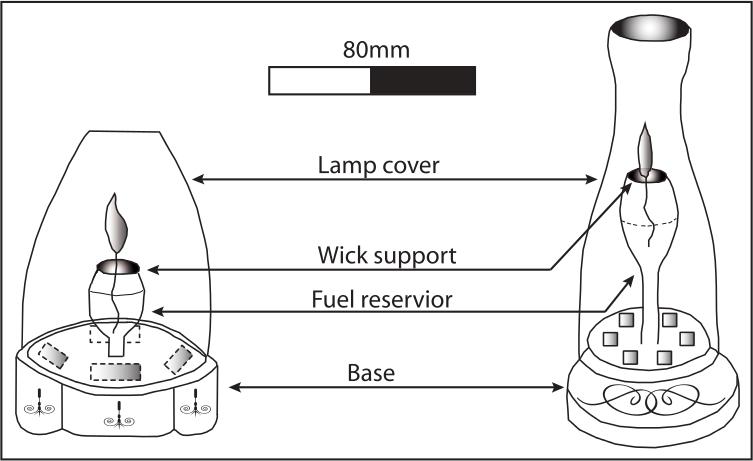
Figure 6.49 Two typical opium-lamp types.136
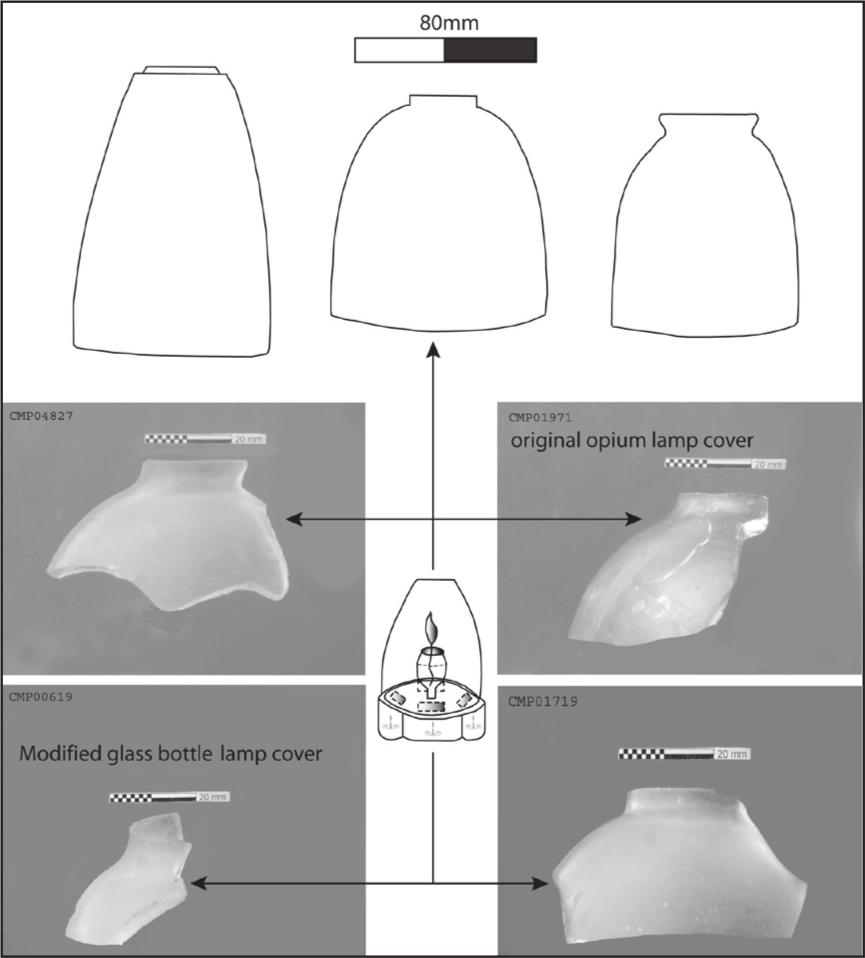
Figure 6.50 Three typical opium-lamp shades (top) and four opium-lamp shade fragments (bottom) from the Chinaman’s Point site.
Wylie & Fike (1993: 288) report that glass opium lamps recovered from sites in the United States were probably manufactured in Birmingham, England and then transported to China before going to the United States. The same is probably true of opium lamps recovered from Australian sites. Two of the fragments have a smoothly ground rim surface and are likely to have been originally manufactured as opium lamp covers. The recovered fragments that were not originally manufactured as opium lamp covers are modified glass bottle sections. Such modified lamp covers have been noted at many overseas Chinese sites in the United States (Sisson & Harrison 1983: 4; Stapp 1990: 214) and New Zealand (Ritchie 1986: 369). There are two recorded Australian cases, both from sites in the Northern Territory Palmer goldfield region (Jack et al. 1984: 56; McCarthy 1986: 36). However, as both these are bottle base sections (the upper parts were not recovered) there is some doubt over their association with opium-lamp covers. Lamp covers found Ritchie (1986: 391) in New Zealand appear to have been manufactured by using a hot wire placed around the section of bottle that is to be snapped off – i.e. above and below the bottle shoulder. Hot wire placed around a glass bottle weakens the glass around the heated section and if struck enables a clean break along the fault line. This method appears to have been used to manufacture the opium-lamp covers recovered from Chinaman’s Point.
Evidence by Ritchie (1986: 391) indicates that a small reservoir of oil or tallow with a secured wick was positioned inside the glass cover to produce the constant source of heat required to smoke opium.
Alternative smoking method
An opium consumer can obtain the desired analgesic effect through a variety of ways. Opium can be taken orally in pill, liquid, powder or raw form (snorted or mixed with water and injected intravenously), or it can be smoked through an opium pipe as pure resin or mixed with tobacco and smoked in a water or dry pipe or in a cigarette. To smoke opium the preferred Chinese way, the techniques for heating the resin and inhaling the fumes vary greatly. A number of distinctly modified bottle bases that are very likely associated with opium smoking have been identified from three separate archaeological sites in Australia – i.e. at Chinaman’s Point; Little Lonsdale Street/Casselden Place, Melbourne and Cunningham Street, Sydney.
Archaeologist Lance Wackett recalls that approximately 30 of these bottle bases were excavated in 2003 from the Little Lonsdale Street/Casselden Place sites near Melbourne’s Chinatown (Wackett 2006 pers. comm.). At the time of excavation “an old Chinese man” suggested the bases had an association with opium smoking (Wackett 2006 pers. comm.). However, this comment was not followed up at the time and the particular attributes of the bottle bases were not recorded in the artefact catalogue, hampering their retrieval from an assemblage of over 300 000 artefacts just from the Casselden Place collection. Any mention of the modified bases is also absent from the excavation report compiled by Godden Mackay Logan et al. (2004). In June 2006, a physical search – by the author – through a portion of the Little Lonsdale Street/Casselden Place artefact assemblage identified one of these bases.
137A further six such artefacts were recovered by Austral Archaeology in 2004 from the Cunningham Street archaeological excavation in Sydney, an area also historically known to have had a large Chinese presence. The land developer for this project went into liquidation before the archaeological work was finished, therefore the artefact catalogue and archaeological report have not been completed (Wackett 2006 pers. comm.). In Galloway’s examination of archaeological evidence for opium smoking, she noted these bases, provided pictorial evidence and gave an interpretation of how they may have been used in association with opium smoking (2005: 112–13). She states:
the pontil was chipped away to make a small hole and the bases were simply broken from the bottle. There was no uniformity in the length of the bottle sides, some were broken at the base, others further up. They may have been used inverted over a tin of fuel with the wick protruding through the hole. The concave shape of the bottle base may concentrate the heat for cooking the opium.
This suggested method of use seems unlikely because, due to the rough break, the bases would be extremely unstable in an inverted position. It is more likely that they were used in a standing bottle position.
Through comparing the bases from each of the three sites, aspects of uniformity have been noted. For example, each modified base was produced from a dark green (black) glass bottle with a deep push-up section. The bottles’ centre pontil sections have been chipped away to create a hole consistently between 10 and 20 mm in diameter. The broken bottle sides vary in length, but do have some consistency as each has at least one broken section that traverses to the bottle’s base, which in some examples displays a point of impact on the basal rim, clearly indicating a deliberate act of modification (figure 6.51).
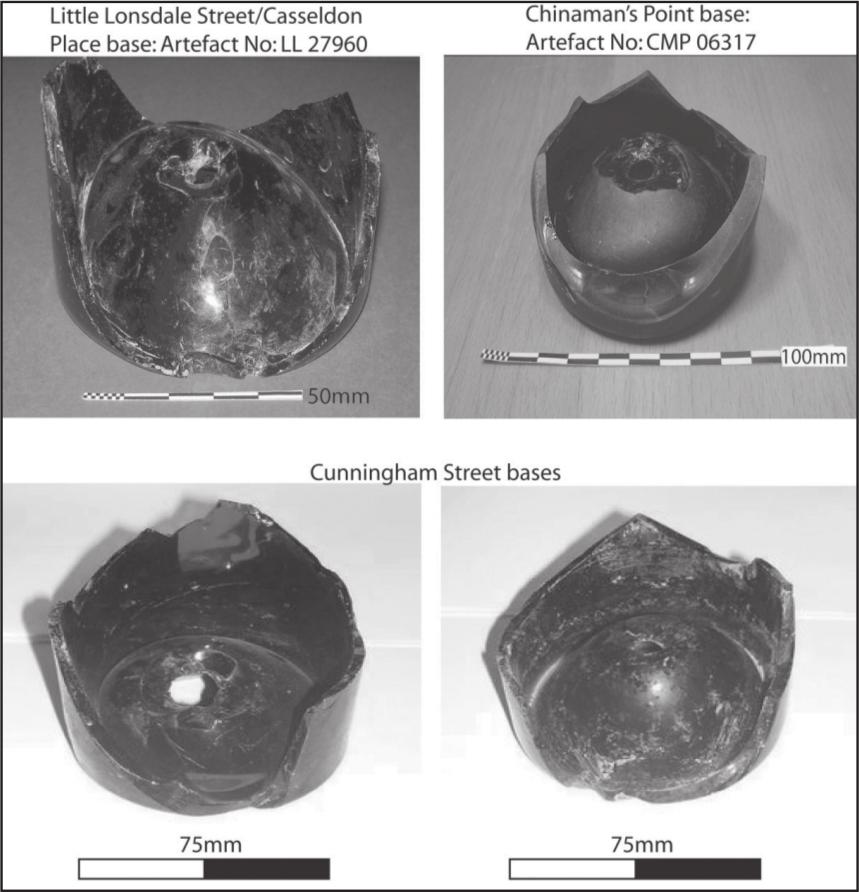
Figure 6.51 Modified bottle bases for the purpose of opium smoking.
An alternative to Galloway’s interpretation is that these artefacts were used in a process called ‘chasing the dragon’. The term ‘chasing the dragon’ is presently associated with the smoking of heroin, a powdered derivative of opium. When heroin powder is placed on tin foil and heated from below, it turns a sticky brown and gives off smoke fumes. As thick plumes of smoke fumes rise – giving the appearance of a mythical flying Chinese dragon – they are followed (chased) by the smoker and inhaled through a rolled-up newspaper, magazine or other tube-type object, hence the term ‘chasing the dragon’ (www.biopsychiatry.com/heroin.htm). This same method can be used to smoke marijuana hashish resin and would also be suitable for smoking opium resin, which is very similar in appearance and consistency.
In the absence of a complete traditional Chinese opium smoking pipe and associated implements, the modified bottle bases would have made a very effective alternative for ‘chasing the dragon’. A small oil lamp or candle could be placed under a base with the flame protruding through the hole. A piece of metal such as a reinforcing strip from an opium can (figure 6.53 below) or a ‘funs tray’ (figure 6.54 below) with opium placed on it could be suspended across the broken bottle sides and heated by the central flame. The section where the bottle sides are broken to the base level would provide easy hand access to position the metal support and opium. Once the opium resin became hot enough to produce smoke, ‘chasing the dragon’ could begin (figure 6.52). The cost to produce one of these smoking devices would be minimal, they are robust and could be reused indefinitely. This functional explanation is, however, speculative and open to further interpretation. 138
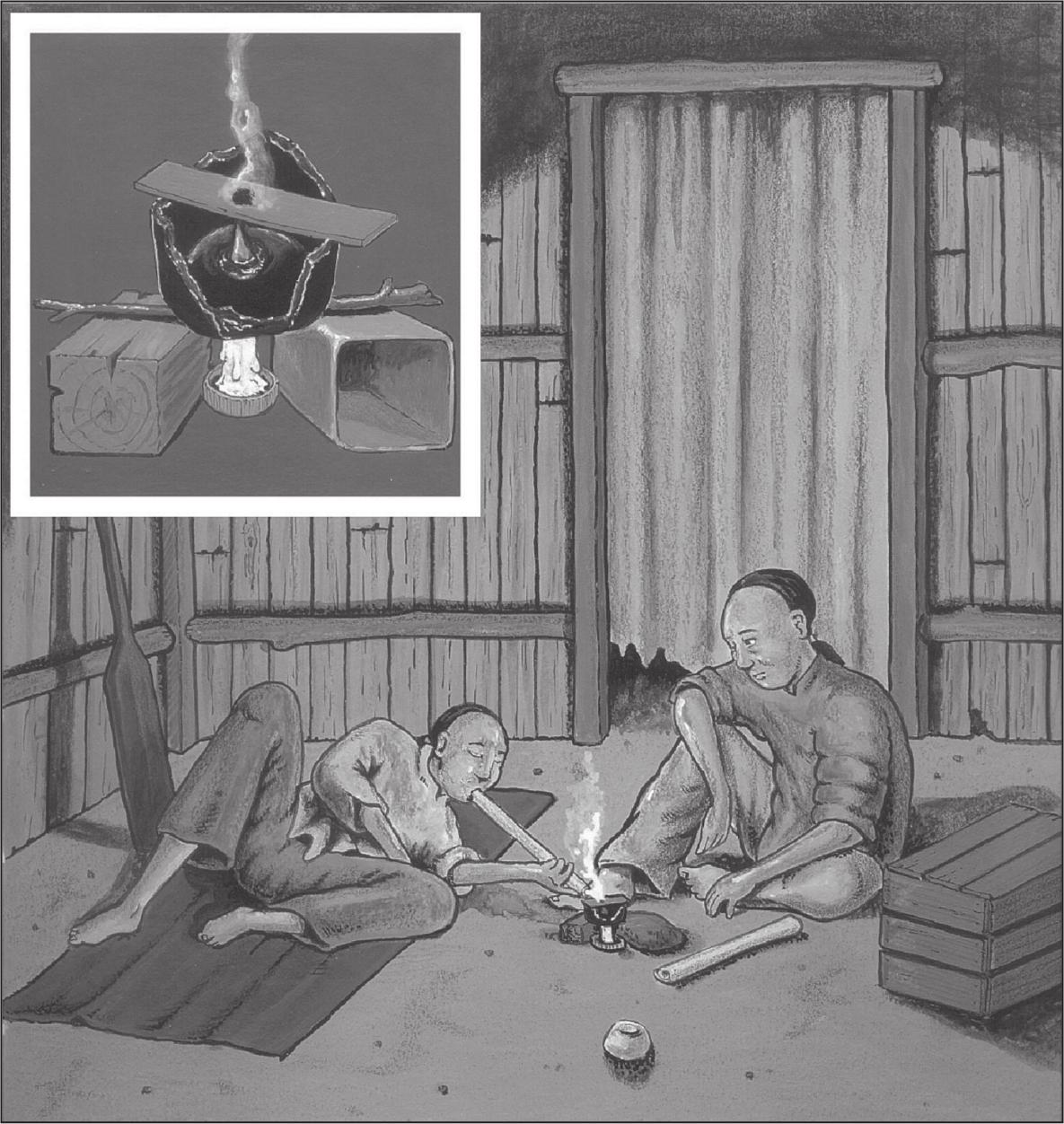
Figure 6.52 Potential method of modified bottle-base use. Painting by blaked beans design 2007.
Opium can
Opium for smoking was usually exported from China to Australia by the can. With the appearance and consistency of thick molasses (Wylie & Fike 1993: 261), a can contained approximately 186.5 g of opium (Ritchie 1986: 378). Several grades of opium were available, according to the quality of the morphine content and taste when smoked (Wylie & Higgins 1987: 322). In Australia, Jack et al. (1984: 53) and McCarthy (1986: 42) have recorded opium can remains at overseas Chinese sites in the Northern Territory; Smith (2003: 27; 2006: 996) has noted their occurrence in assemblages from New South Wales; Chandler (2005: 62–63) located opium cans in a private collection in Victoria’s Upper Ovens district; opium cans were found at Dolly’s Creek in Victoria (Lawrence 2007 pers. comm.) and Gaughwin (1995: 235) recovered opium cans from Chinese sites in north-eastern Tasmania. When complete, opium cans typically measure 95 mm tall and 66 by 41 mm in base proportion (Ritchie 1986: 378; Sando & Felton 1993: 167). Made from lightweight brass, they are usually recovered in the form of crushed or segmented containers. Ritchie (1986: 378) gives the best indication of their manufacture, stating that 0.2 mm thick brass sheeting – frequently with impressed Chinese characters on the lid and base – was bent, folded and soldered together to form the base, body and lid sections. A heavier 0.5 mm thick reinforcing strip was used as a rim to seal the interior of the can (figure 6.53). Opium cans are also often recovered with pasted orange Chinese paper labels (Ritchie 1986: 378).
The minimum number of opium cans (table 6.23) was estimated through linear measurements of interior reinforcing strip seals. One section of opium cans was excavated from area 4 and the remainder were recovered from the tidal zone. Six crumpled corner can sections were recovered, but are not sufficient to obtain accurate measurements of the complete article and show no visible paper labels or Chinese character impressions. Twenty-one pieces of reinforcing strip were recovered, many still showing traces of the solder that once secured them to the opium can. The strips are 0.5 mm thick, between 7 to 14 mm wide and of various broken lengths, the longest measuring 50 mm. Two of the reinforcing strips display modification in the form of nail holes and others appear to have been deliberately cut with snips. The purpose of these post-manufacture modifications are unknown, however as noted by Ritchie (1986: 387–90), empty opium cans were often modified, for example to make ‘funs trays’ used to hold a portion of opium (figure 6.54), brass strip ties (similar to a modern day tie-tag), gambling tokens, brass washers, brackets, candleholders, funnels and lamp-wick holders. 139
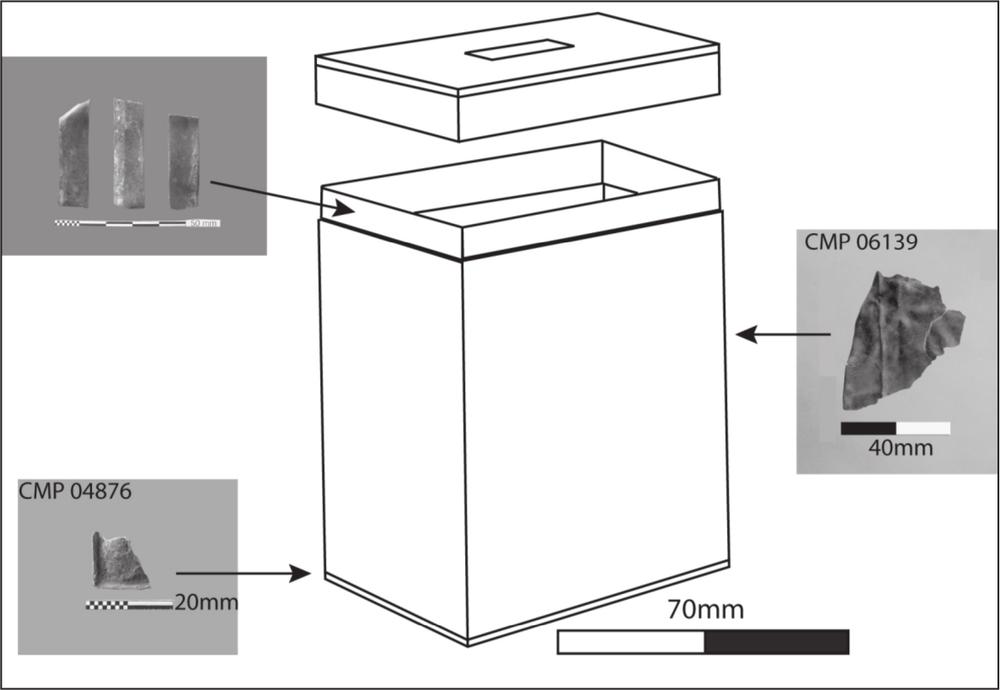
Figure 6.53 Reinforcing strips (top left) and other opium-can pieces from the Chinaman’s Point site.
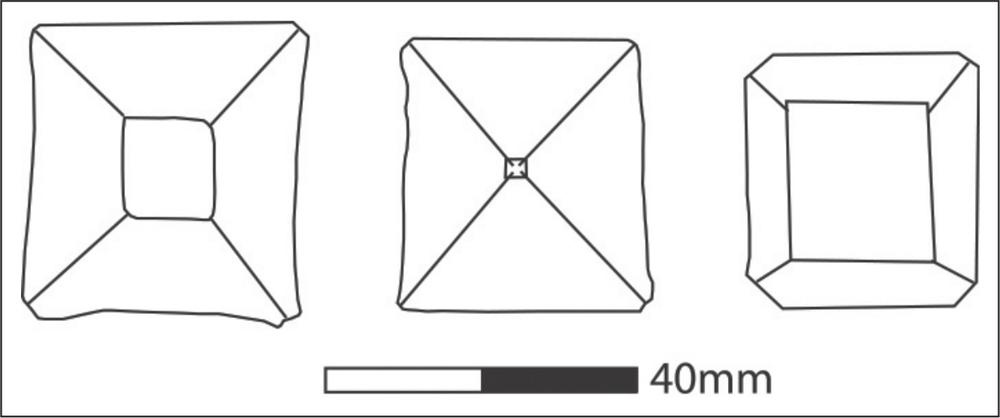
Figure 6.54 Opium cans modified into ‘funs trays’, used to hold a portion of opium. Drawing after Ritchie 1986: 389.
UNIDENTIFIED
There are several items recovered from Chinaman’s Point whose purpose cannot be determined. The largest group of these are the heavily corroded nondescript metals, likely to be predominantly pieces of cask hoop-iron. Typically in the form of small, flat, thin, corroded metal fragments, it is not possible to determine their original function. These represent 8155 pieces, weighing 16.229 kg. A sample of 150 pieces, weighing 204 g has been retained and subjected to a conservation program to arrest the corroding process and the remainder have been discarded.
Two links of corroded chain, weighing 12.5 g were recovered from the site’s tidal zone. The links have 25 by 30 mm oval dimensions and are made from iron approximately 6 mm thick. These pieces could be associated with either domestic or industrial components of the site, but it is not possible to identify them any further.
Two pieces of leather 4 mm thick and weighing 4.9 g were excavated from area 4 of the site. They were recovered side-by-side in a very fragile condition and appear to have been cut from a larger piece. One piece is 35 by 26 mm and the other is 25 by 20 mm. Their appearance is plain with no holes or deliberate markings. Leather is a very versatile material and these artefacts could have been used at the site in a number of industrial or domestic capacities.
CONCLUSION
Analysis of the industrial and domestic artefacts recovered from Chinaman’s Point shows that a range of activities were performed at the site. Information concerning commercial activities, industrial and domestic equipment used, dietary habits and recreational activities have been ascertained.
140Comparative analysis indicates that the collection represents a fairly typical colonial-period overseas Chinese site that is broadly consistent with historical documentary records. Analysis of the artefact assemblage has provided further comparative data for overseas Chinese sites and, in some cases, has facilitated alternative explanations for overseas Chinese activities. Industrial components from the site leave no doubt that it was a Chinese fish-curing establishment and that the site’s occupants caught fish themselves. The material remains discussed in this chapter form the basis of a general site analysis in the following chapter and facilitate estimates of the period of occupation of the site.